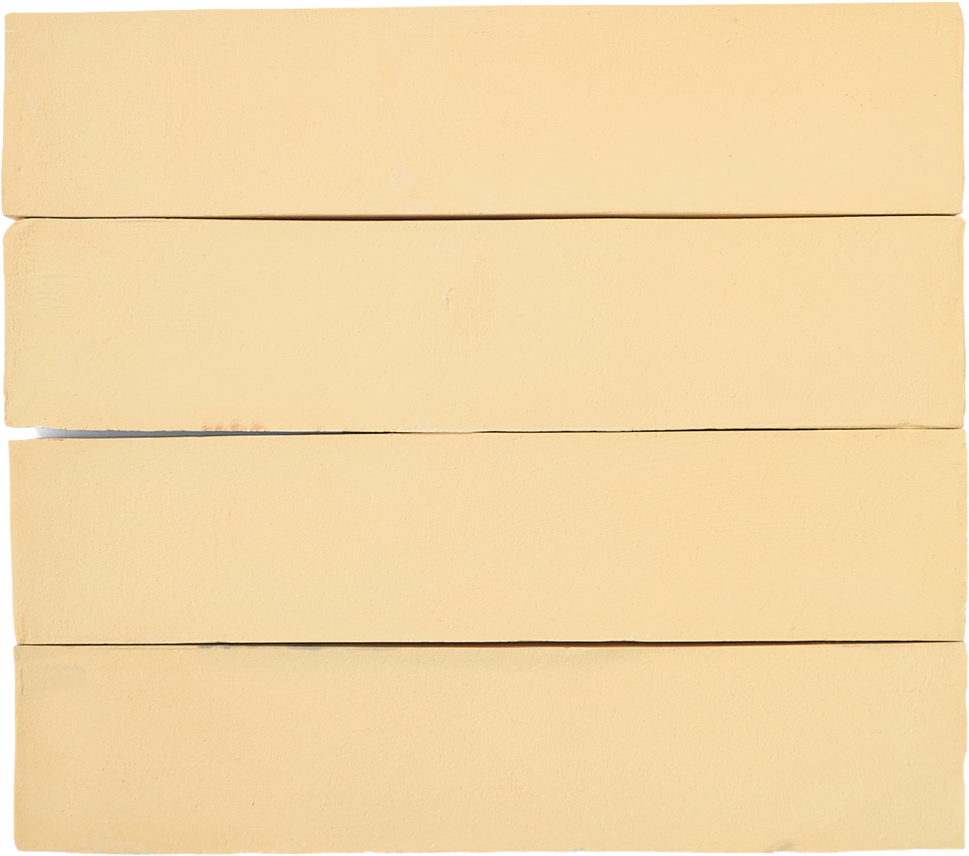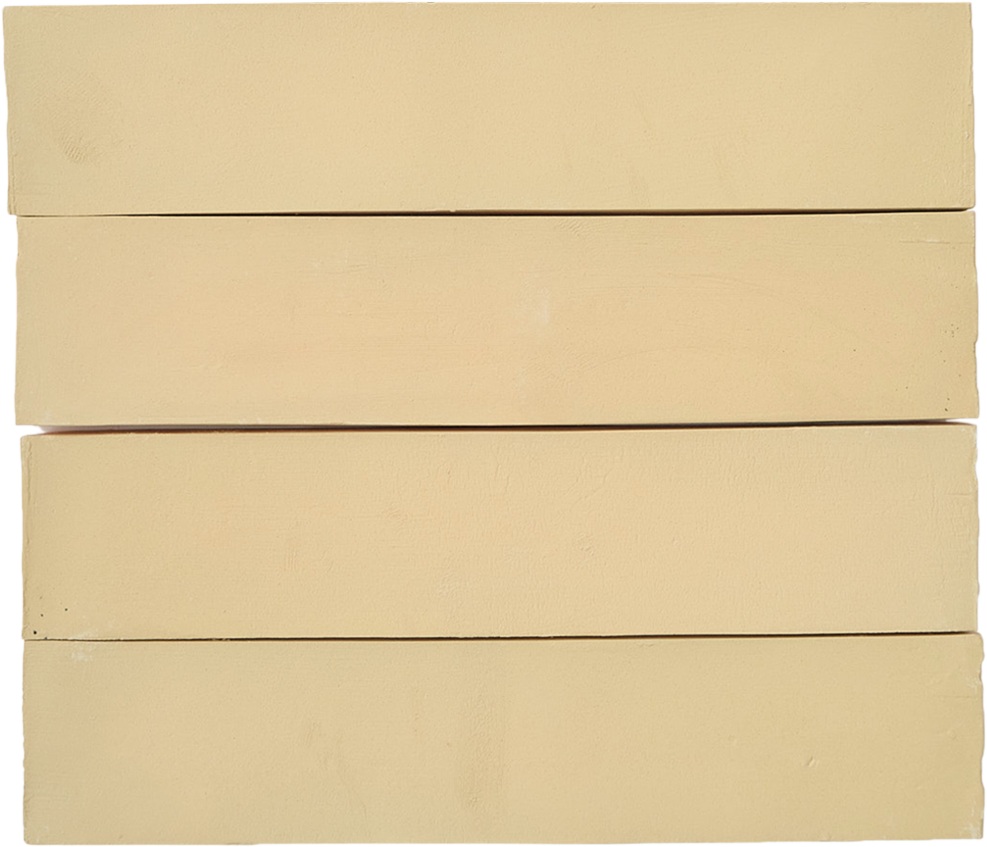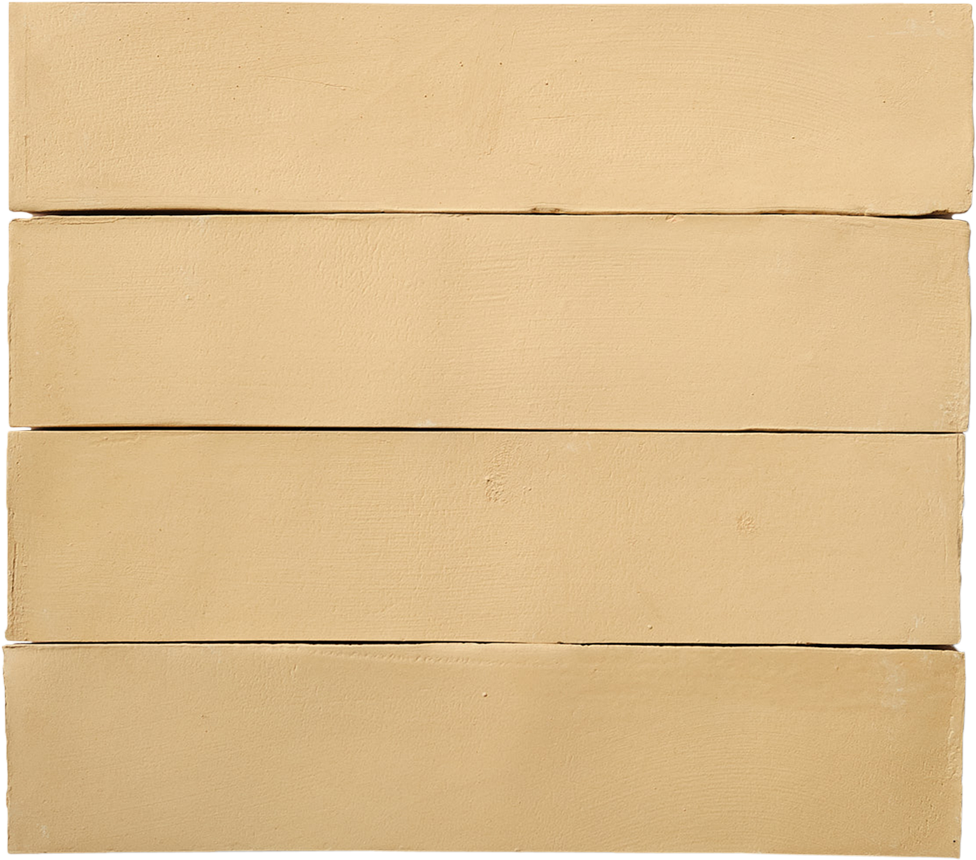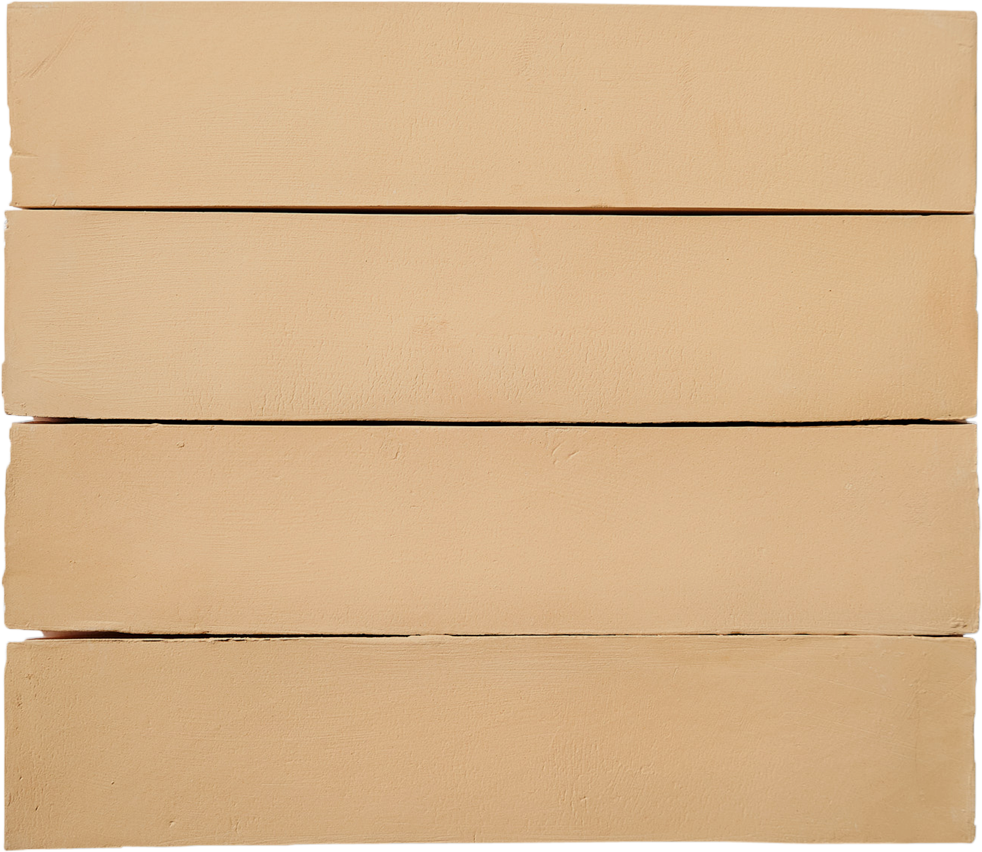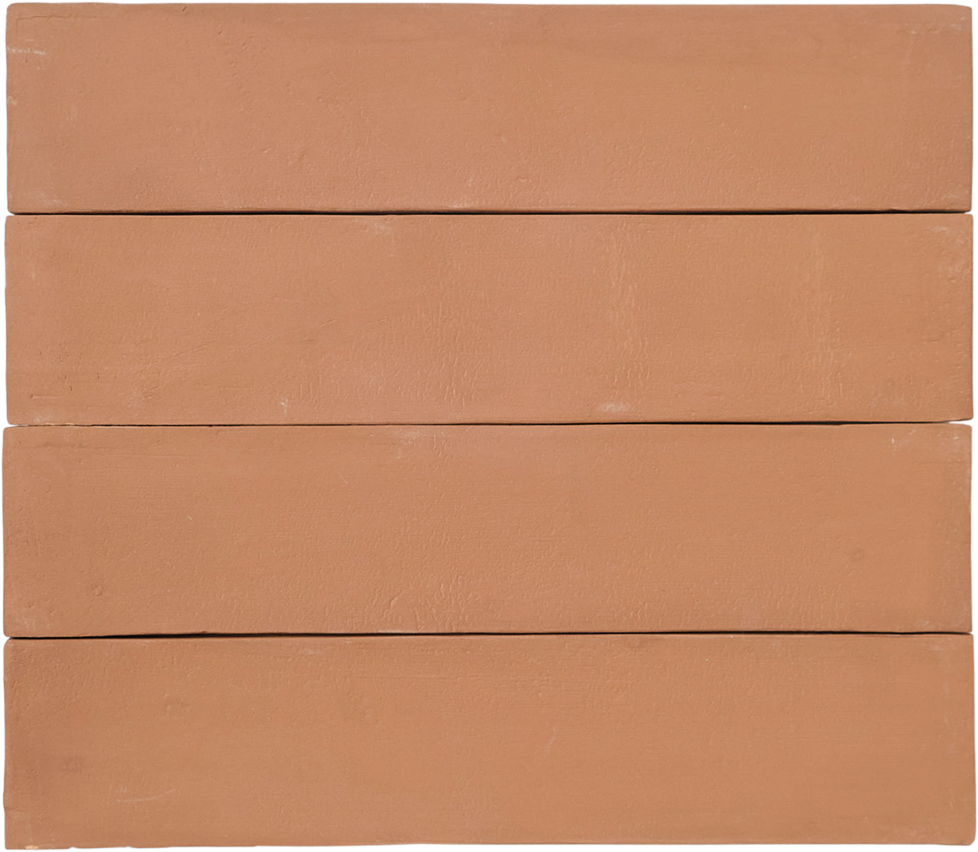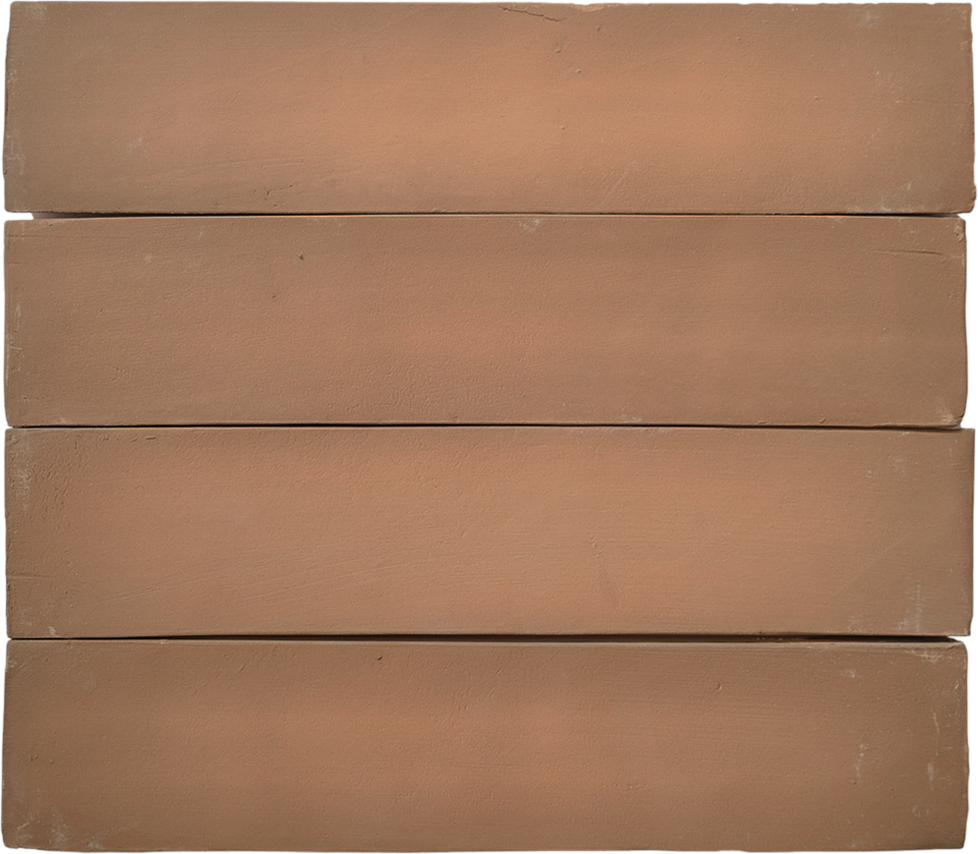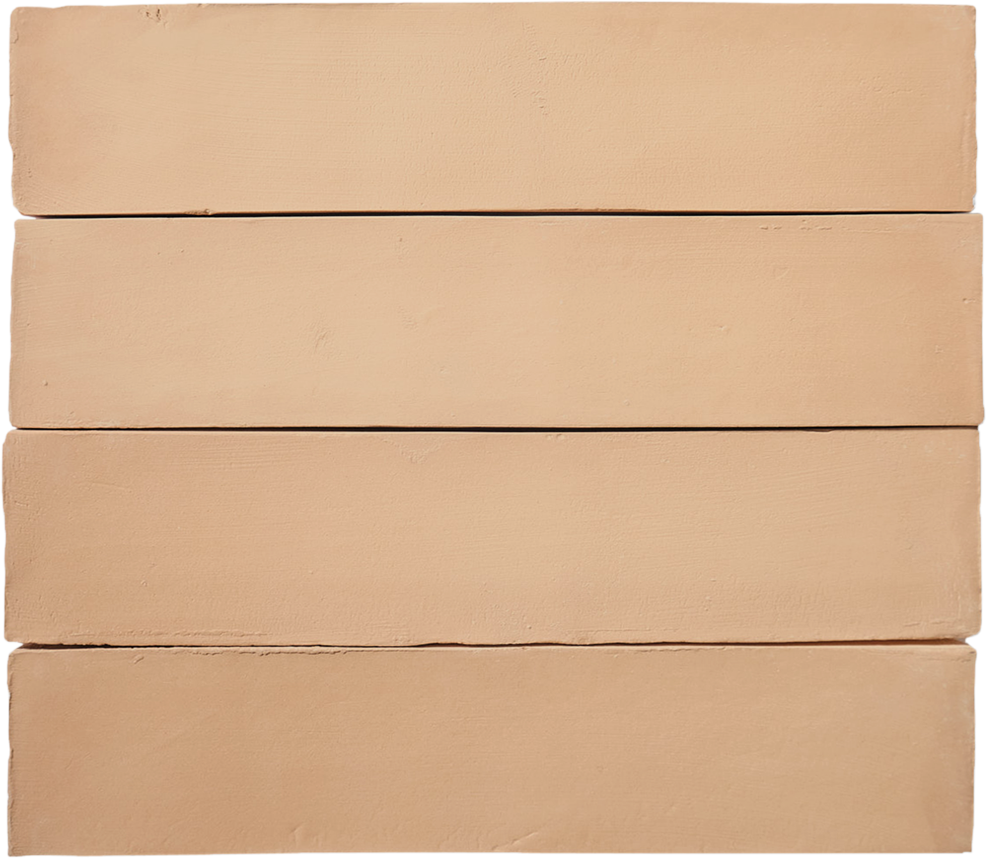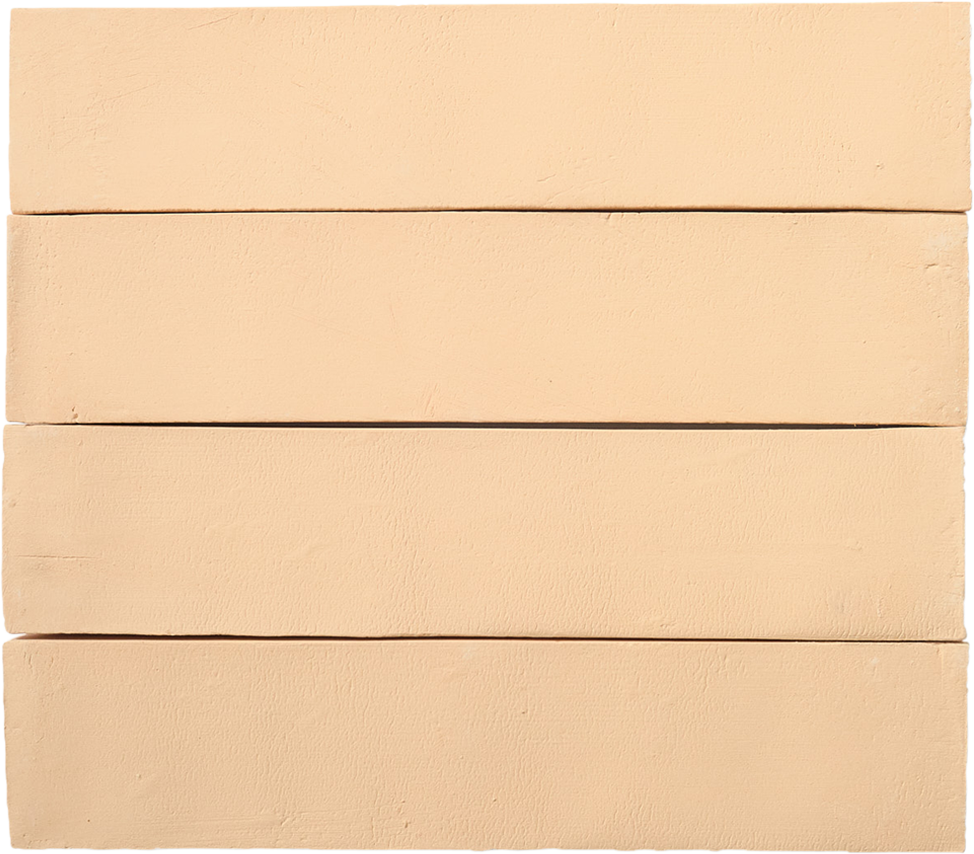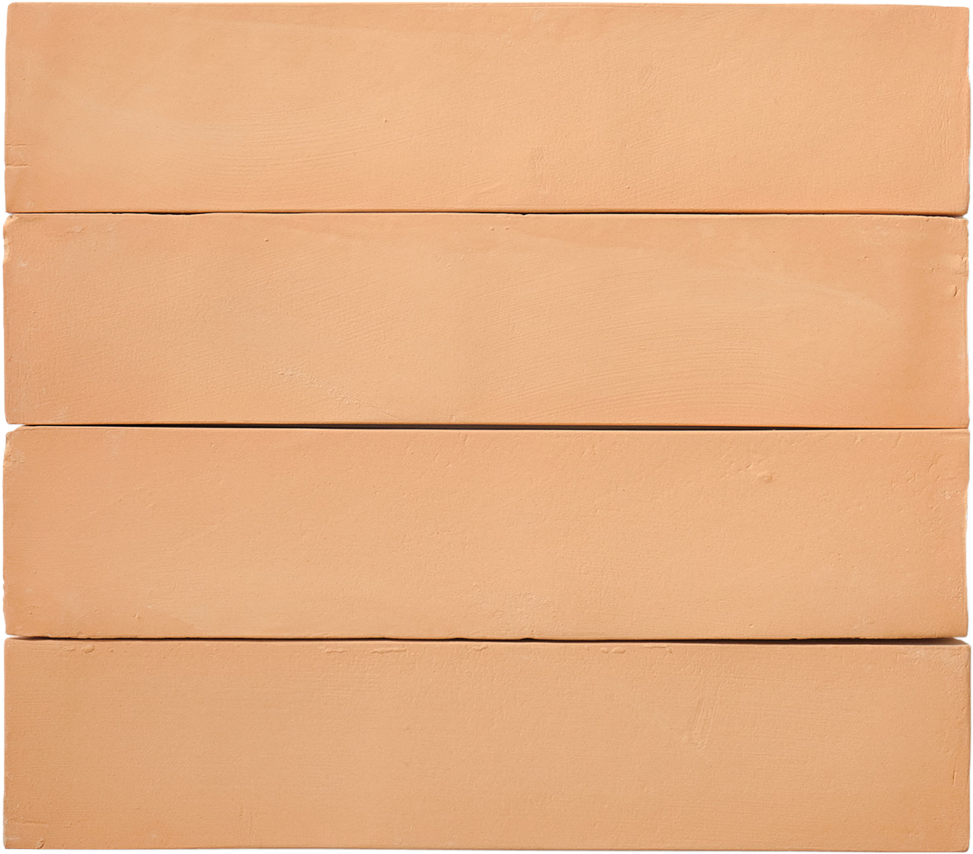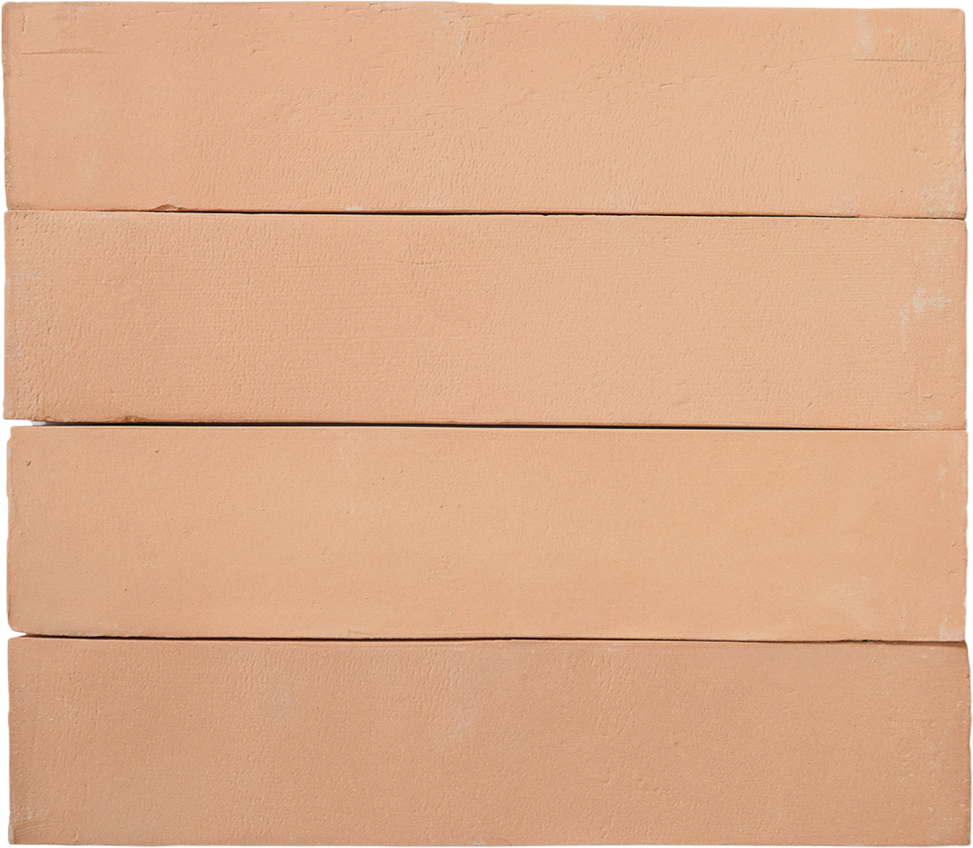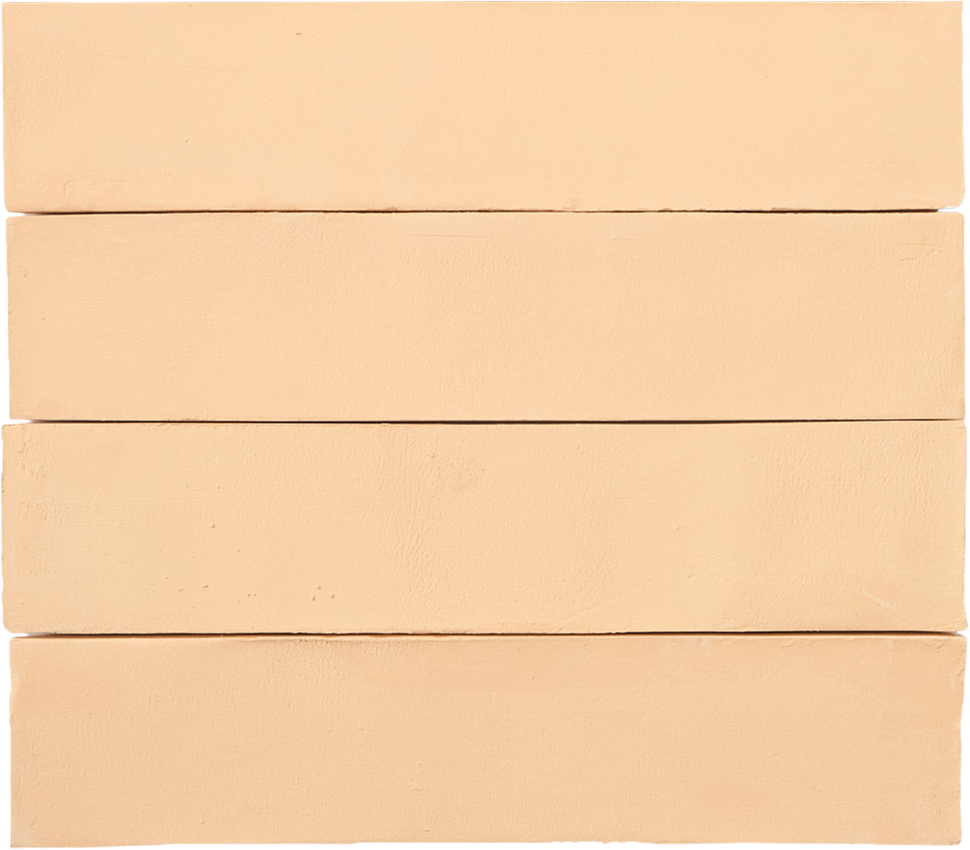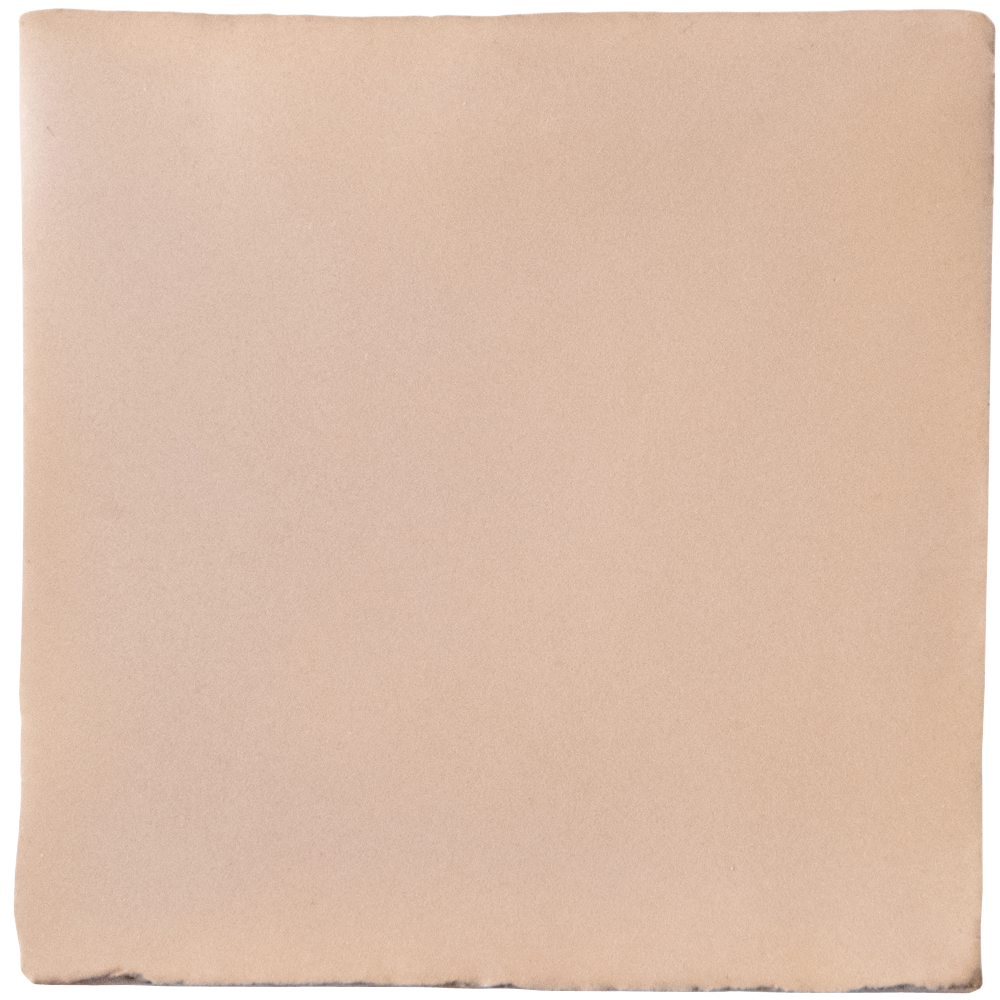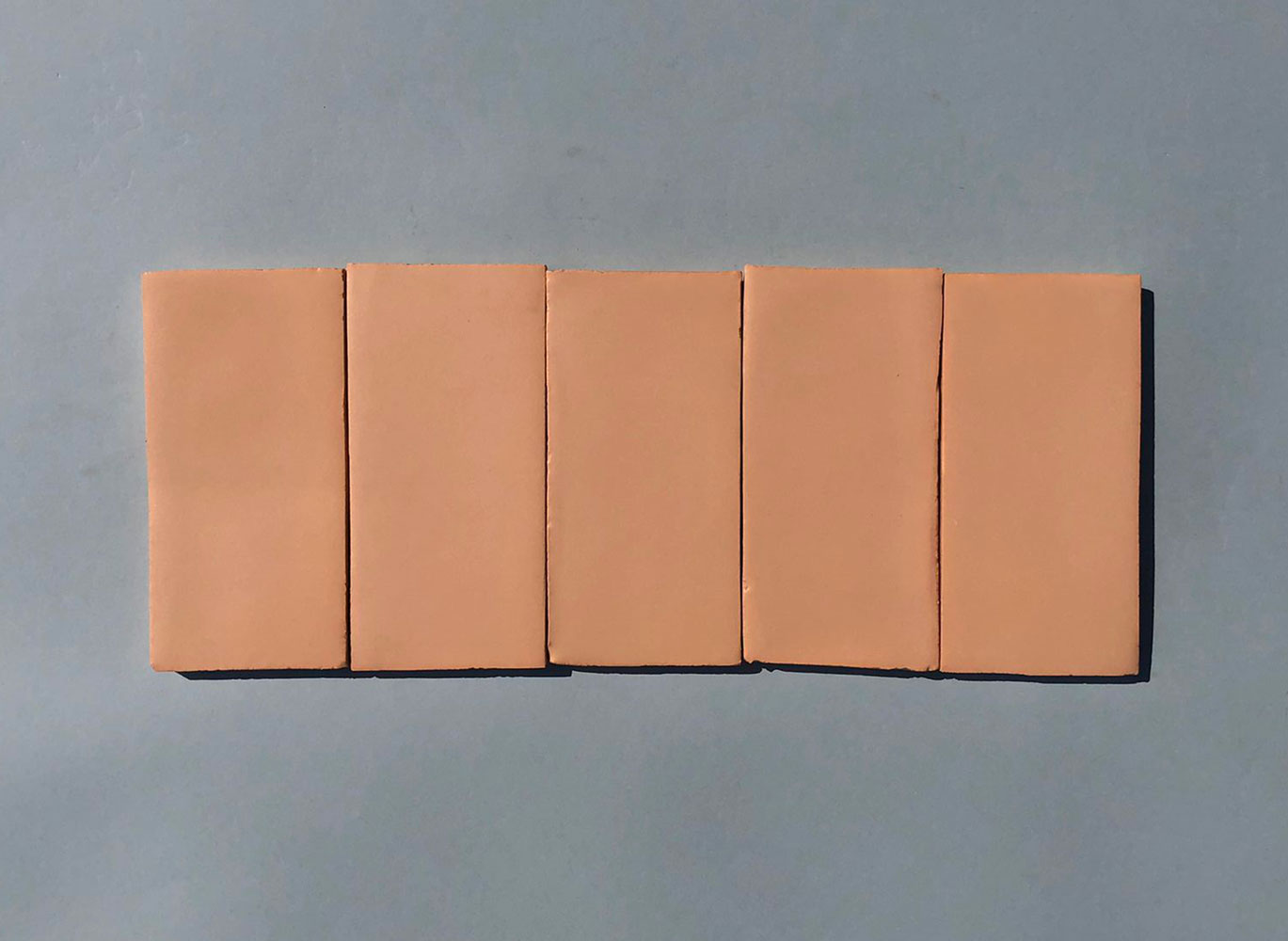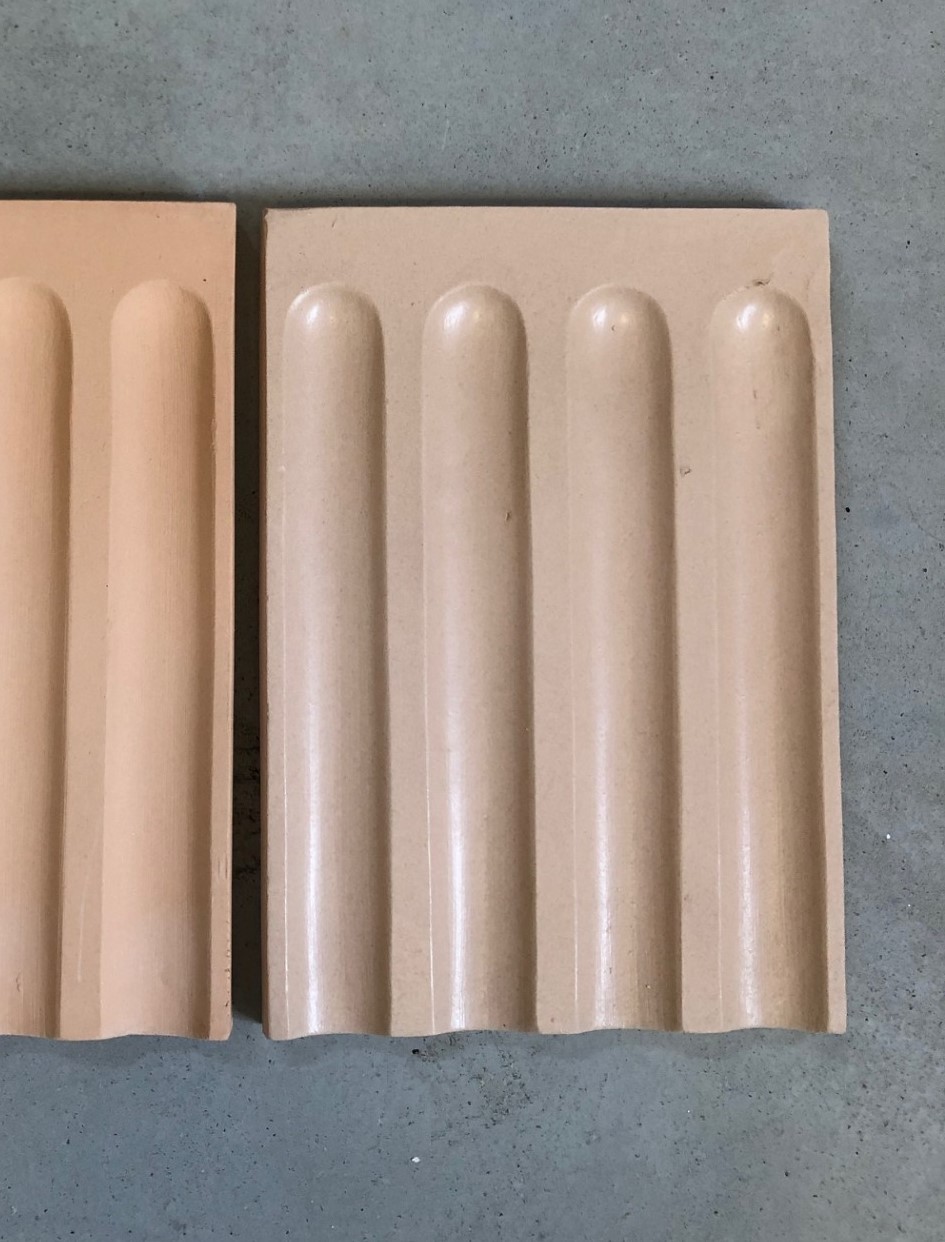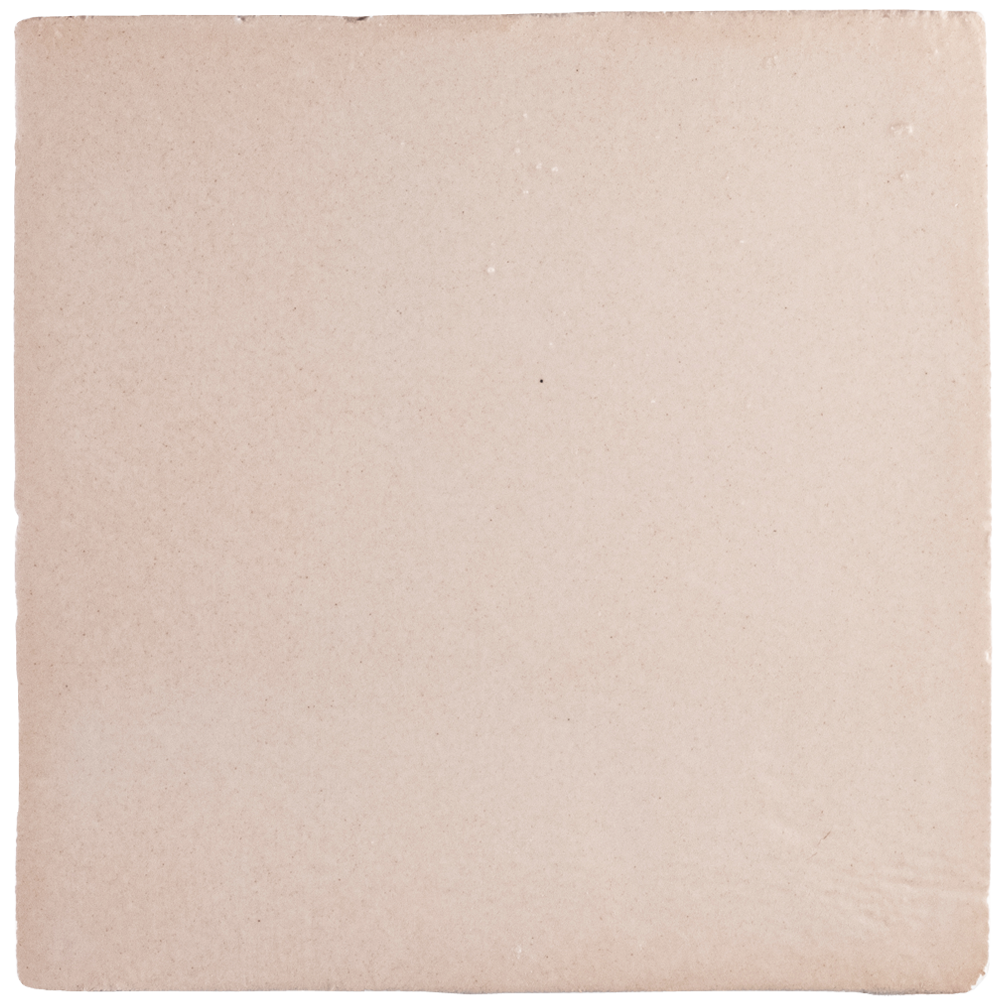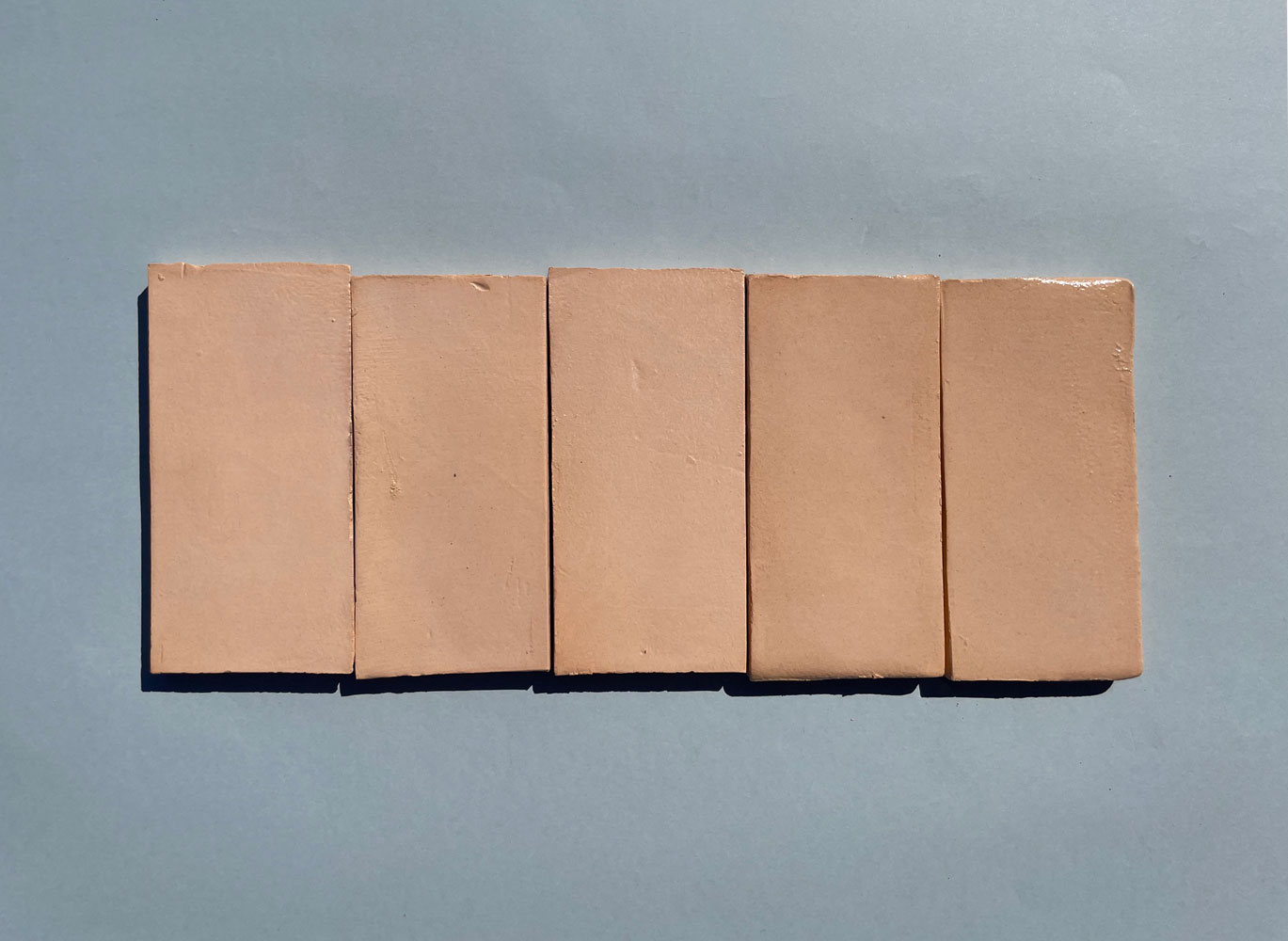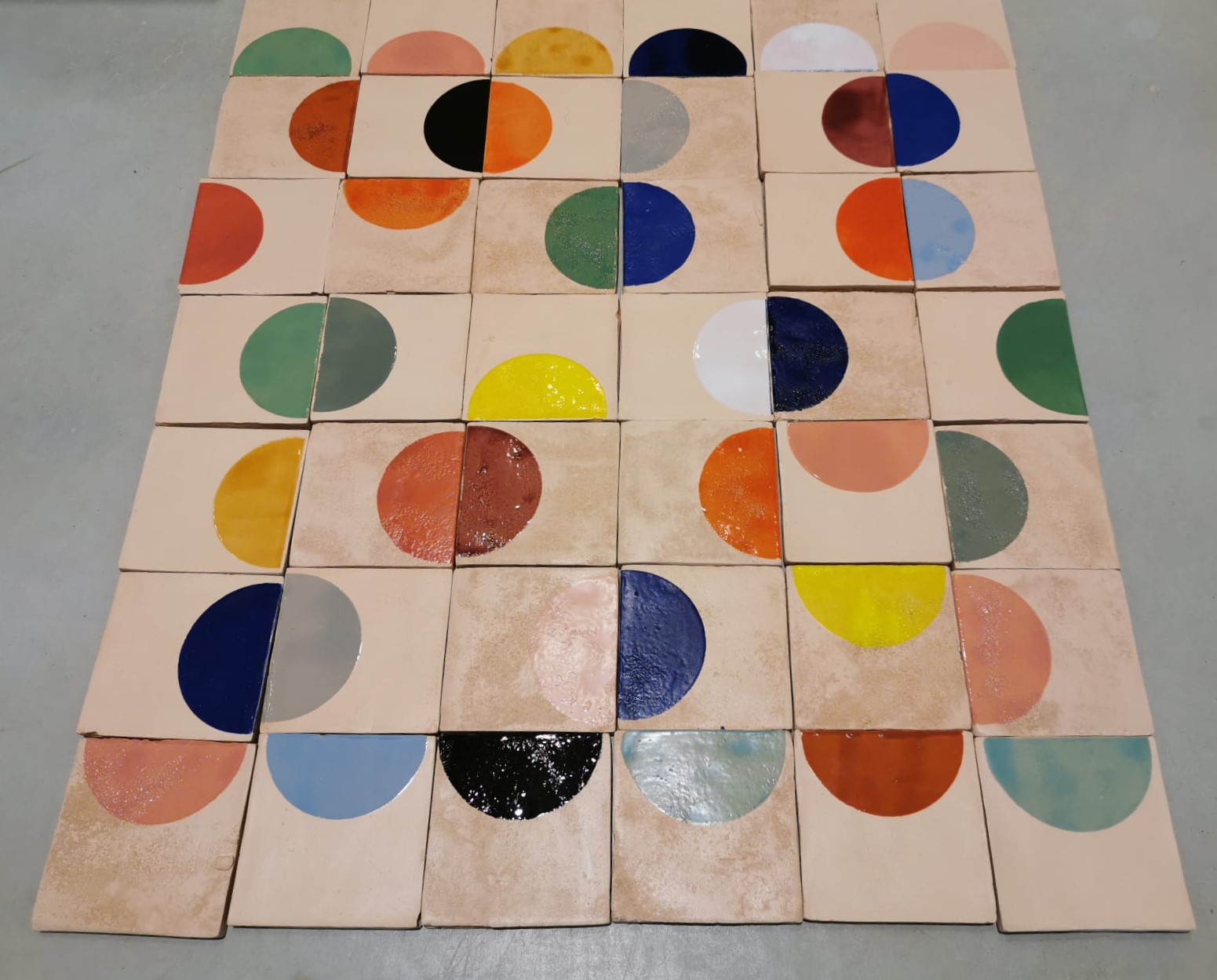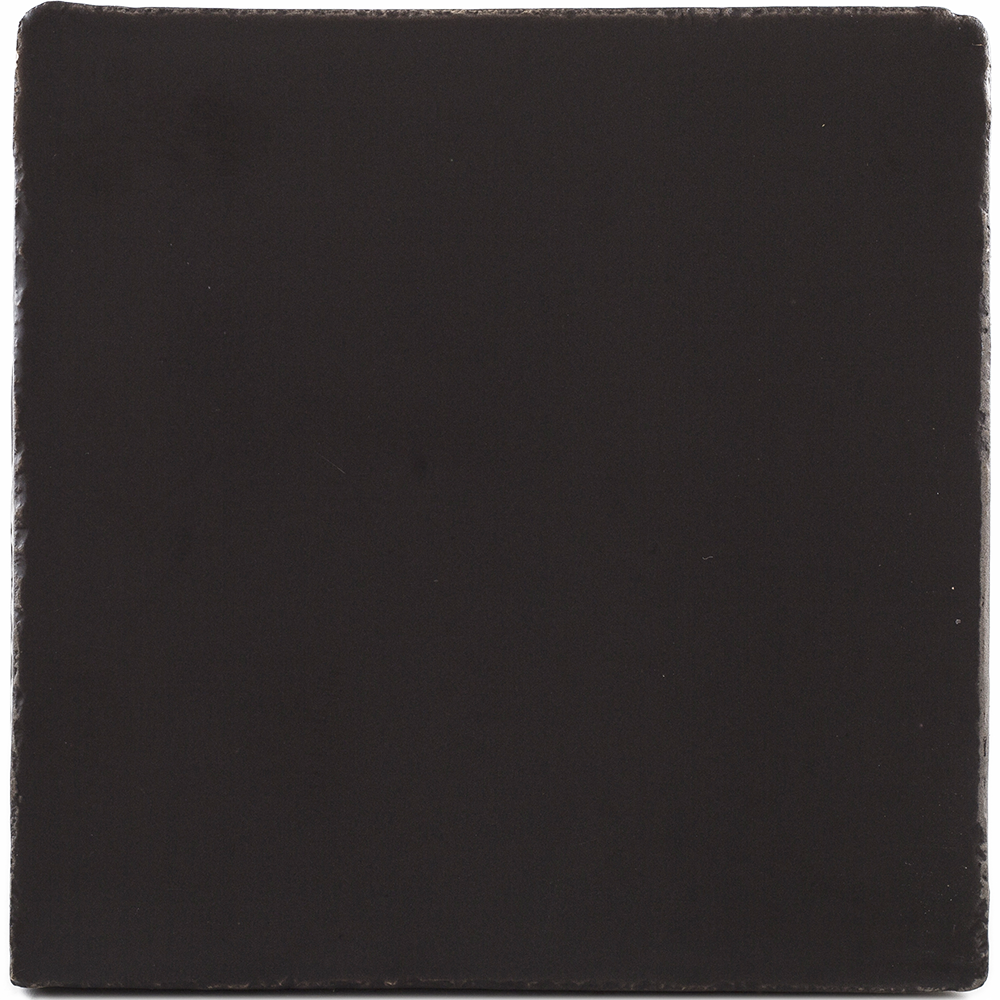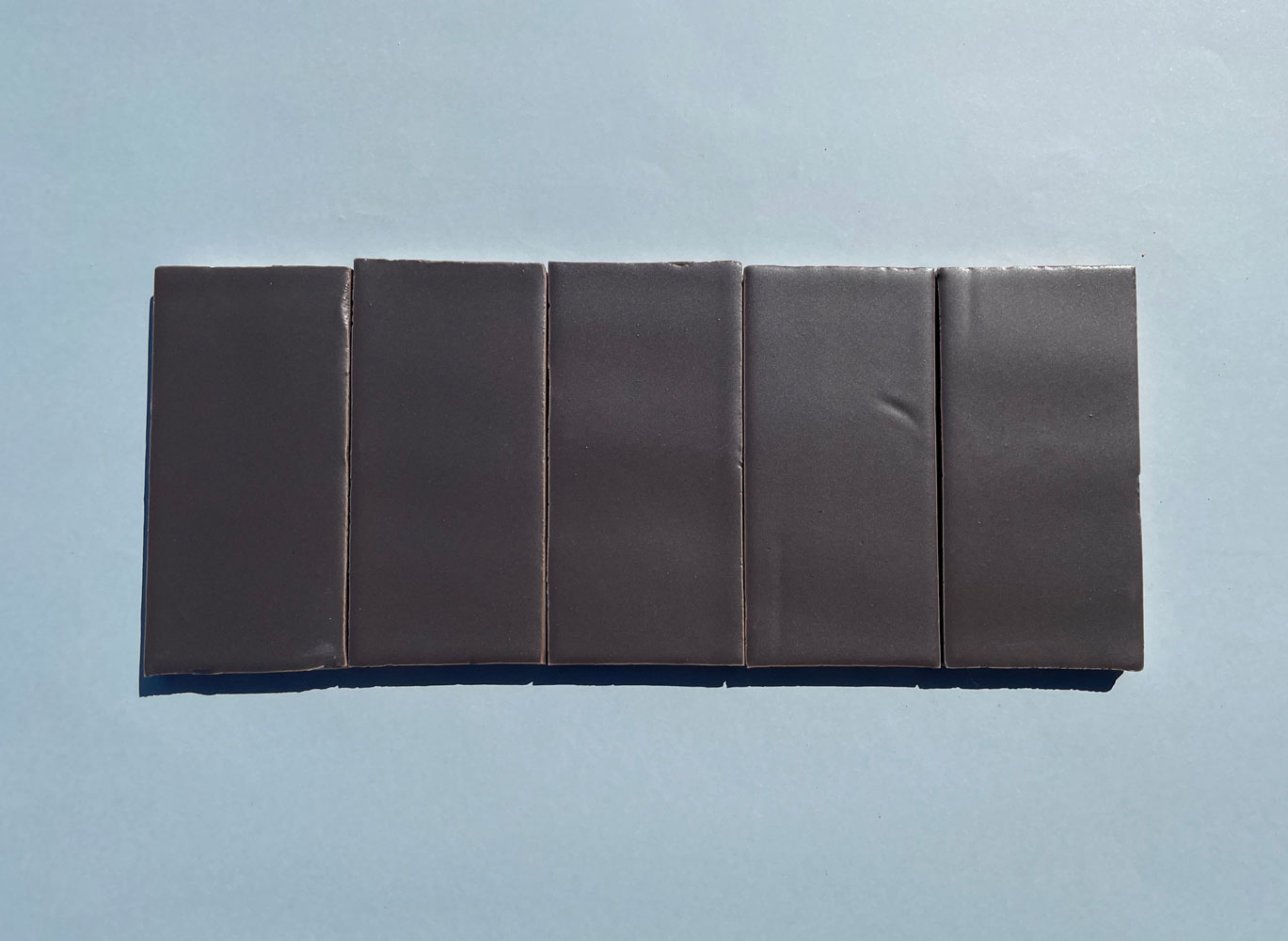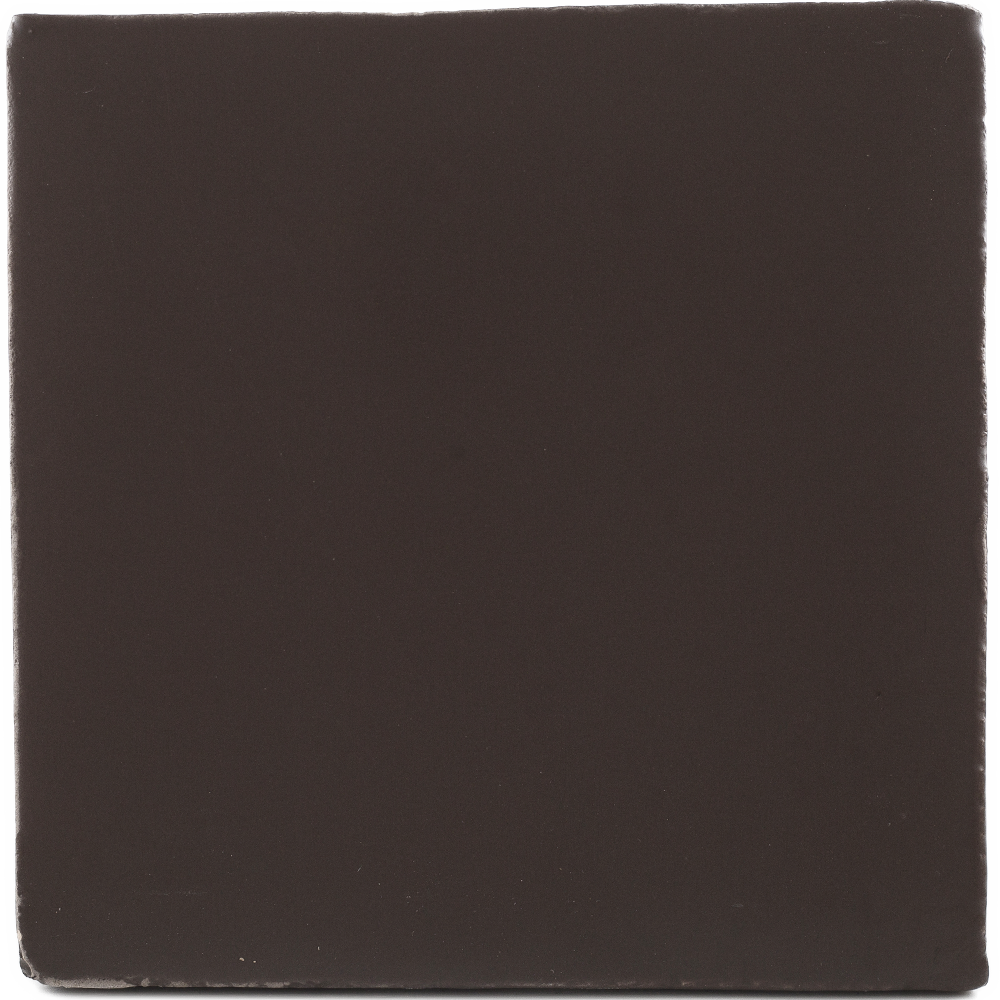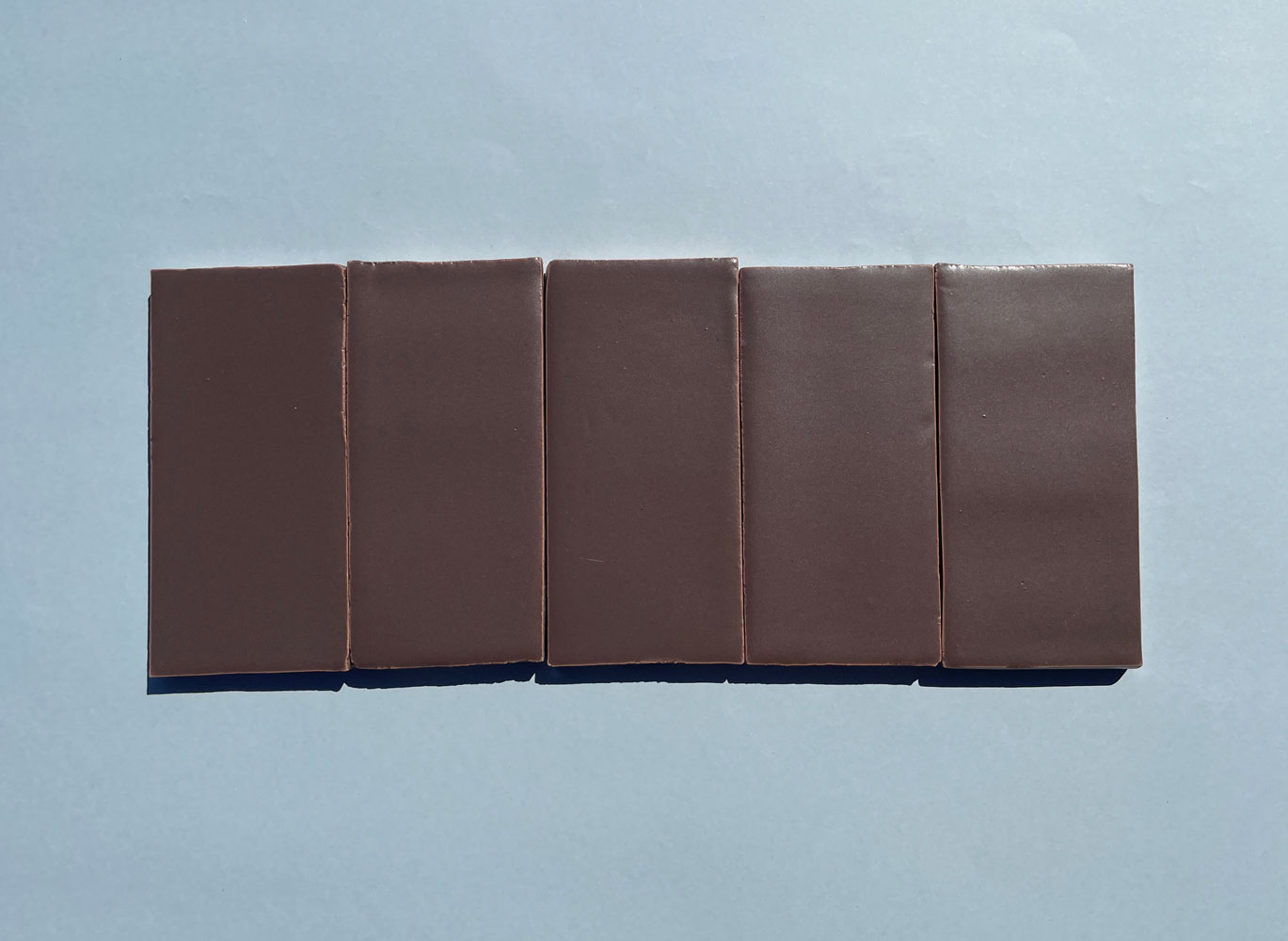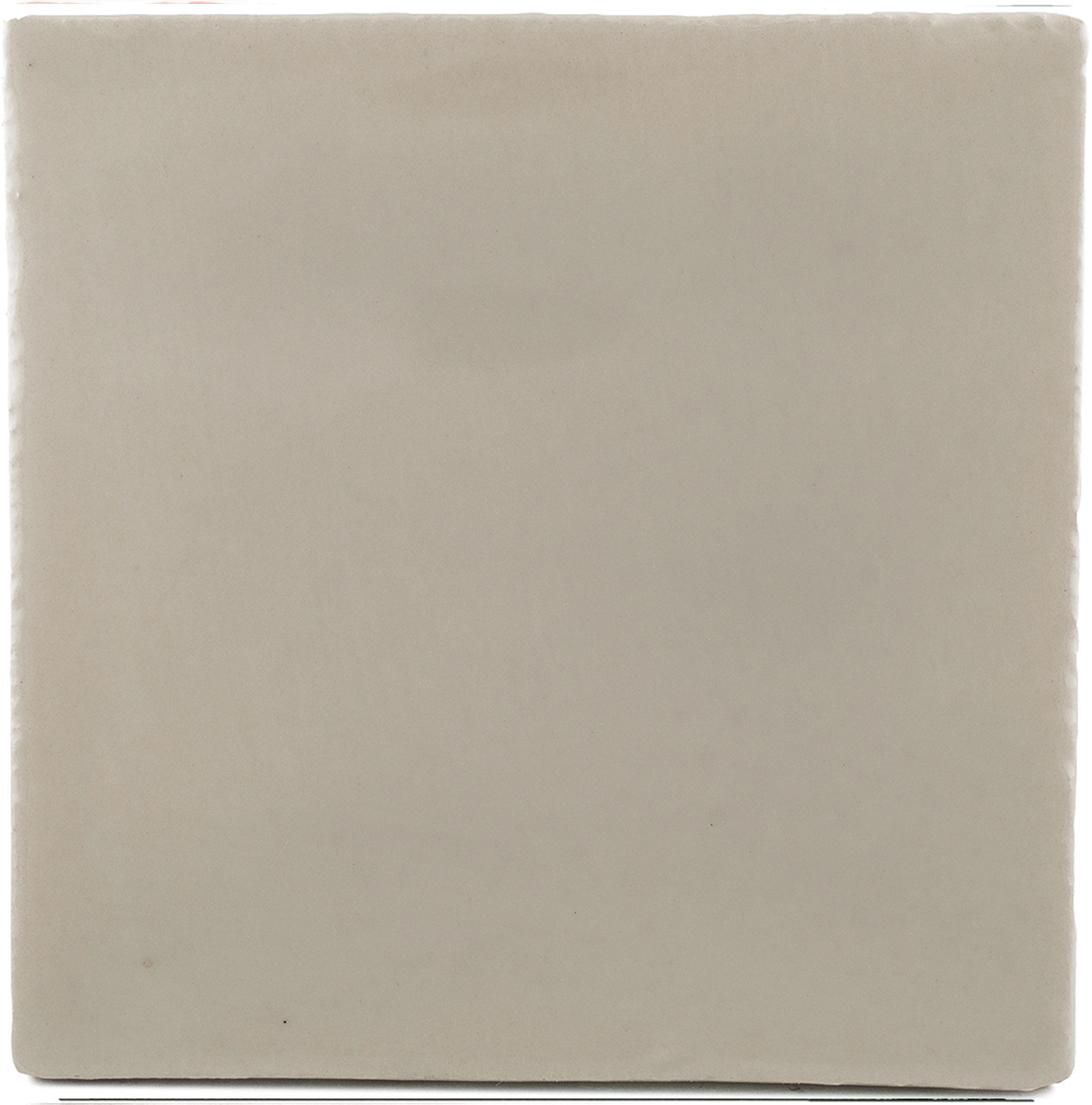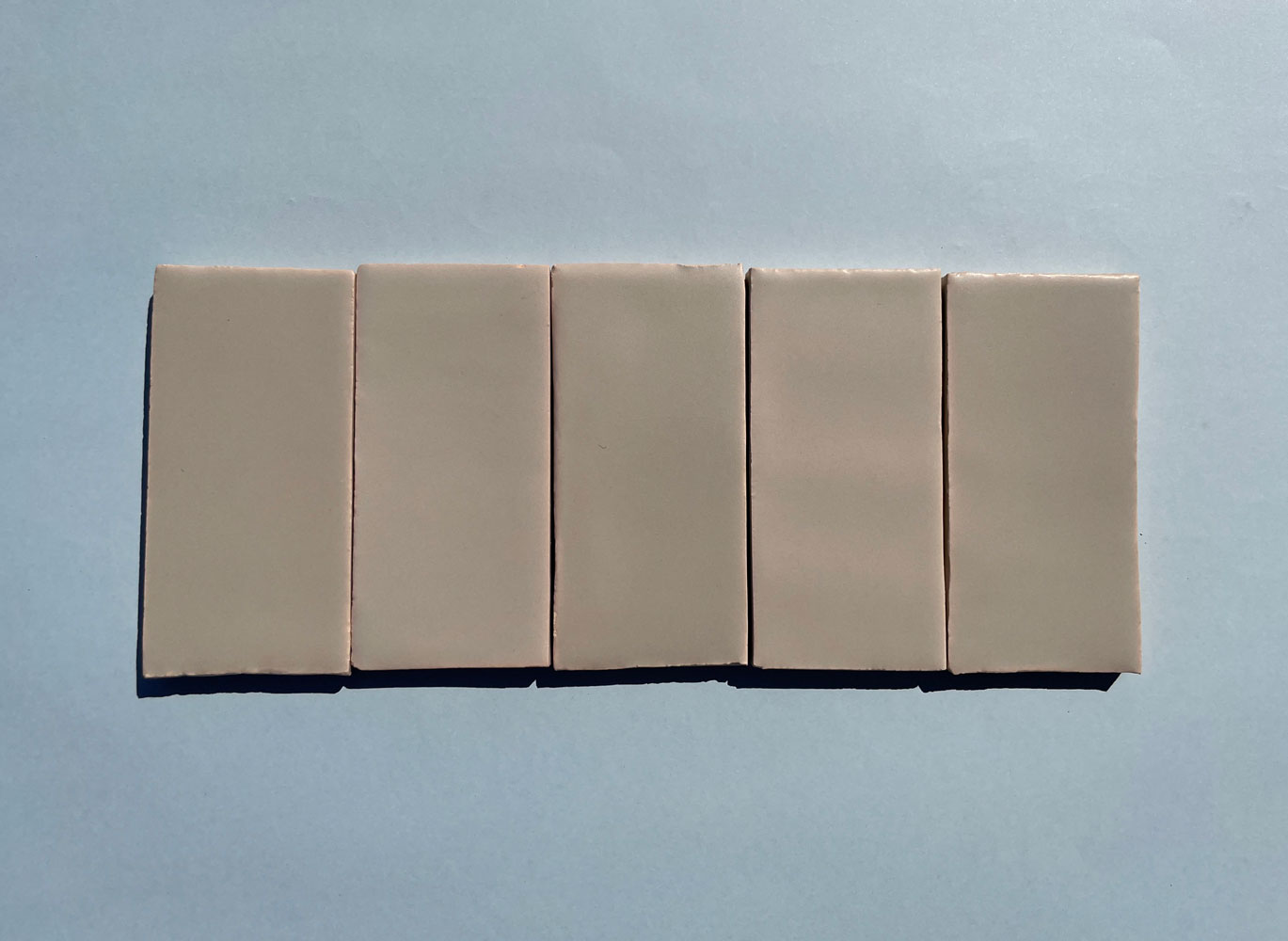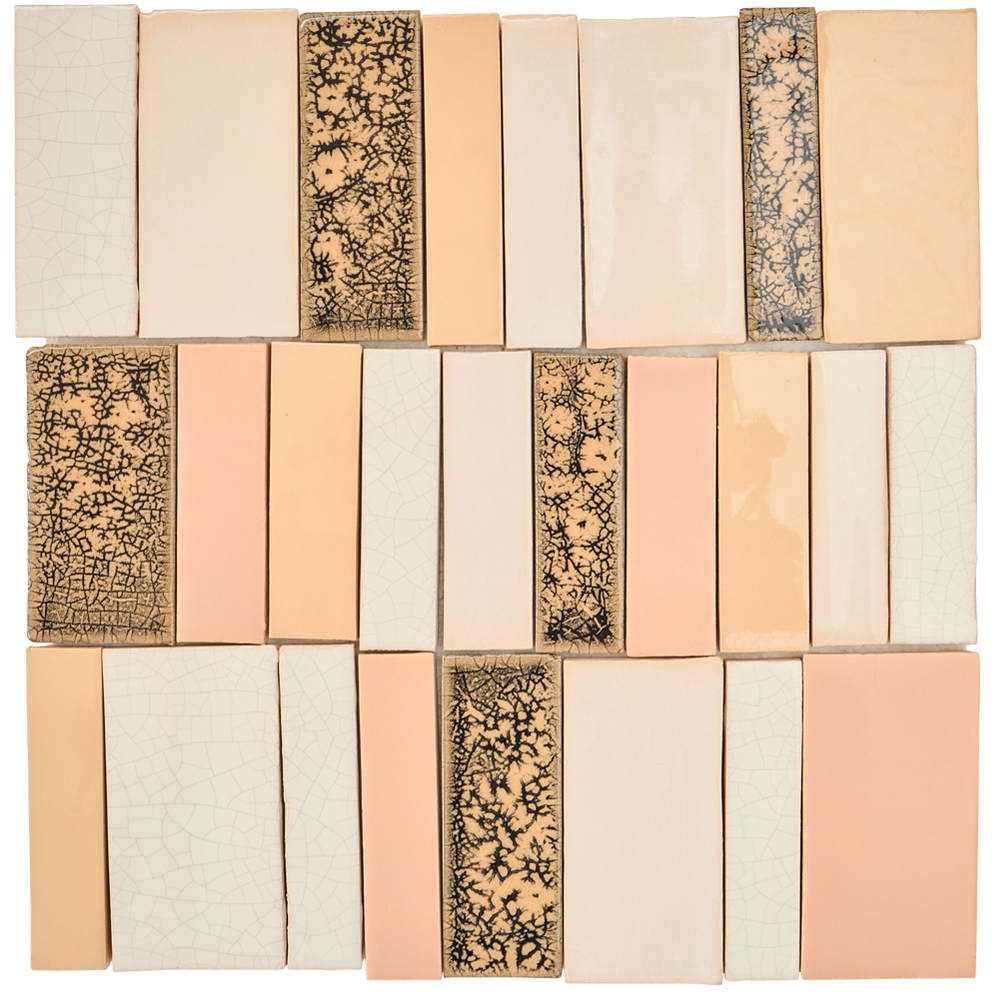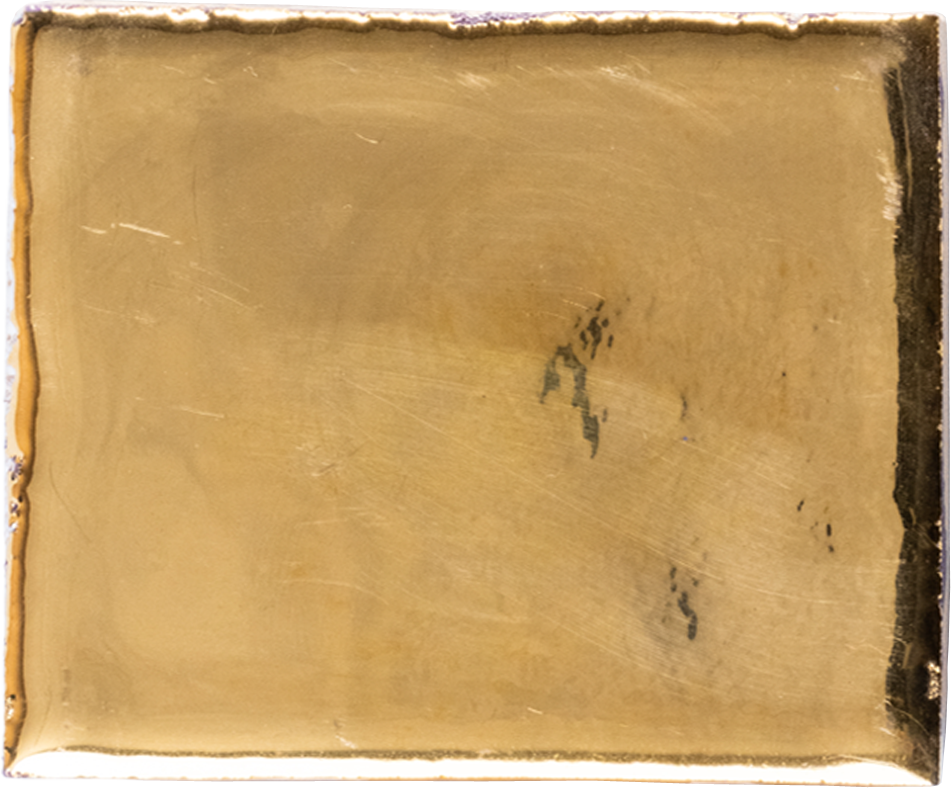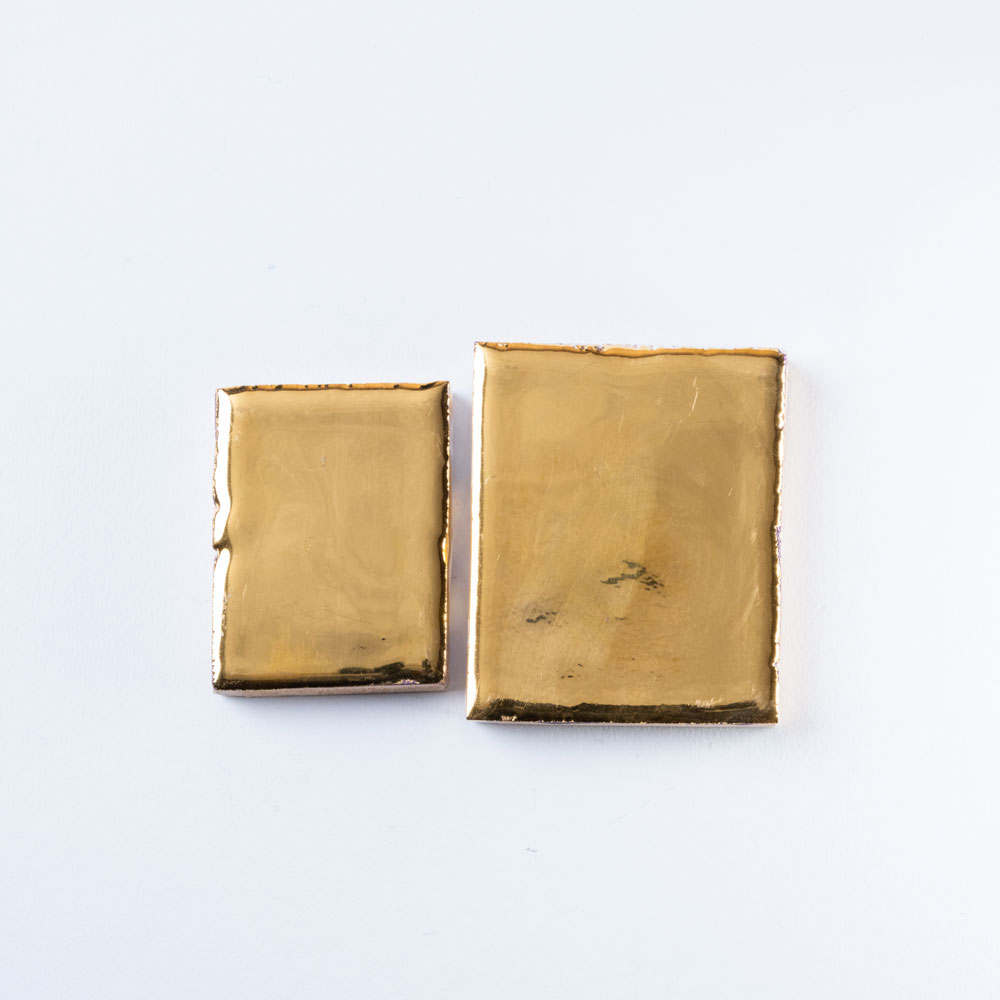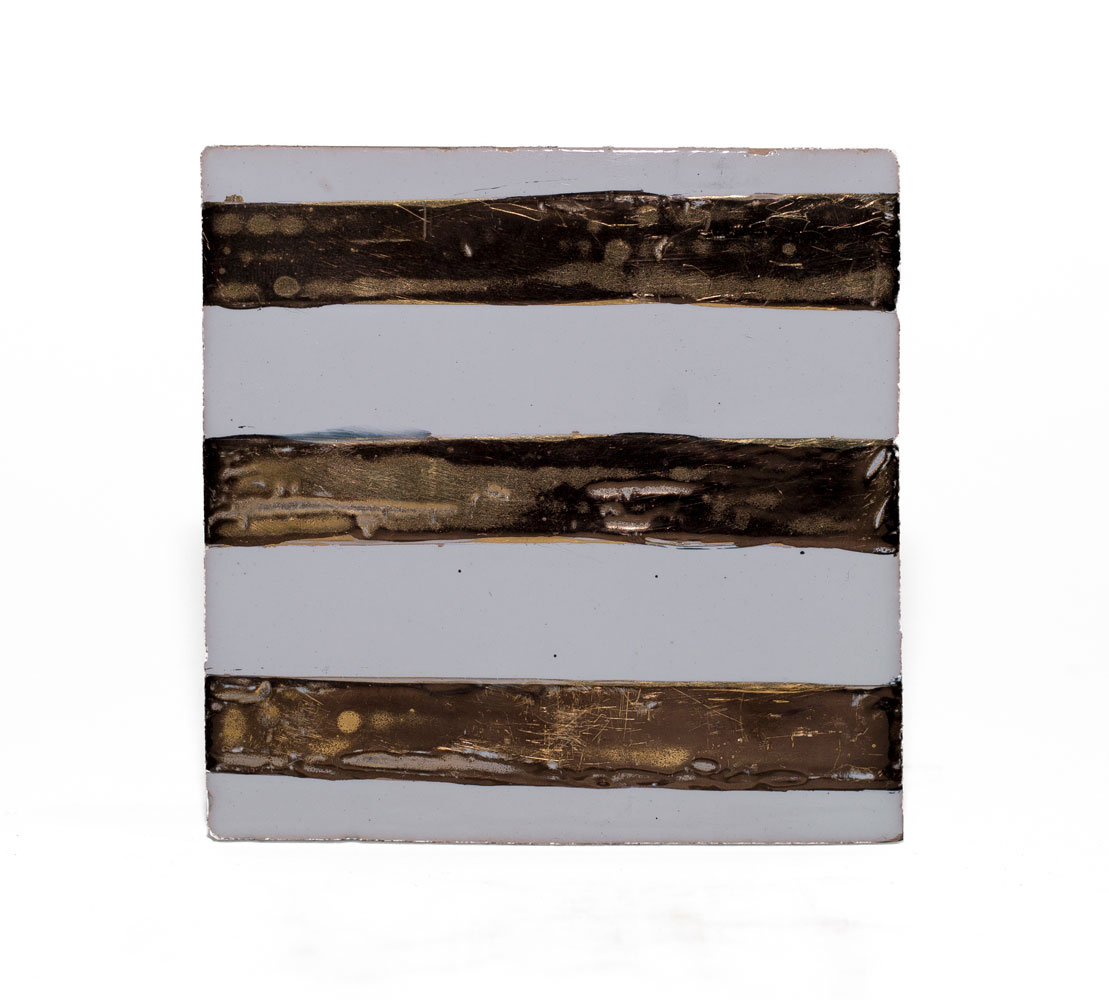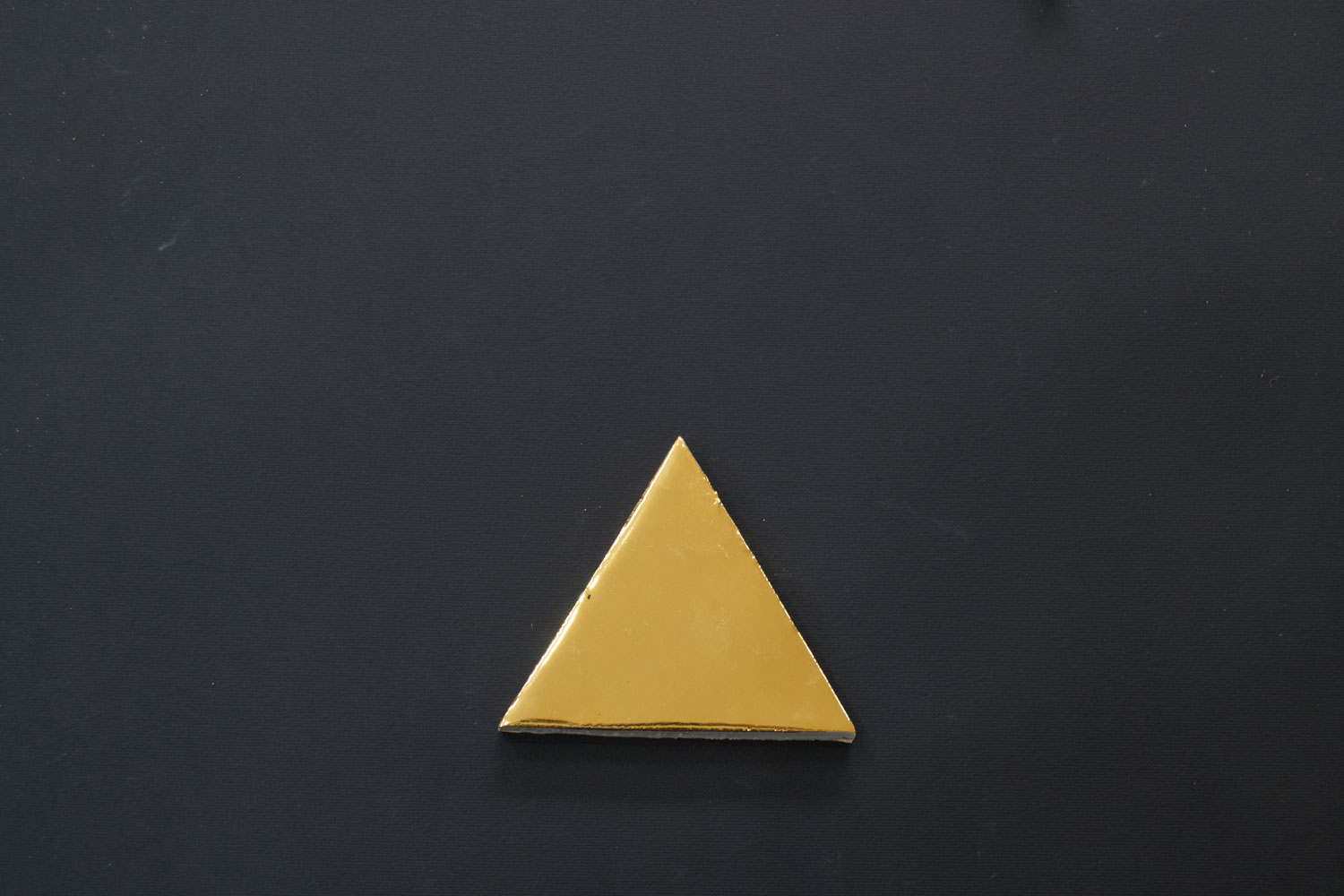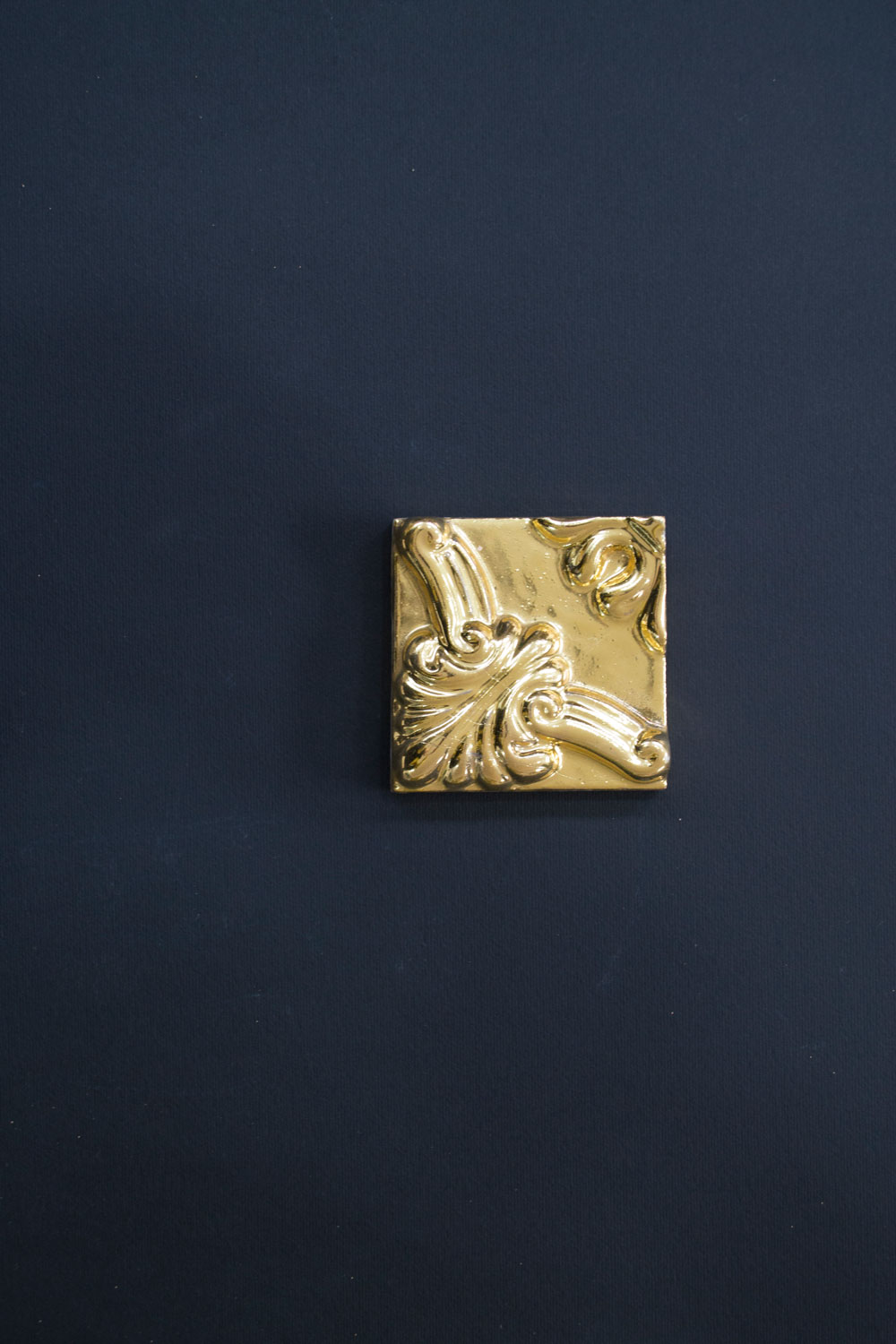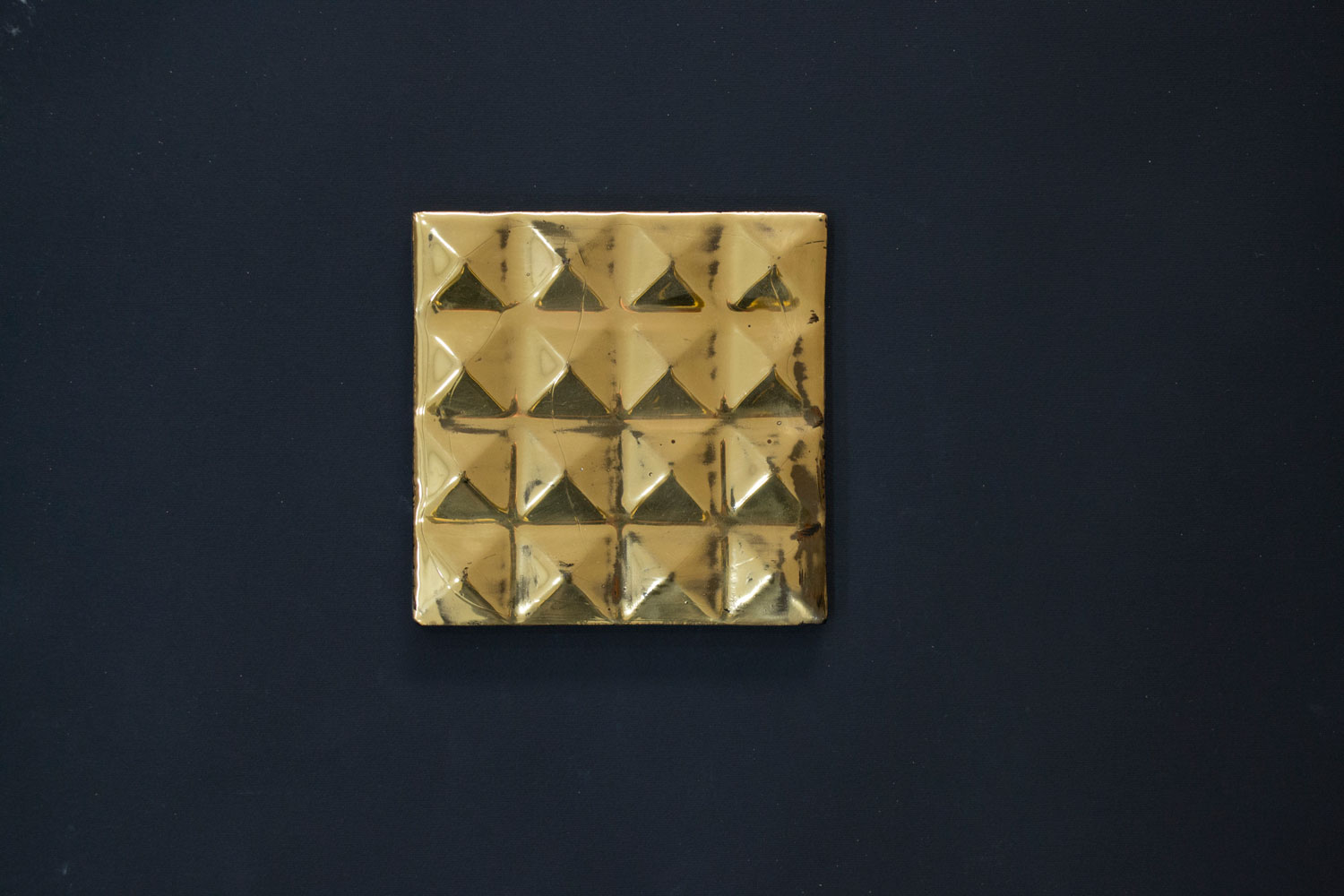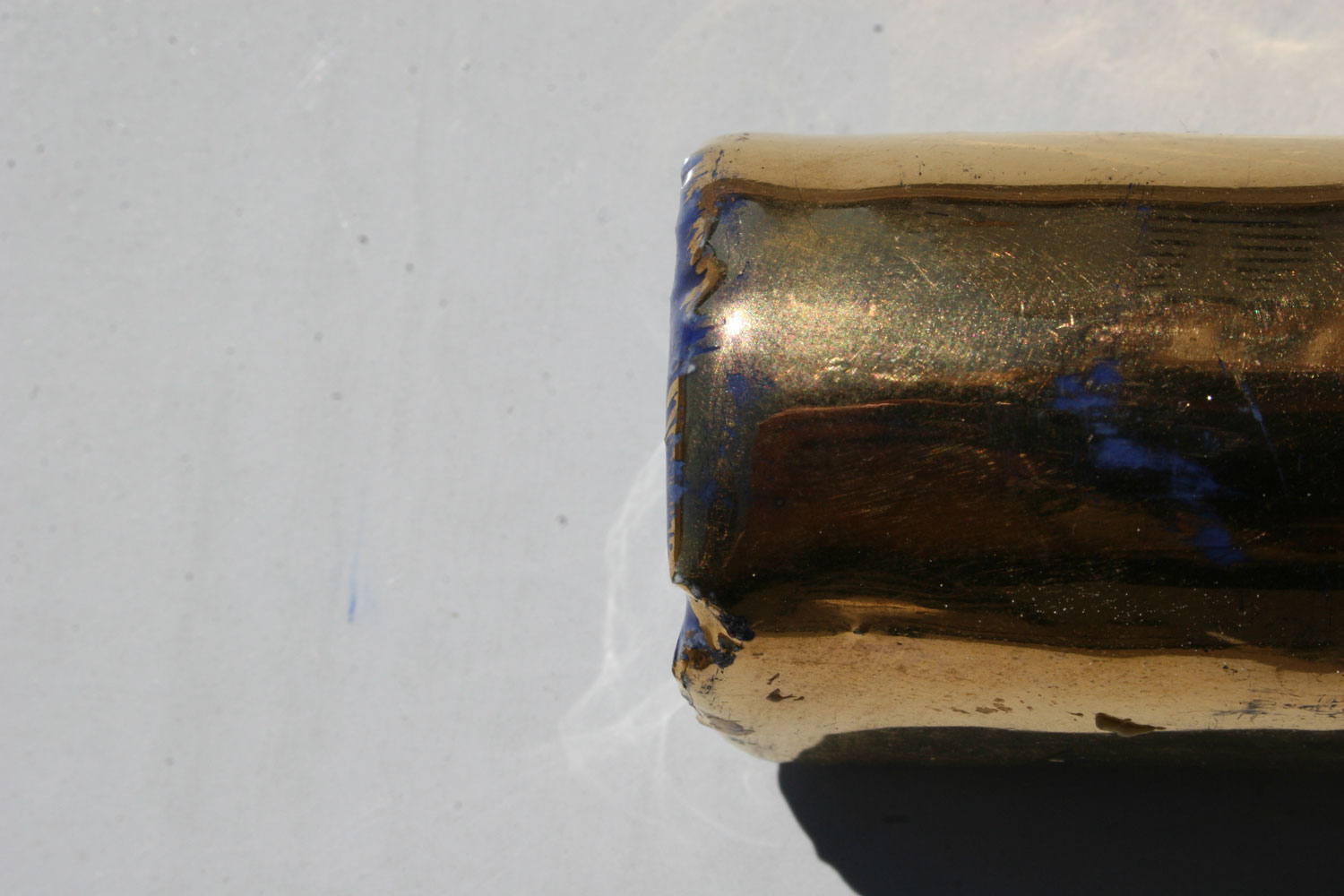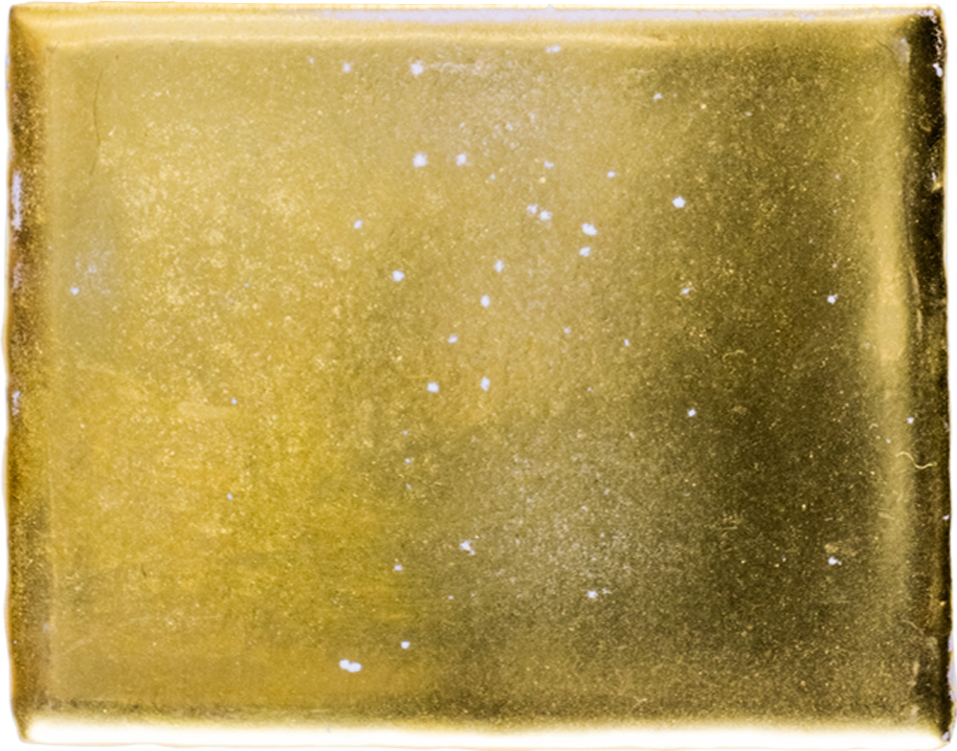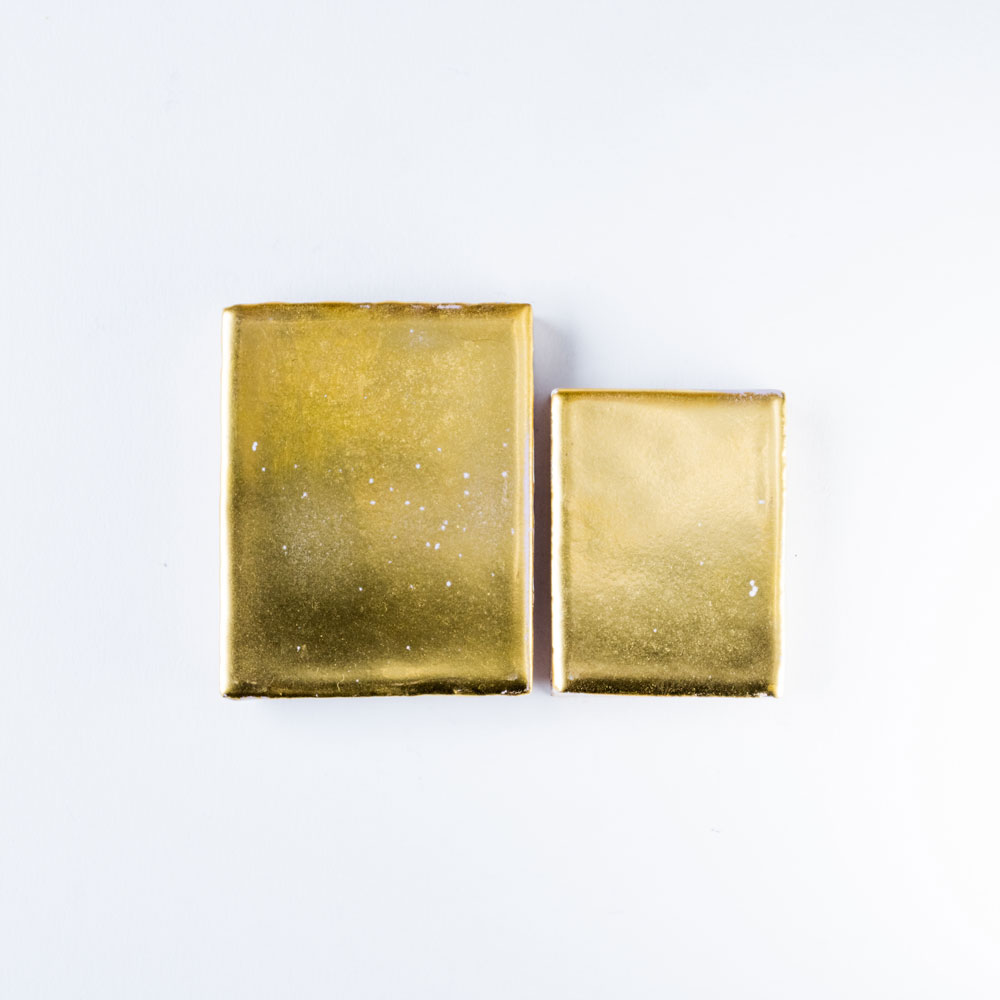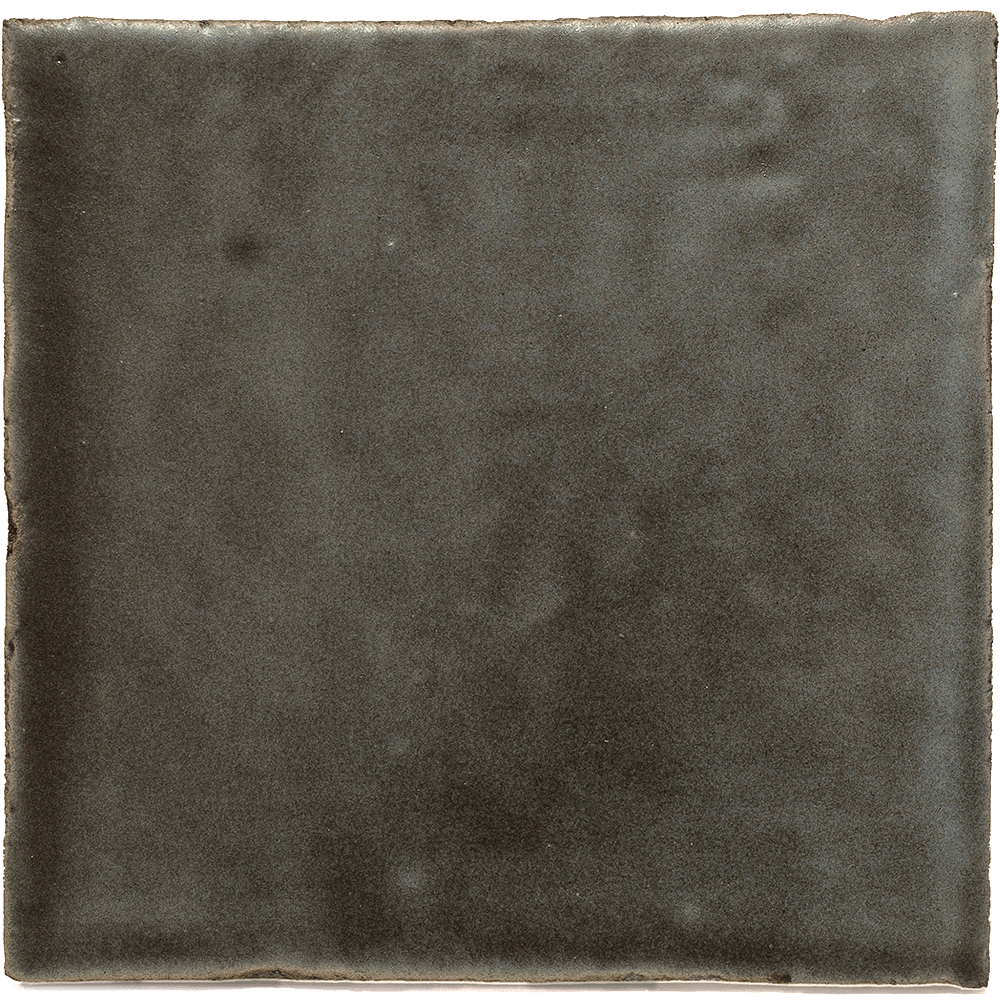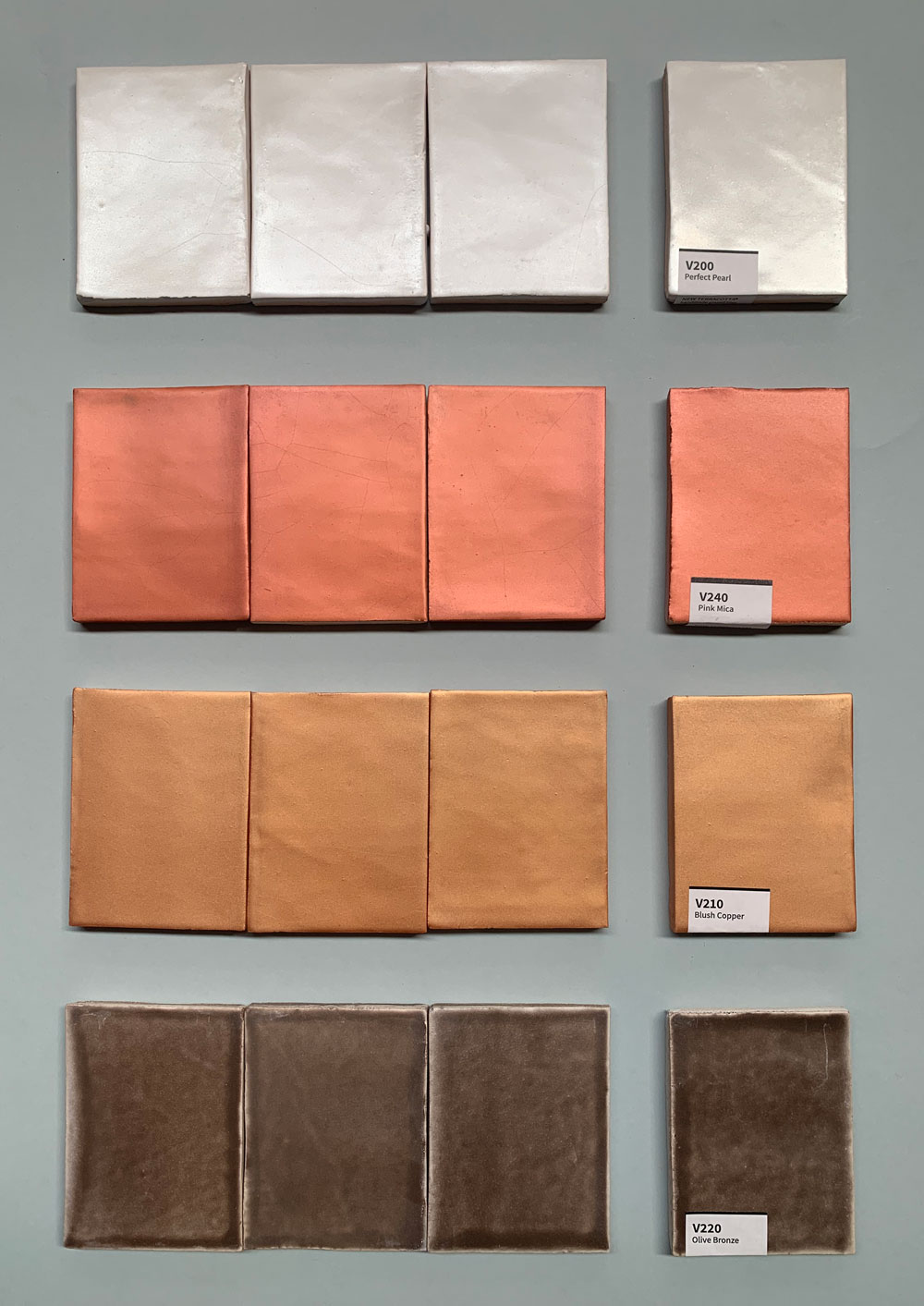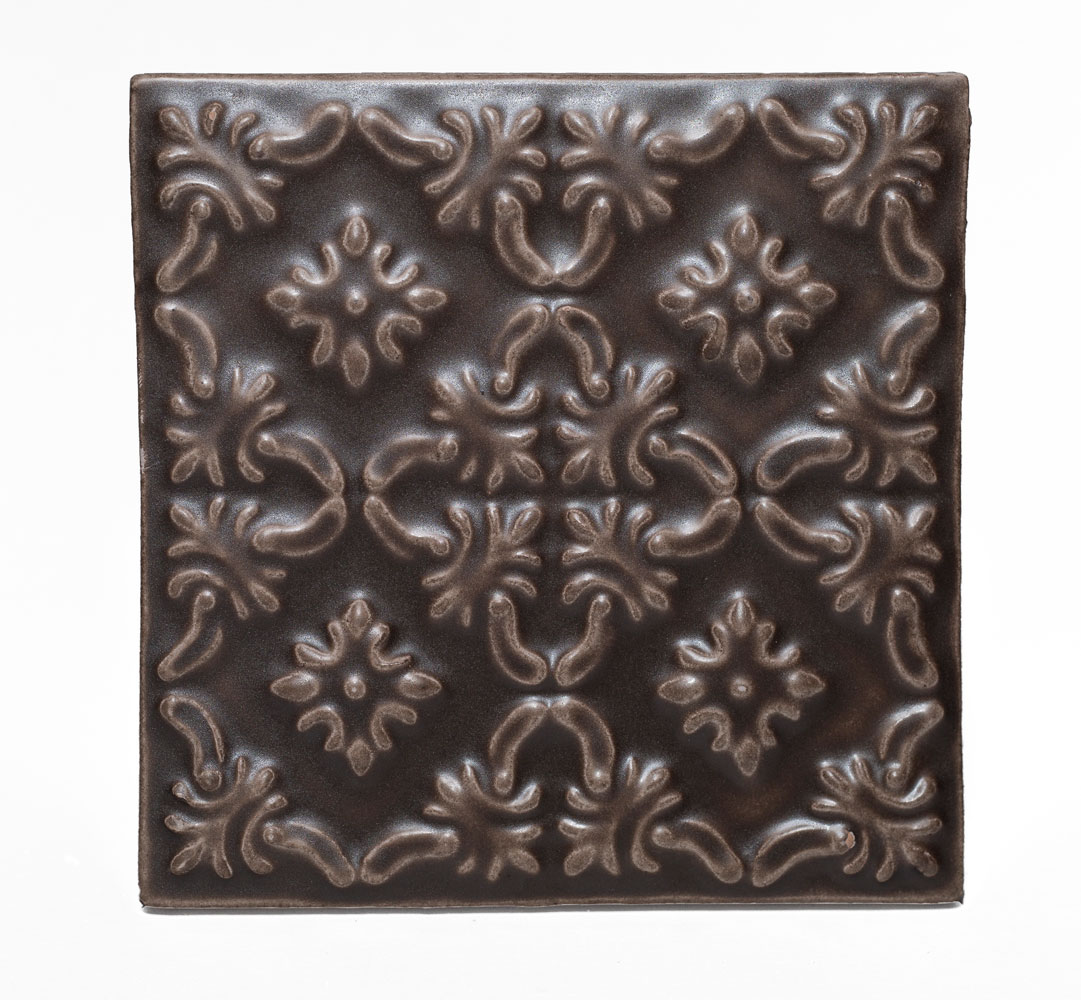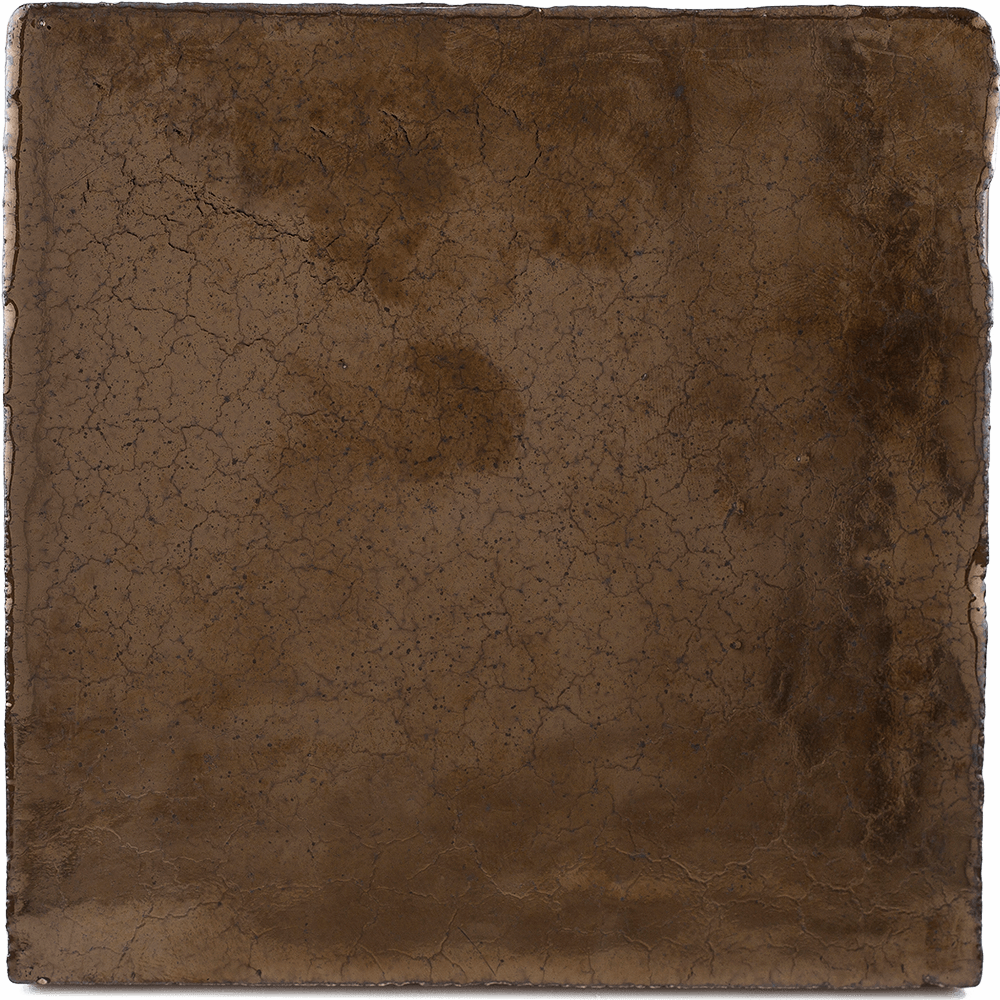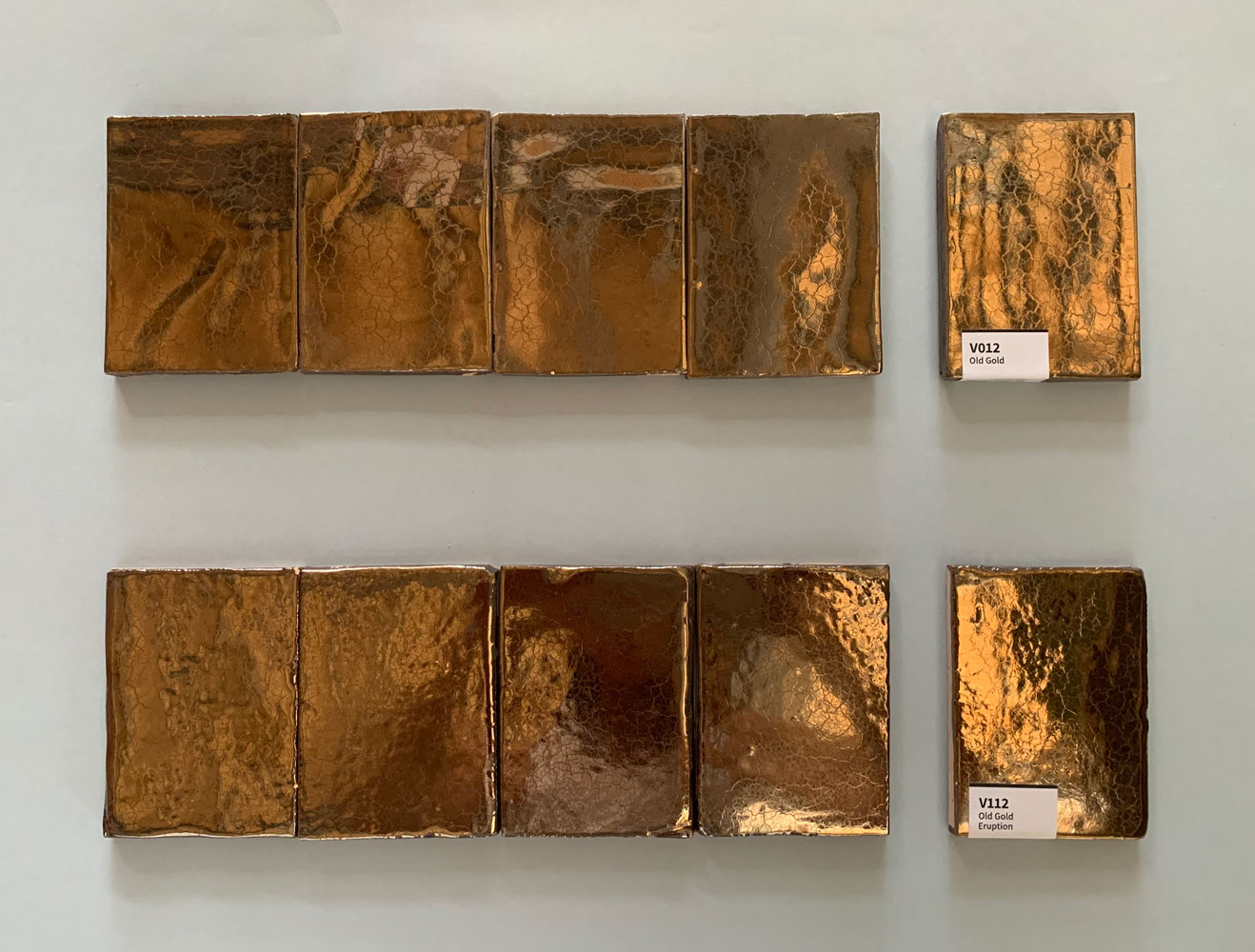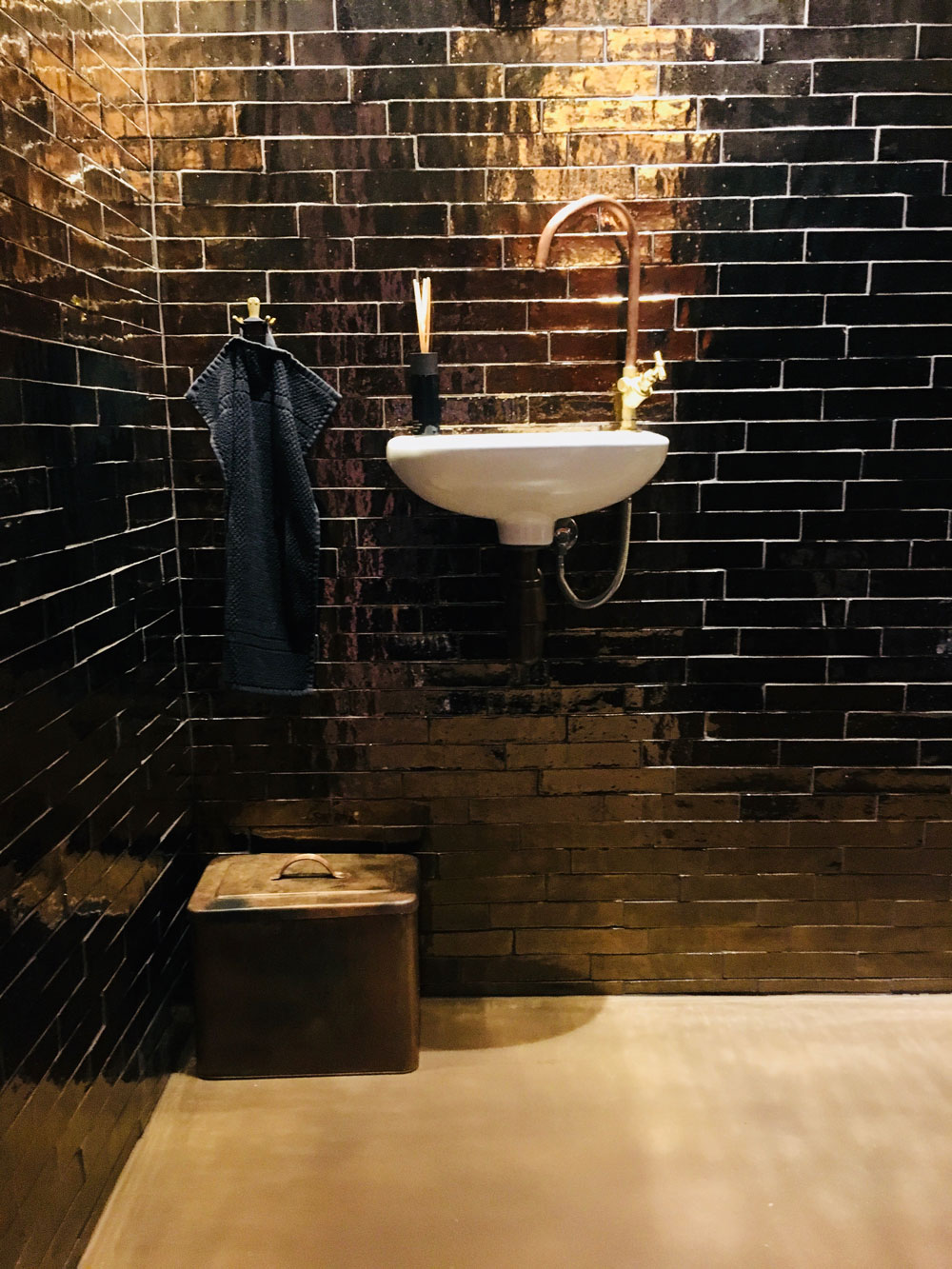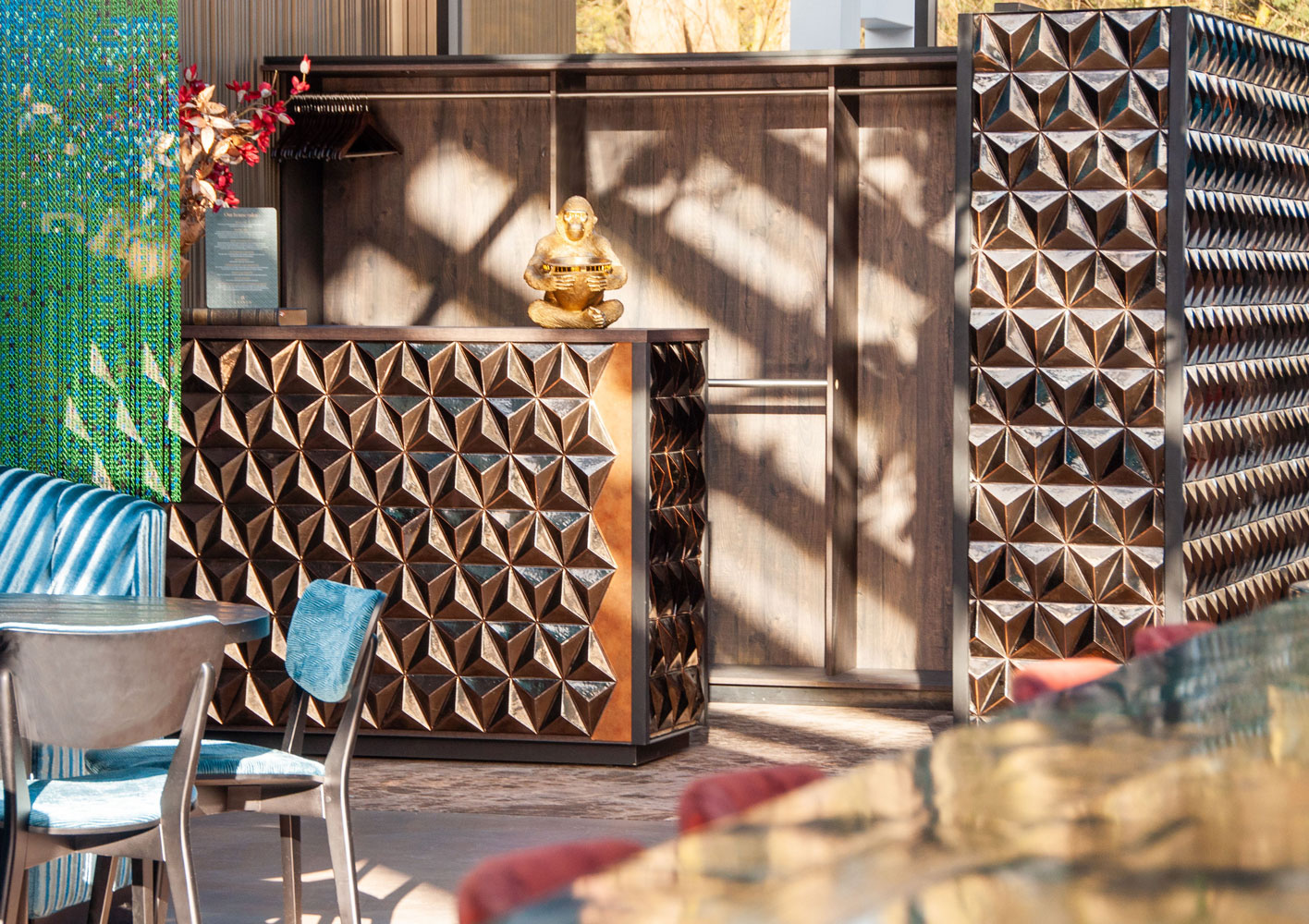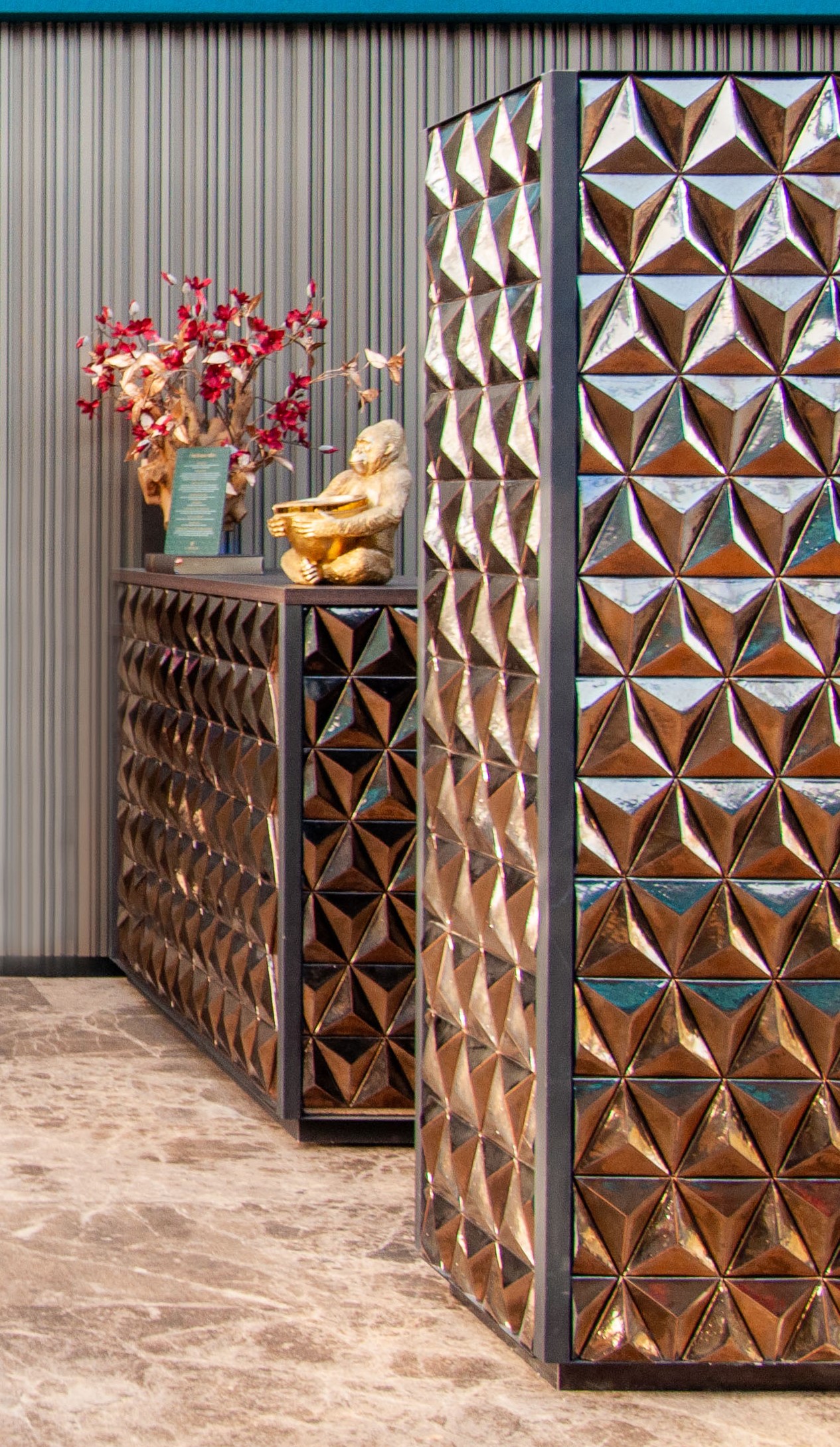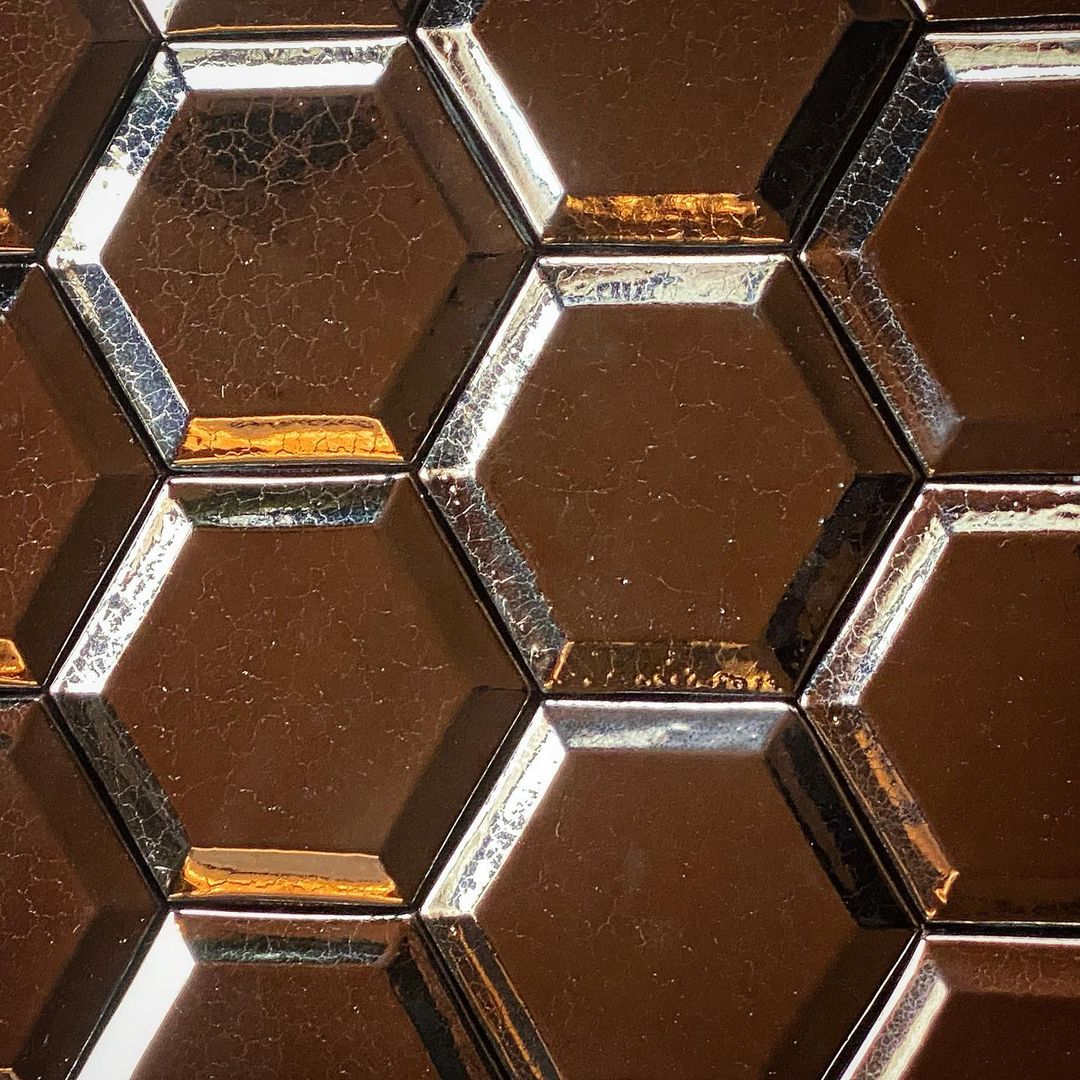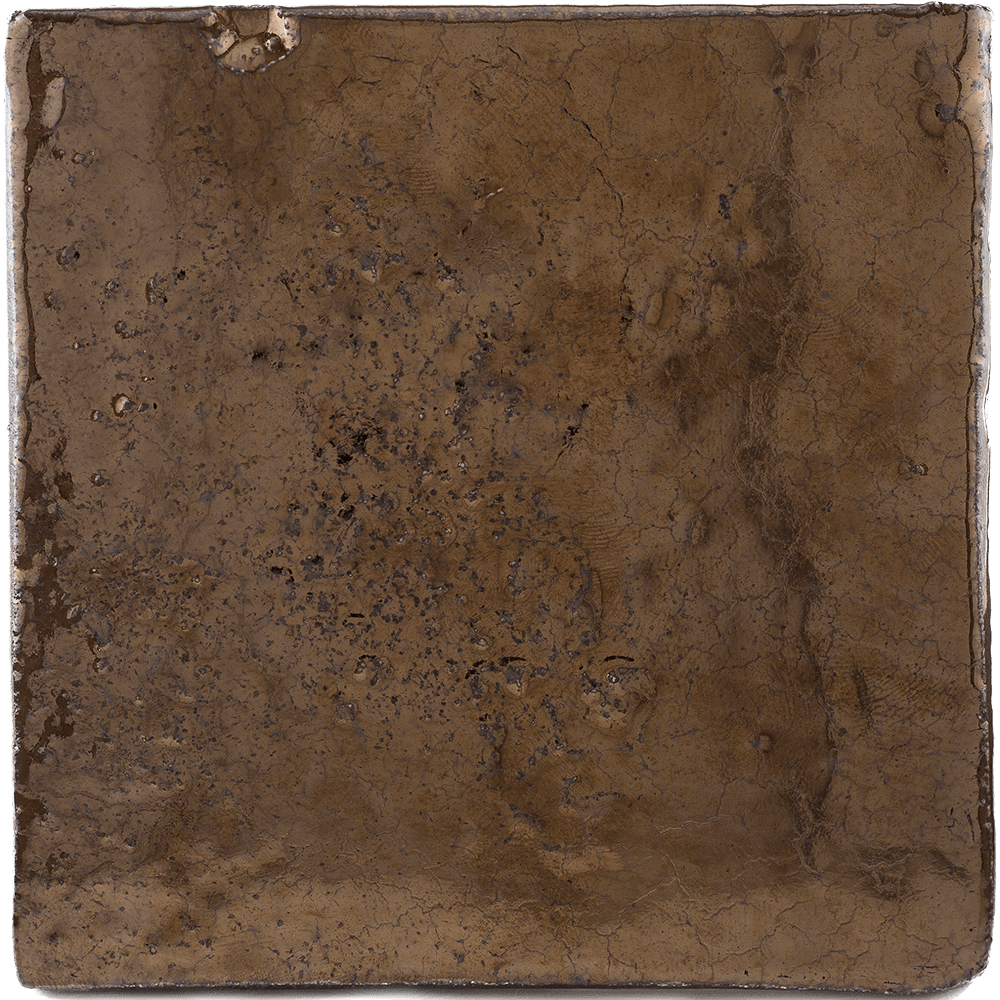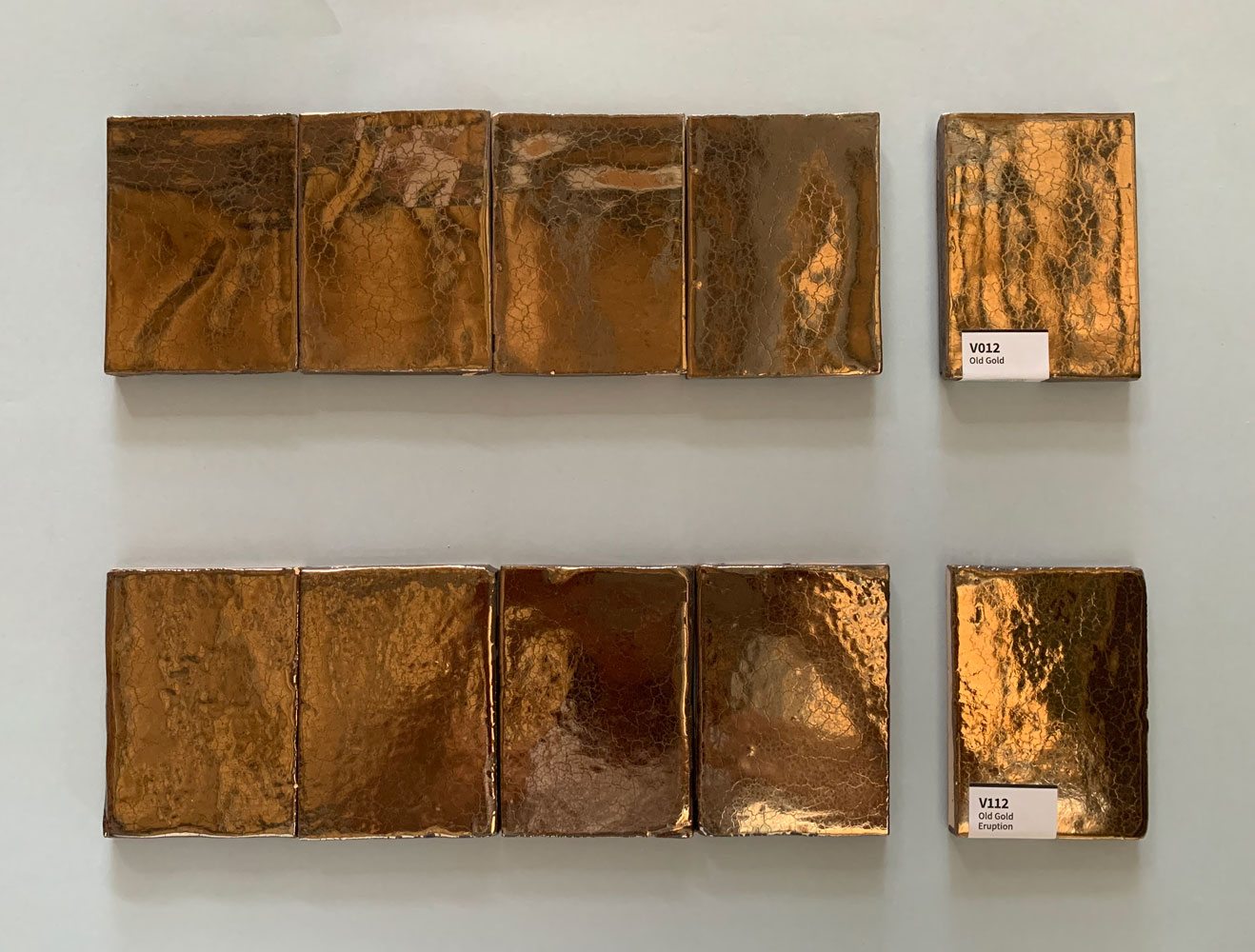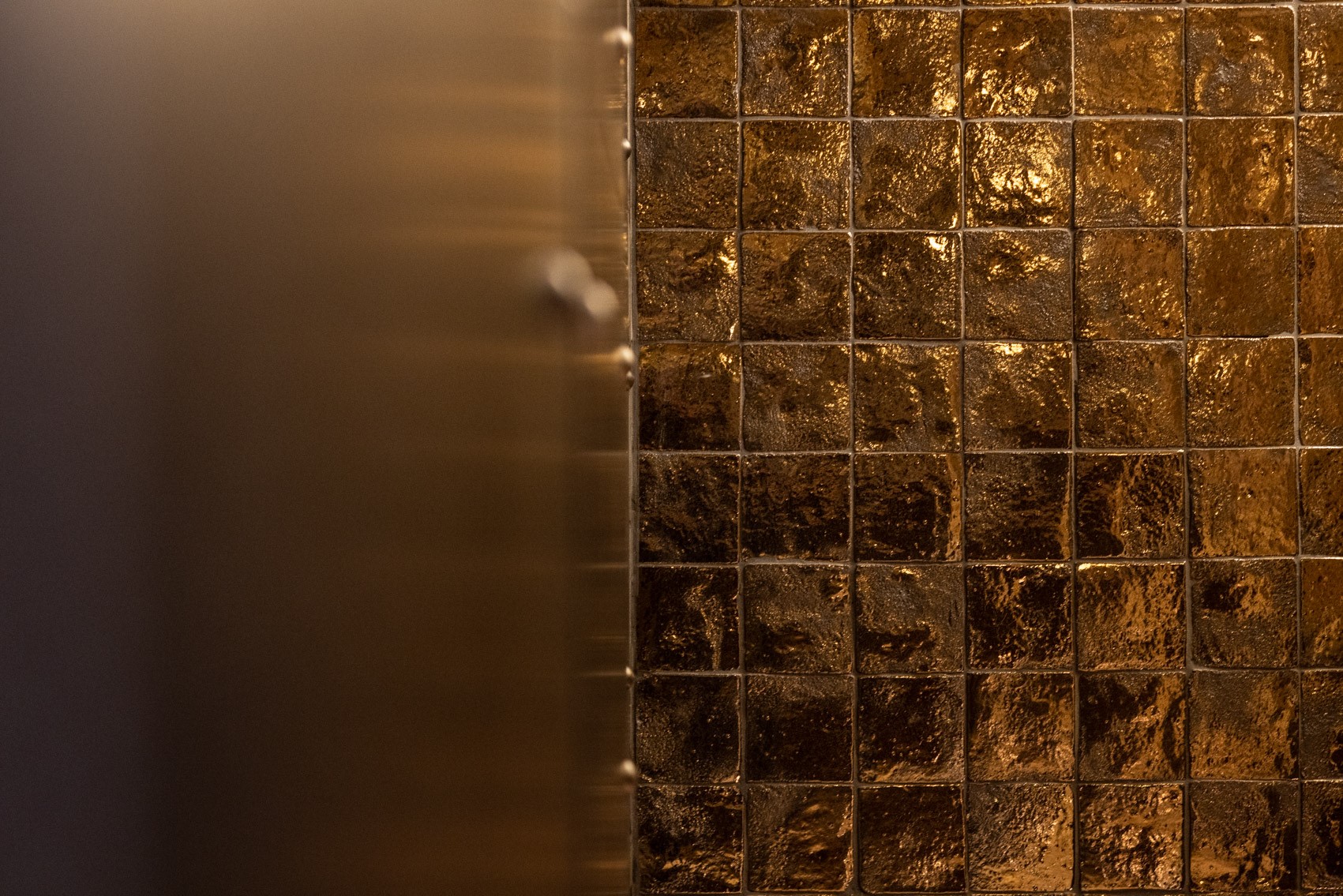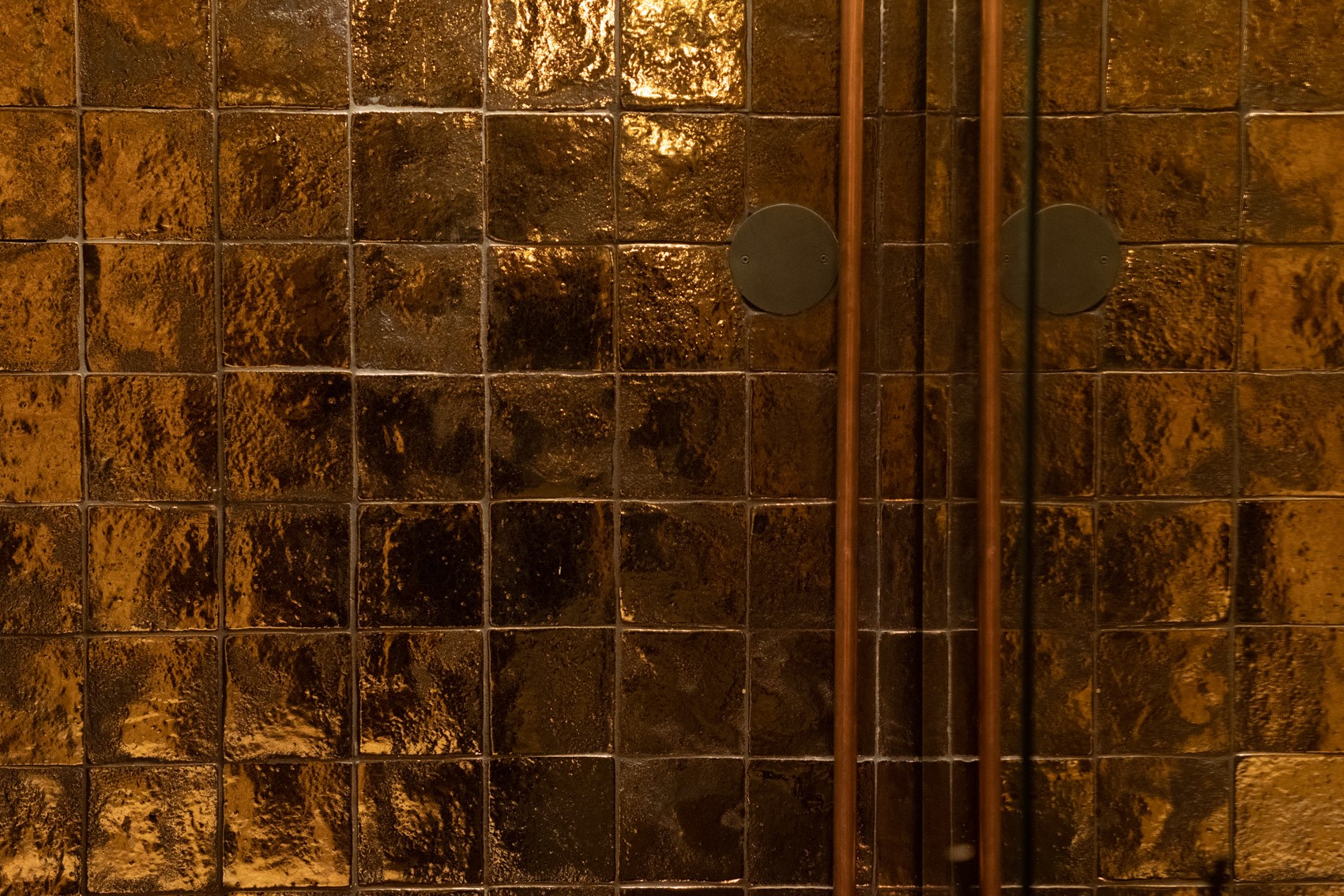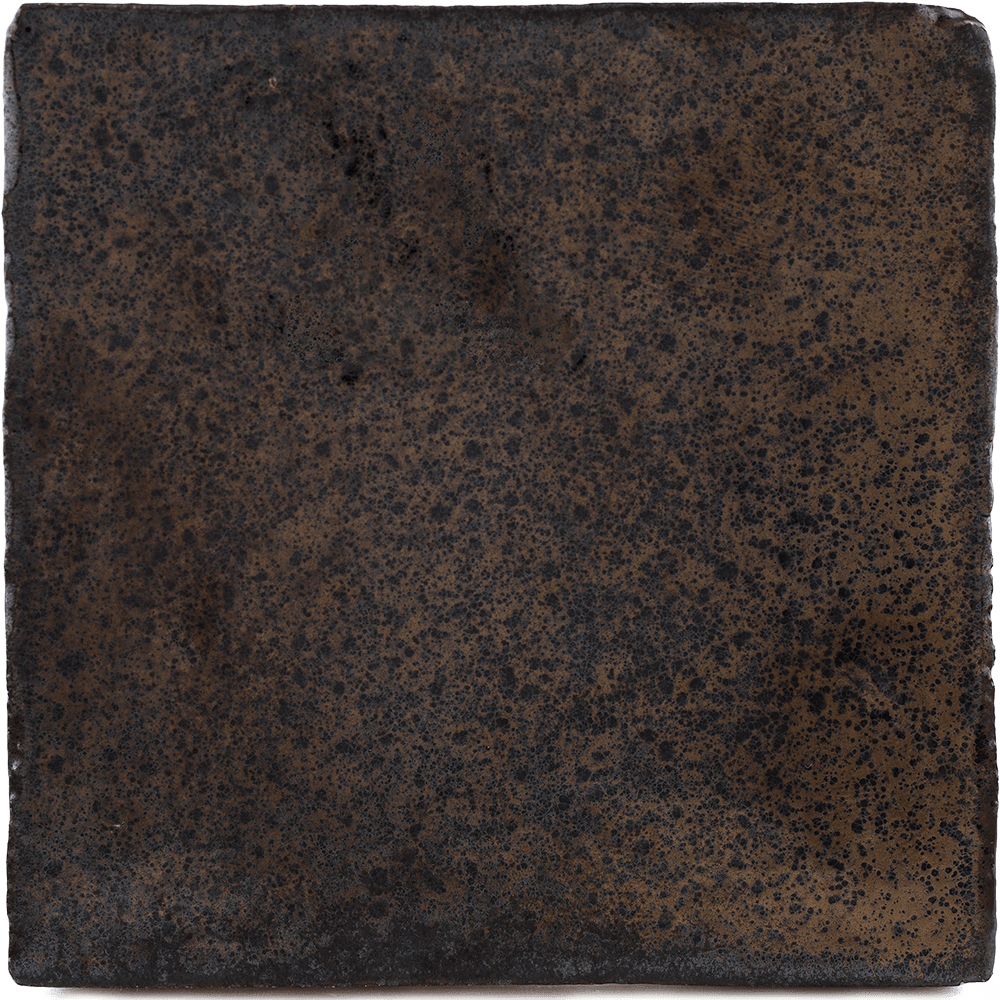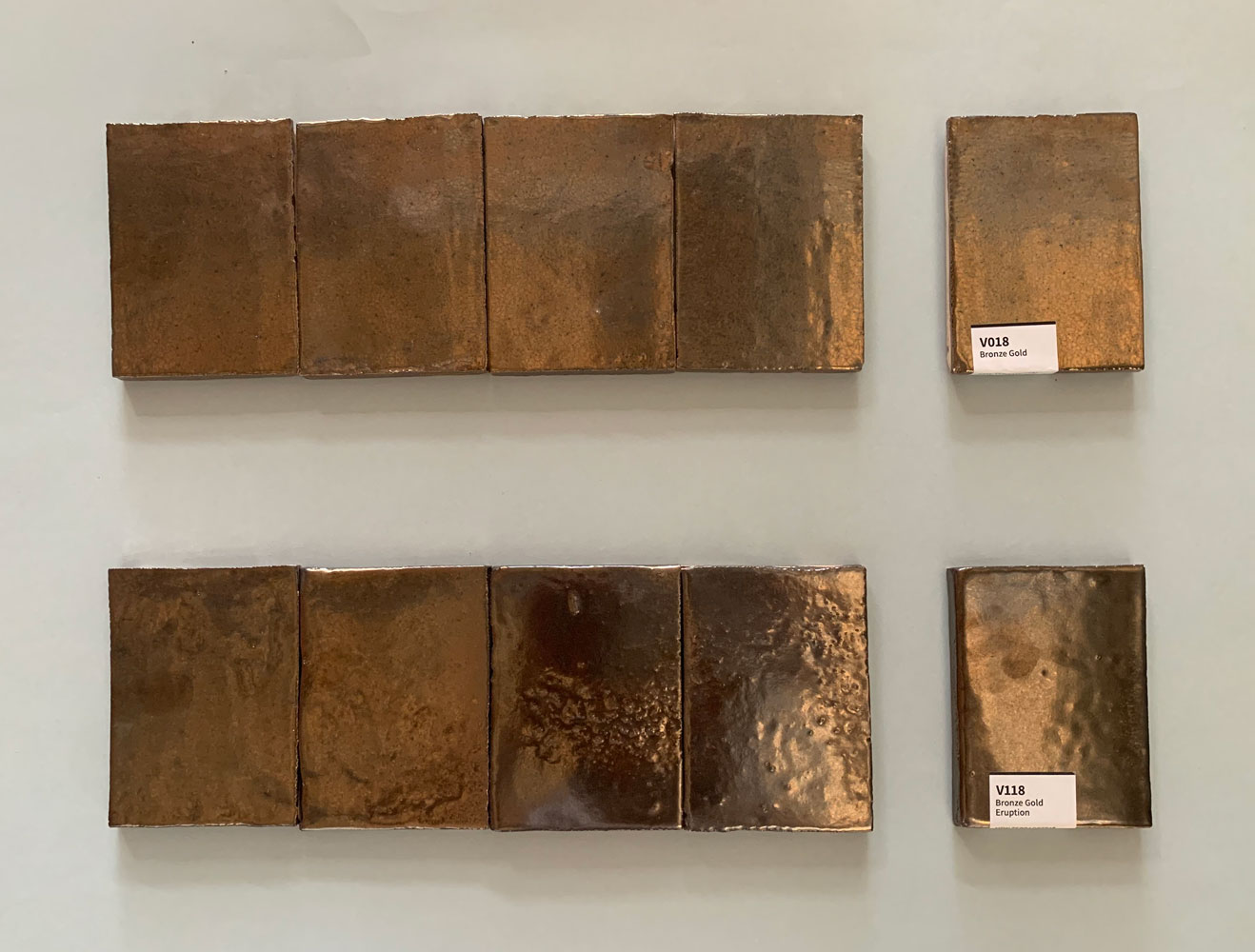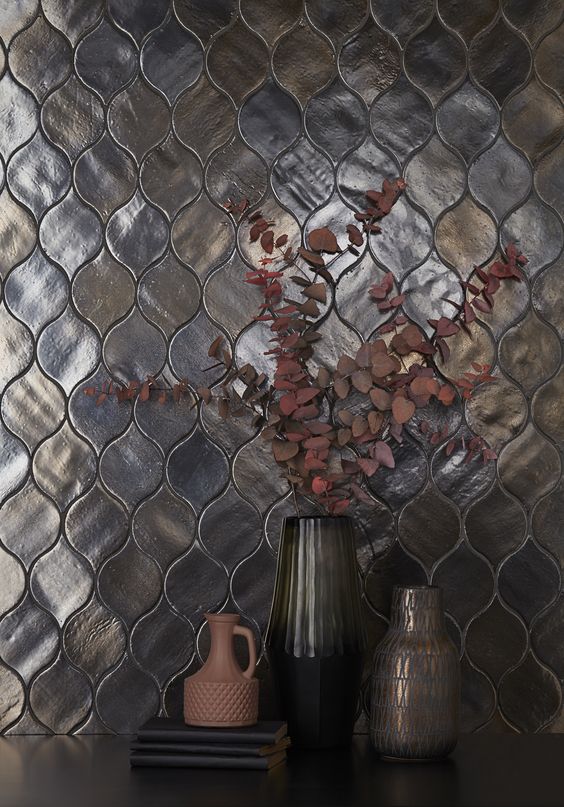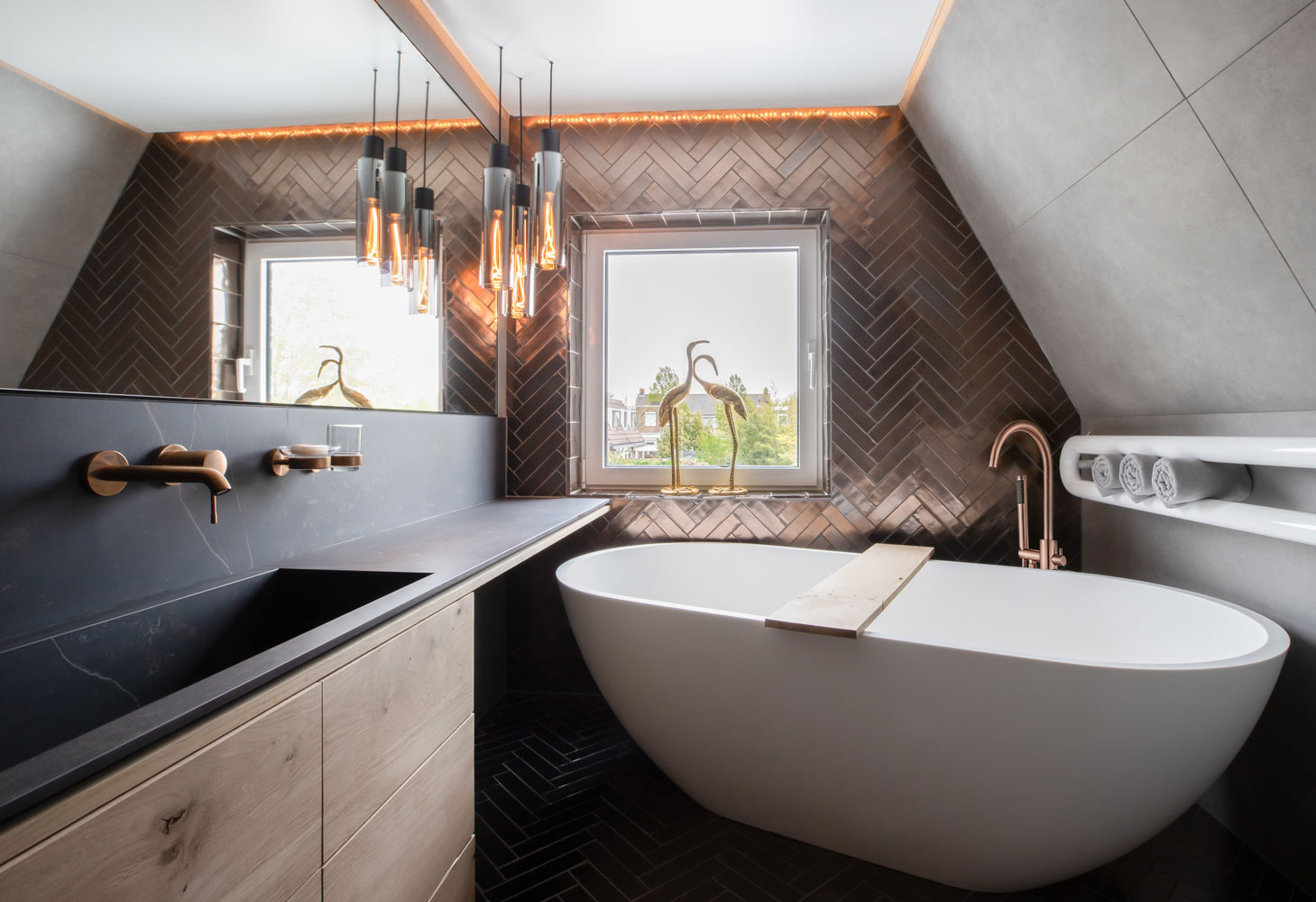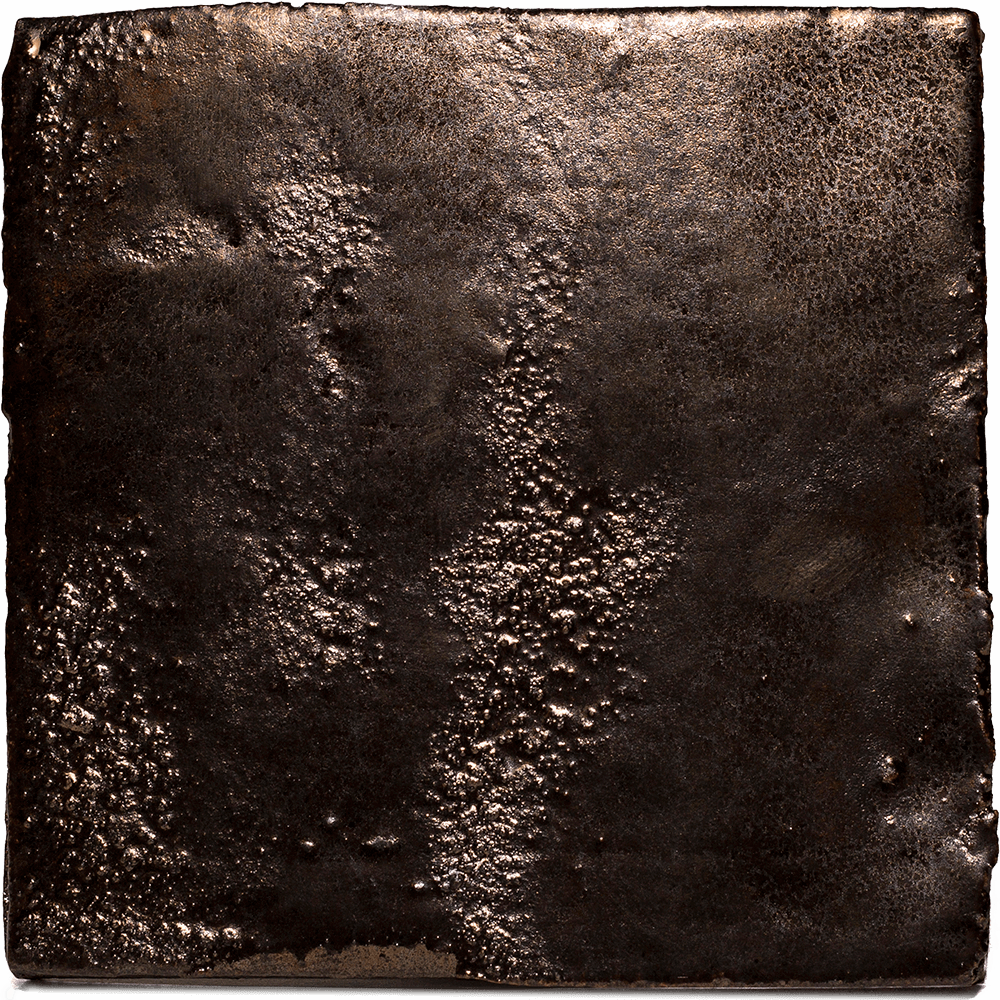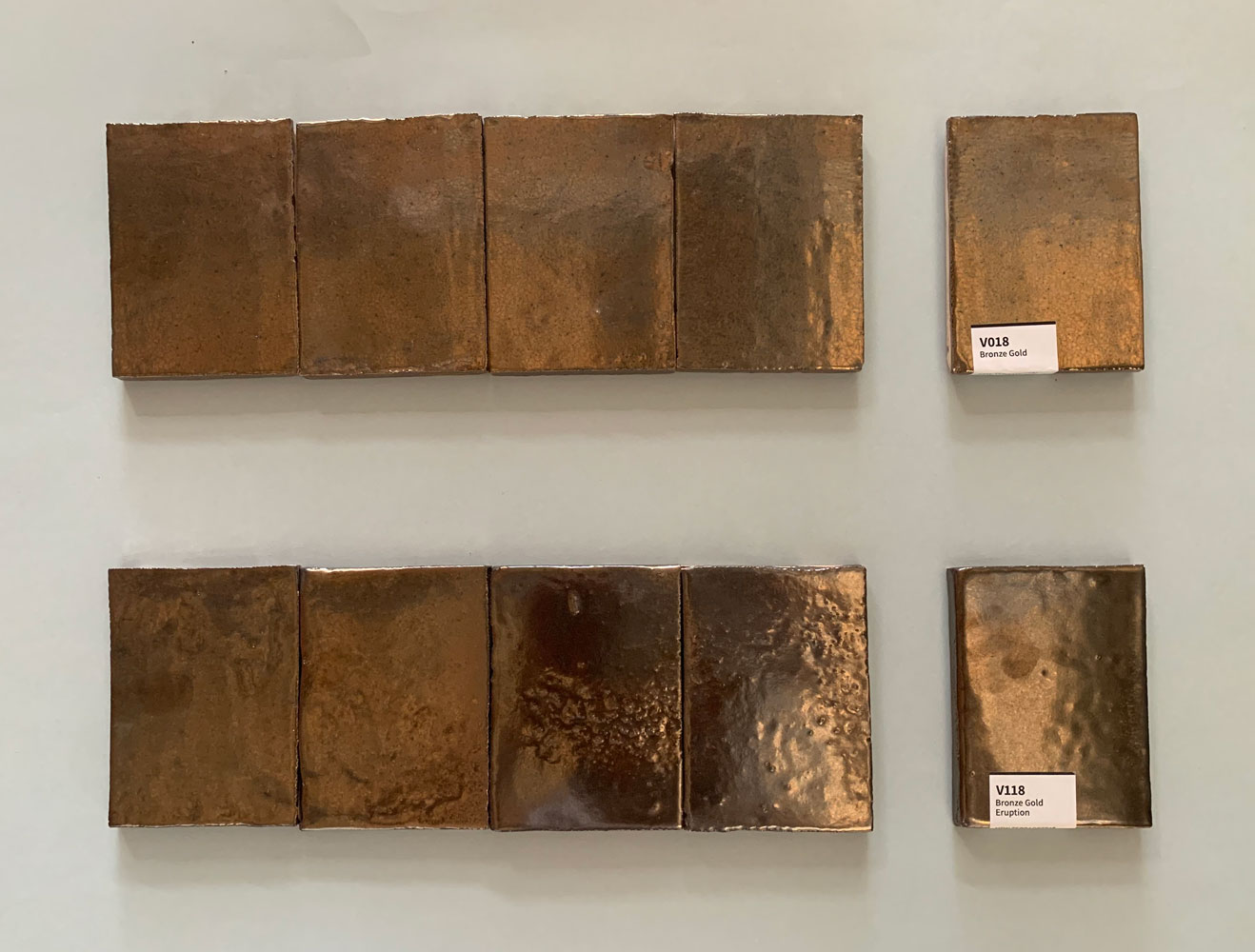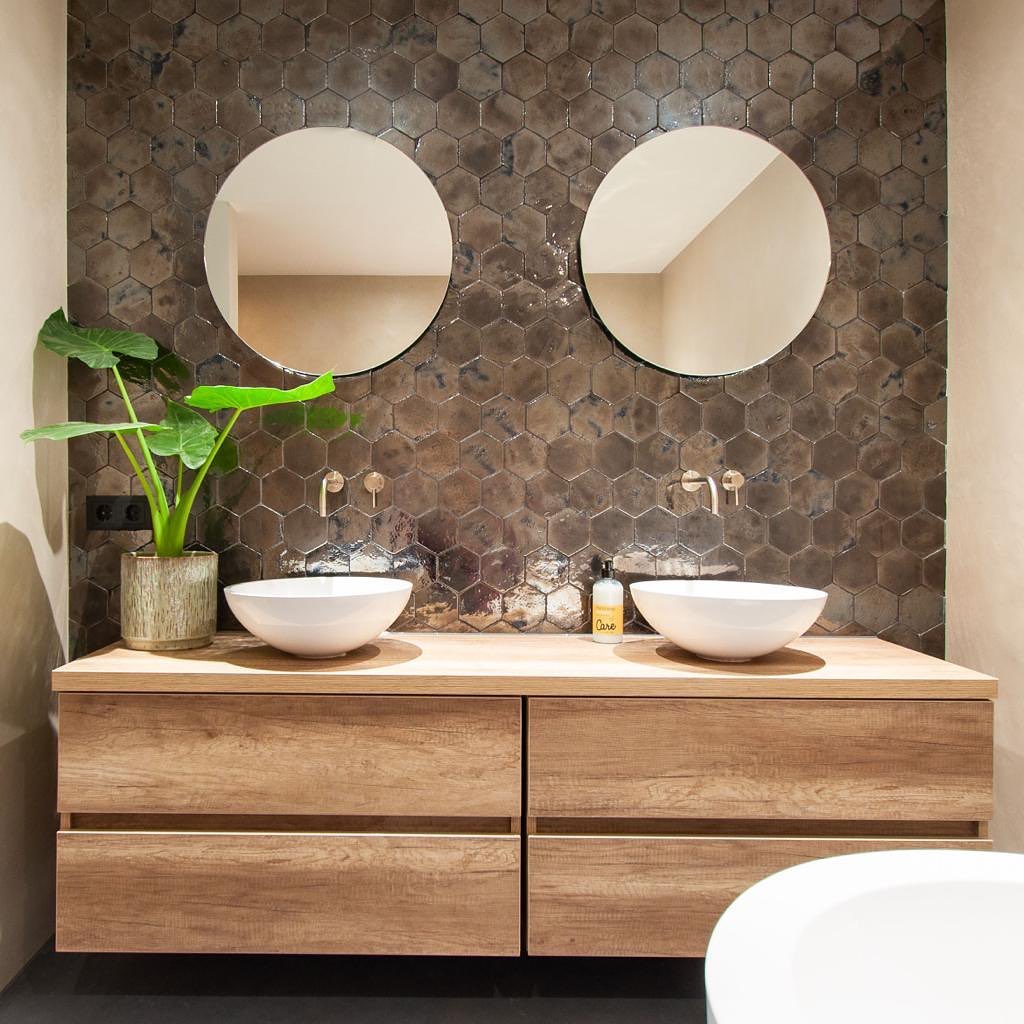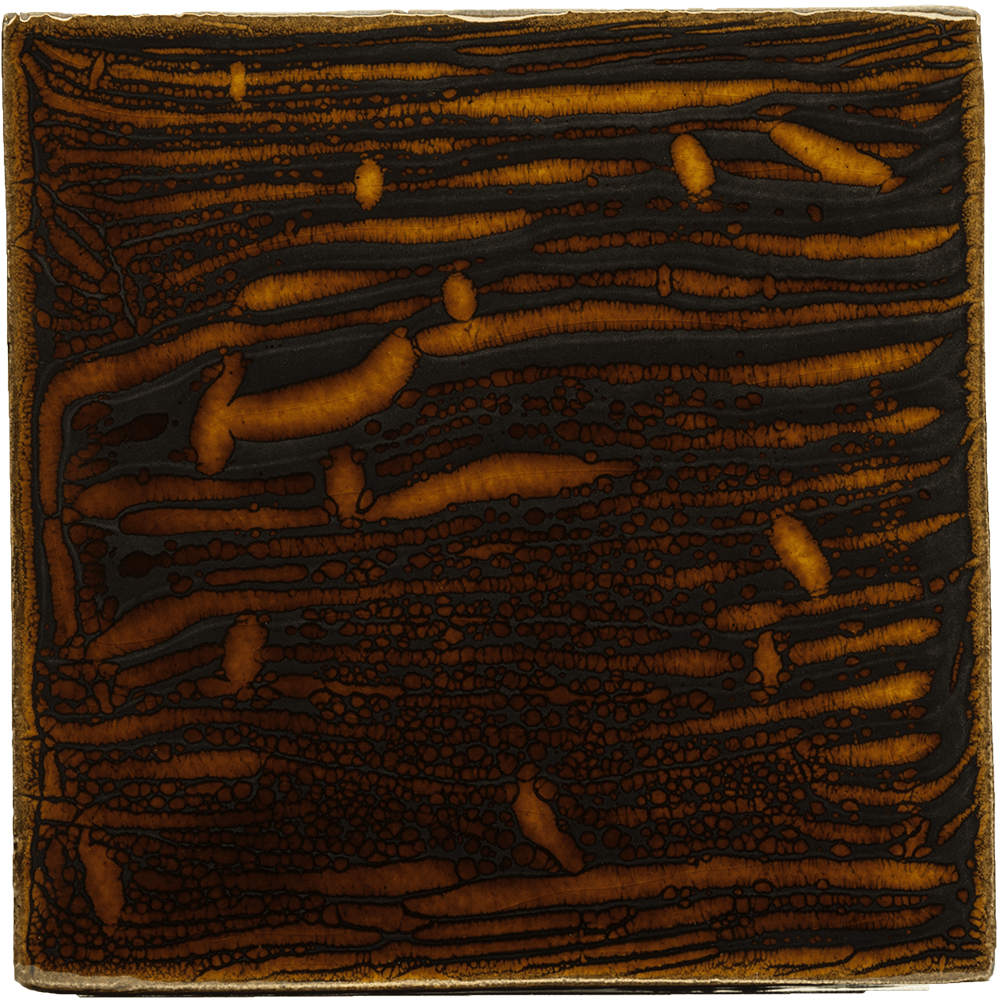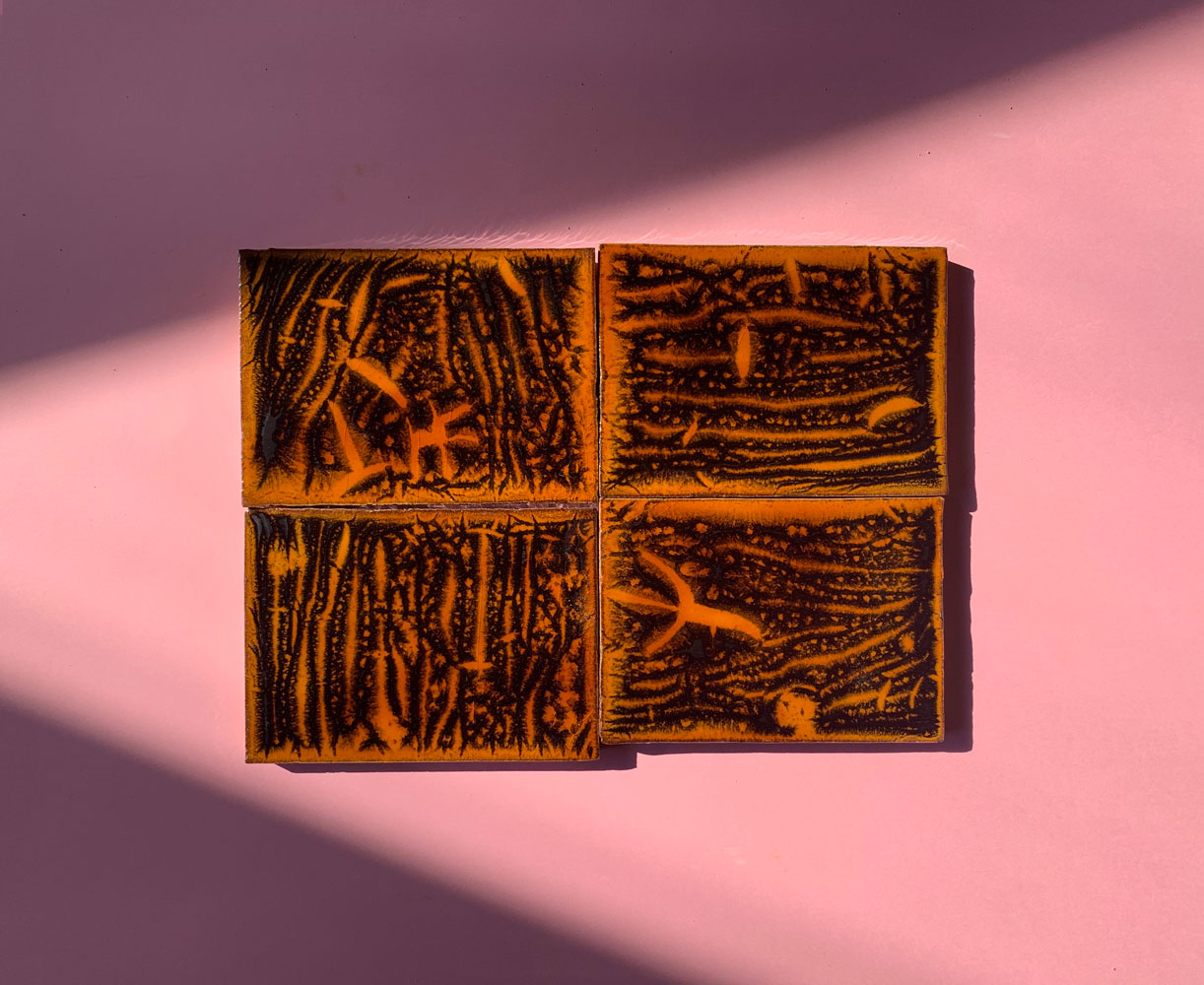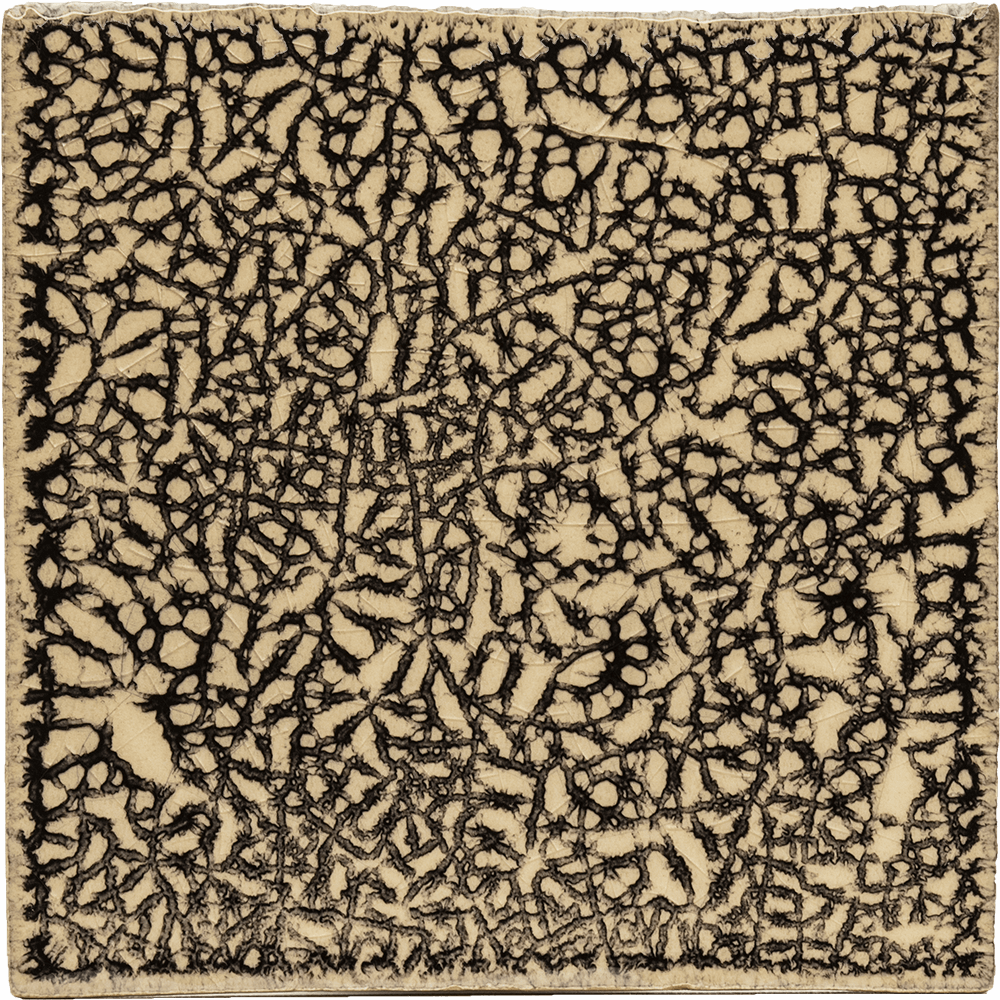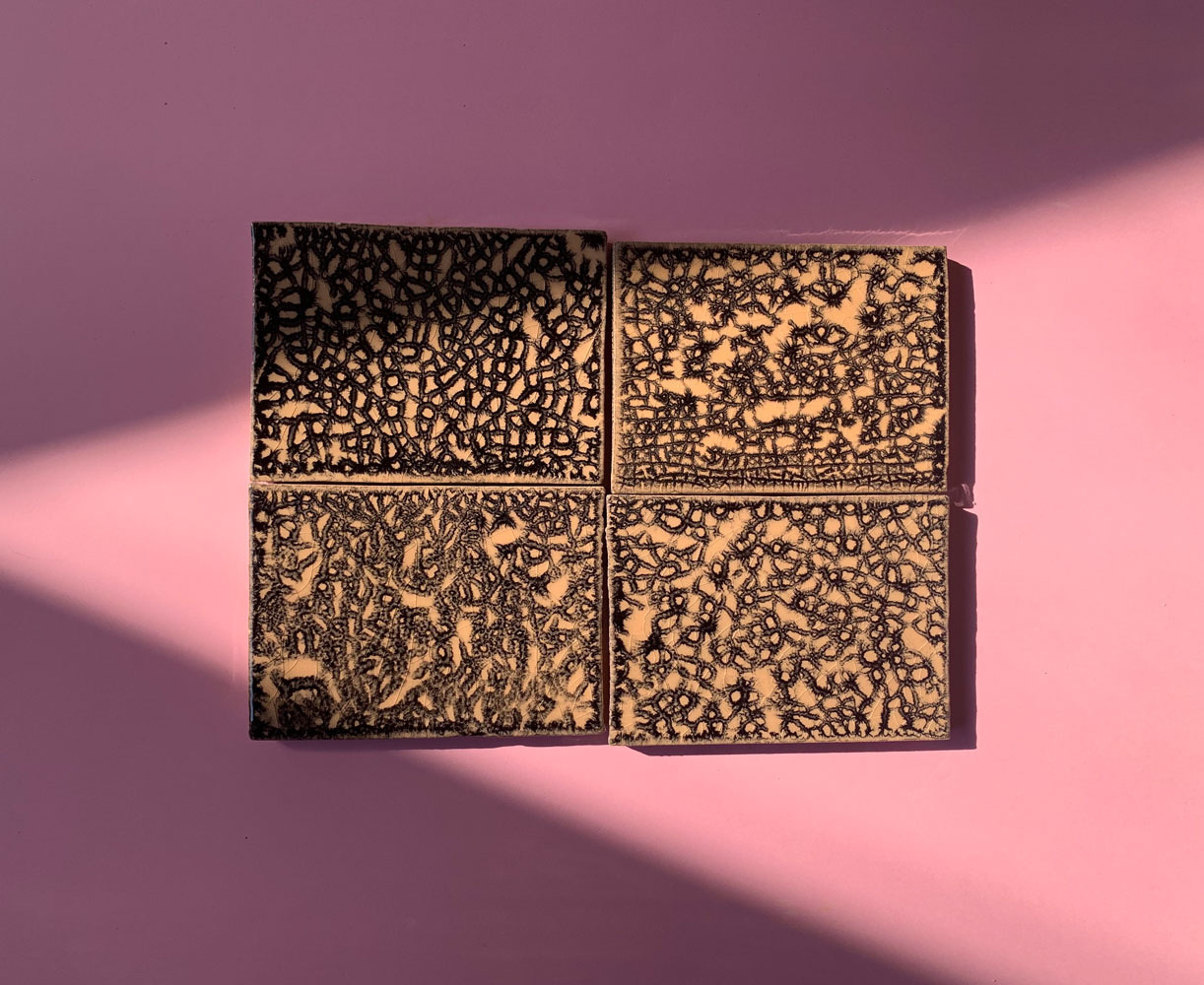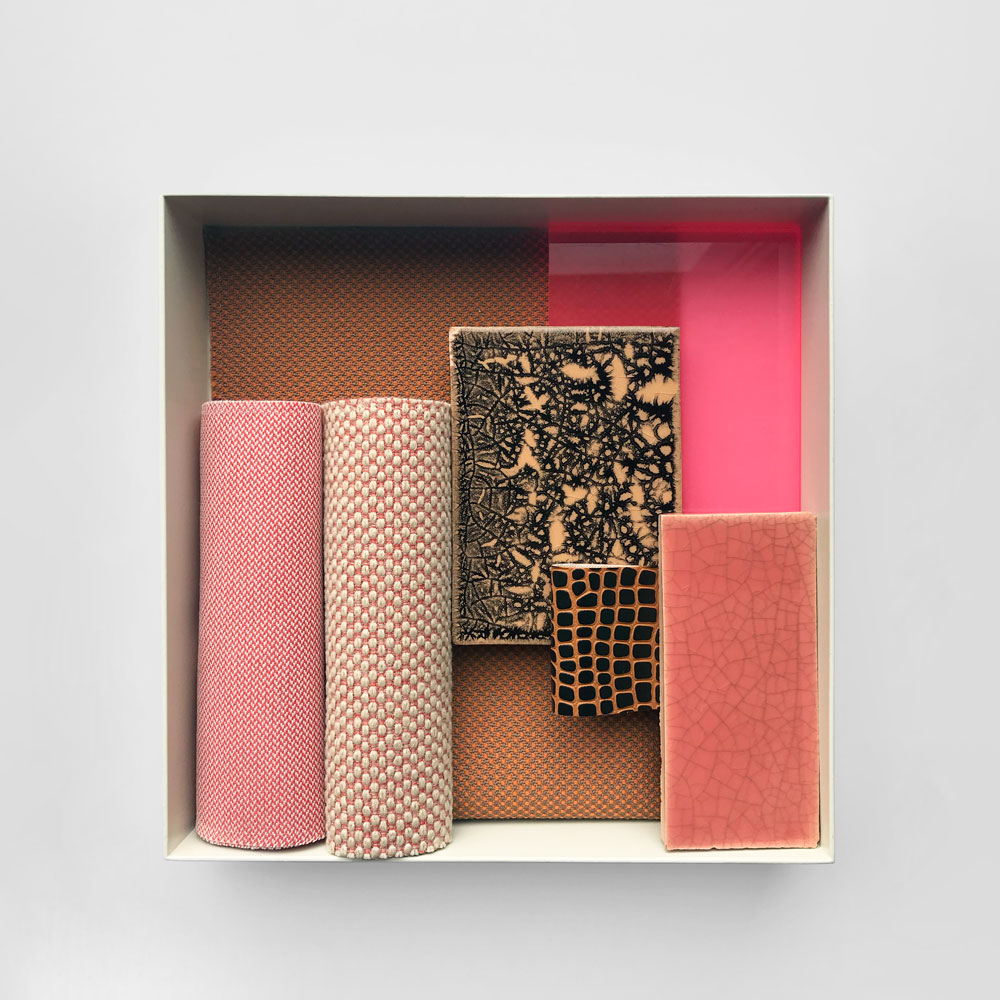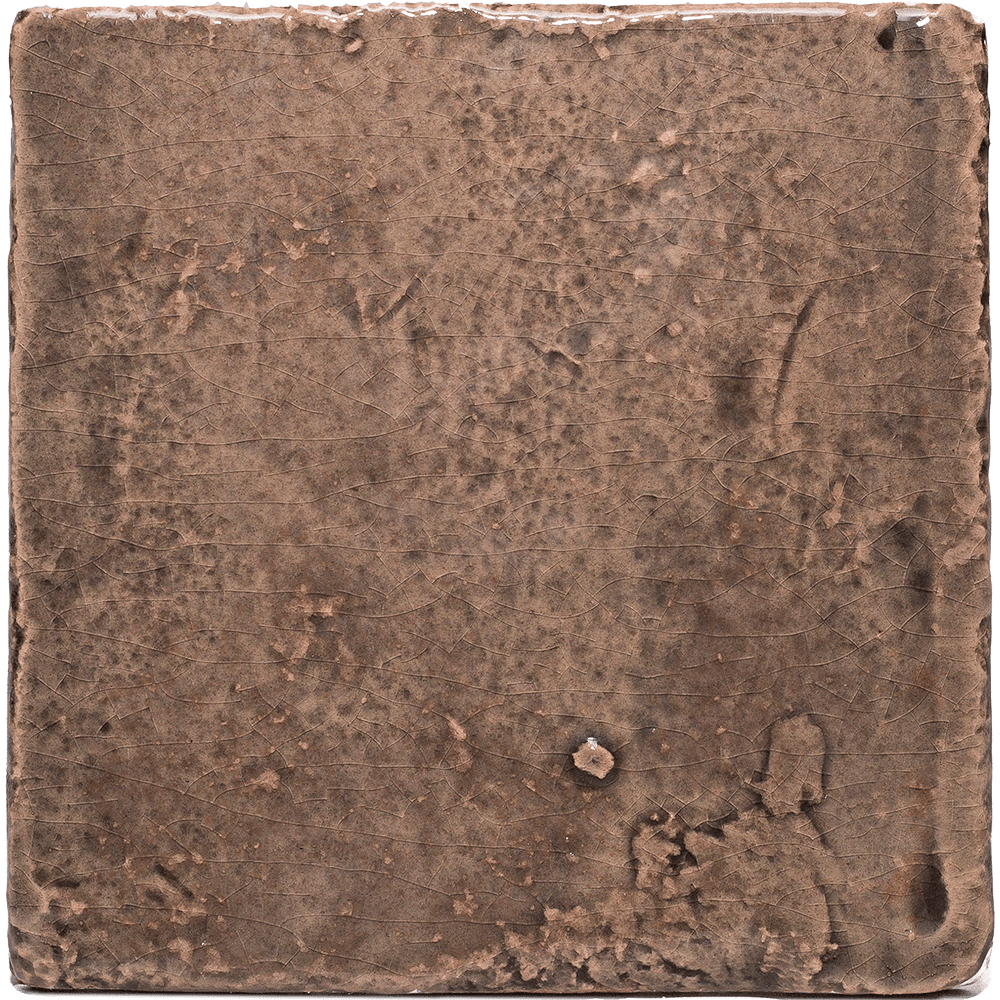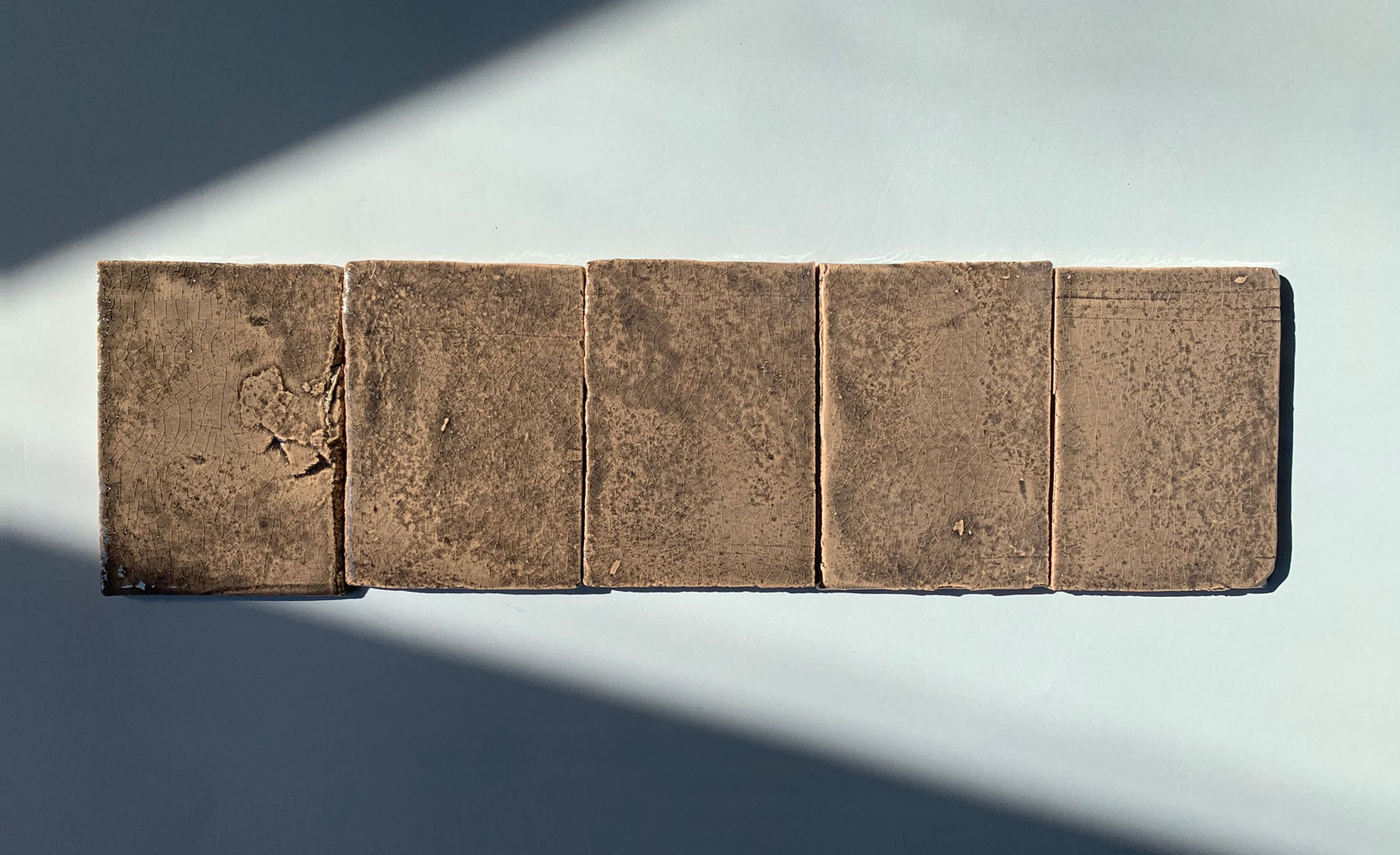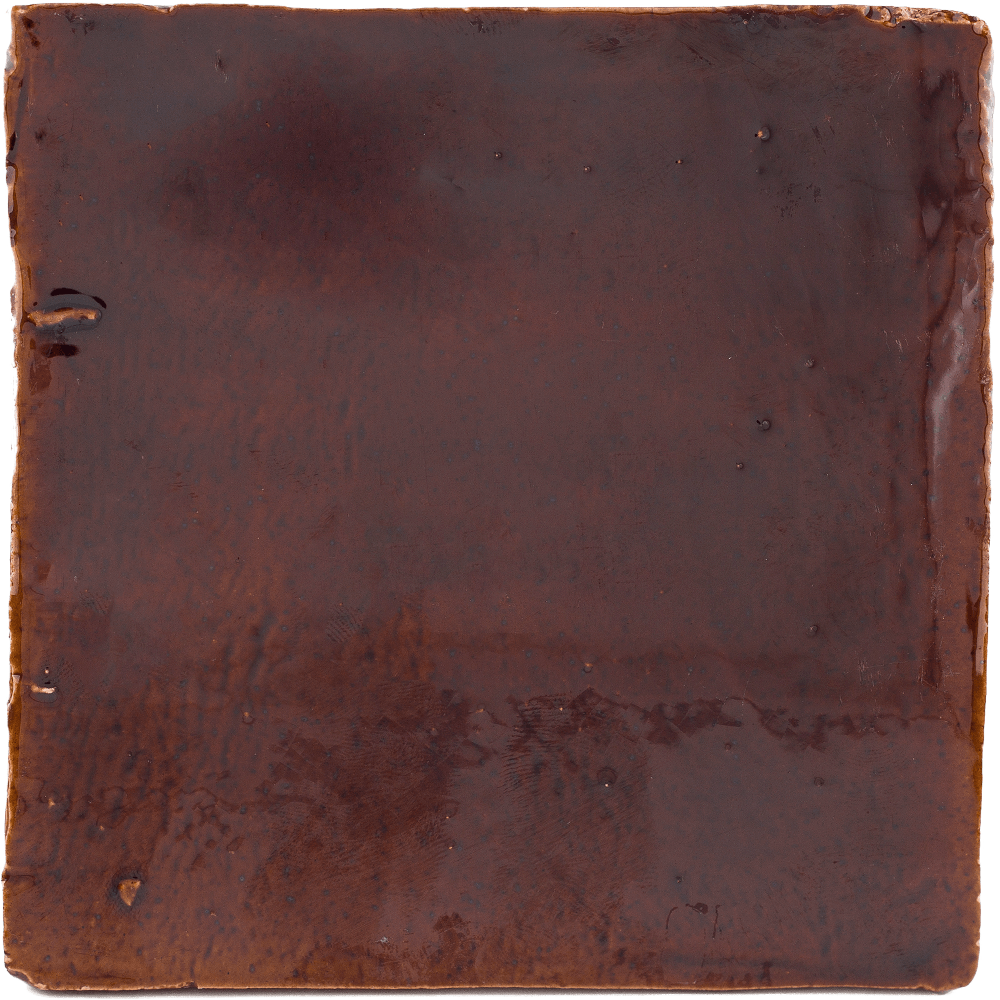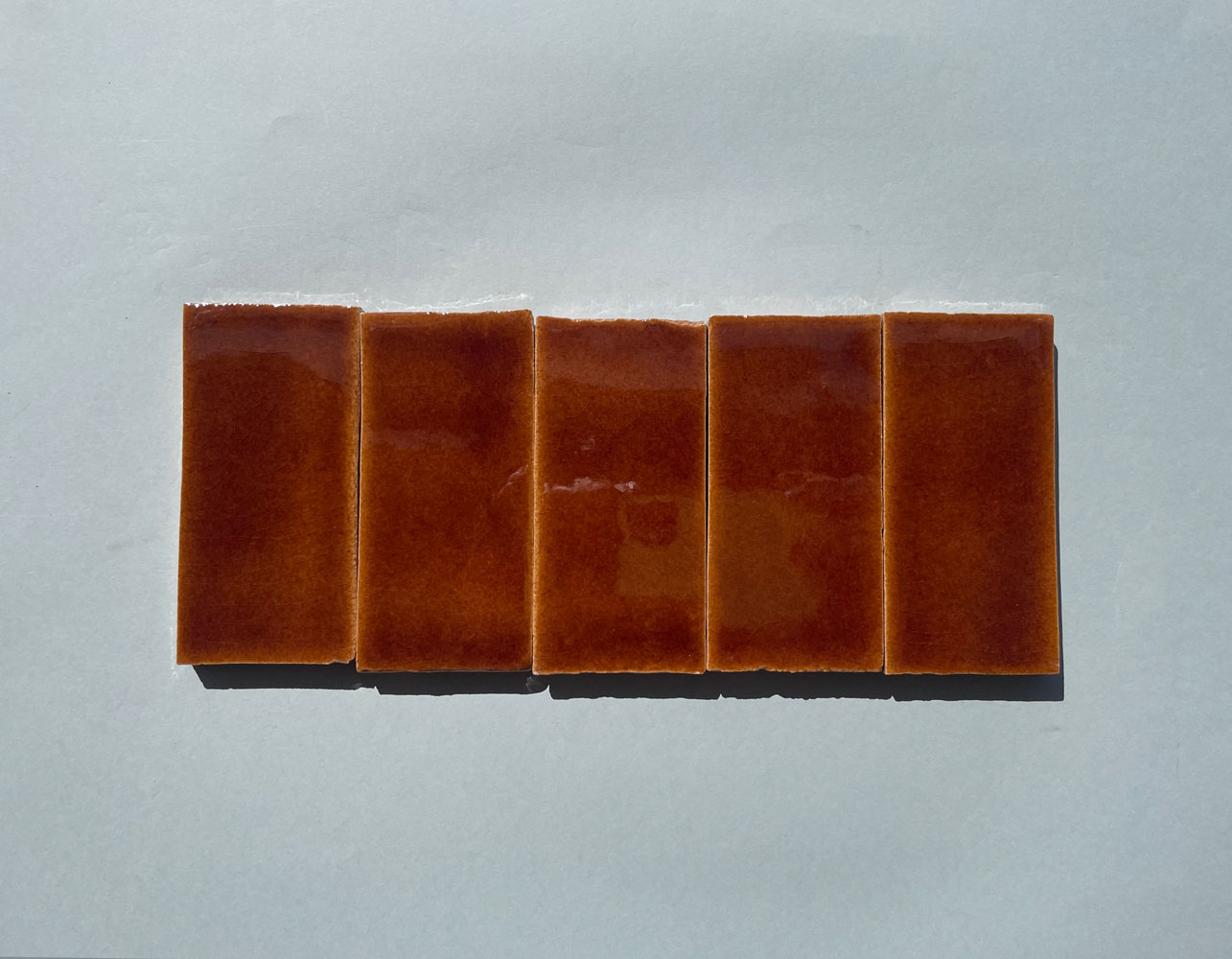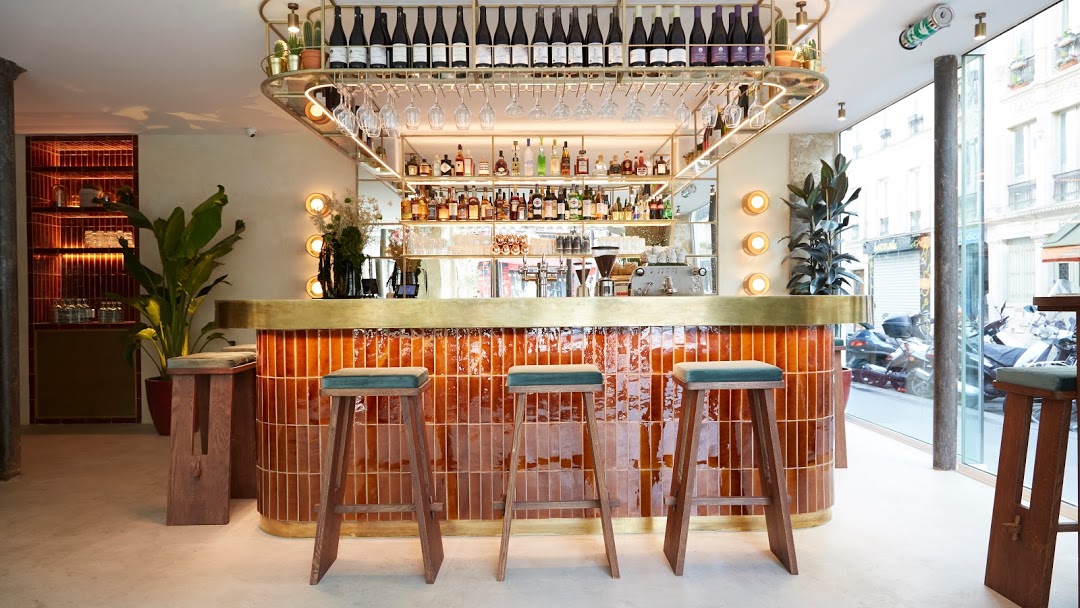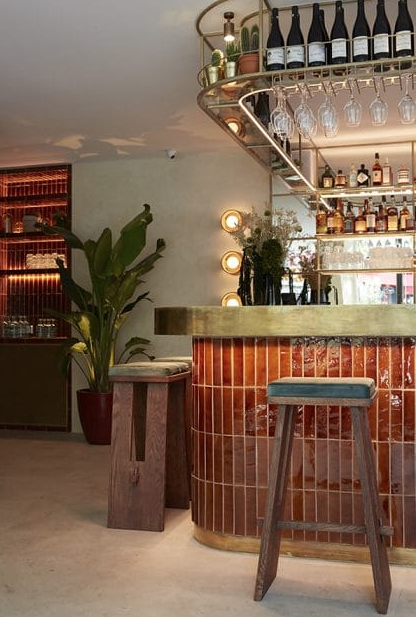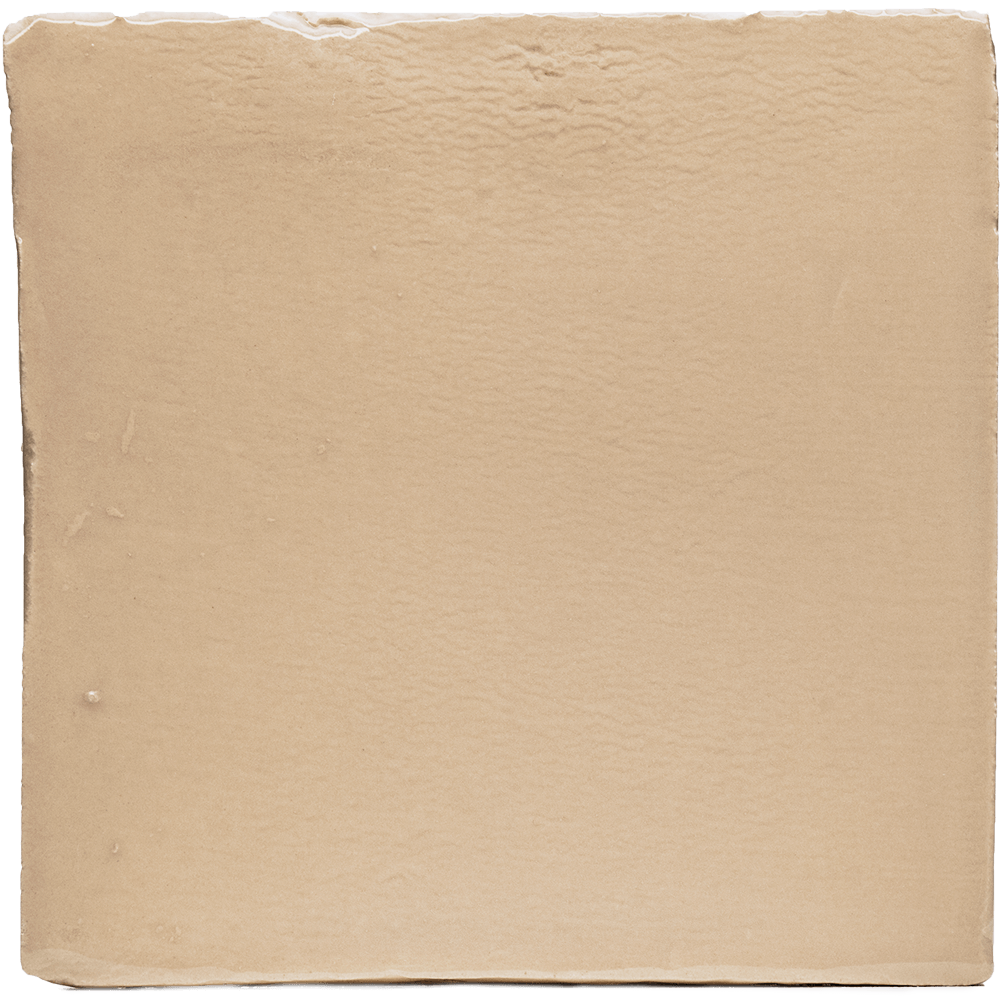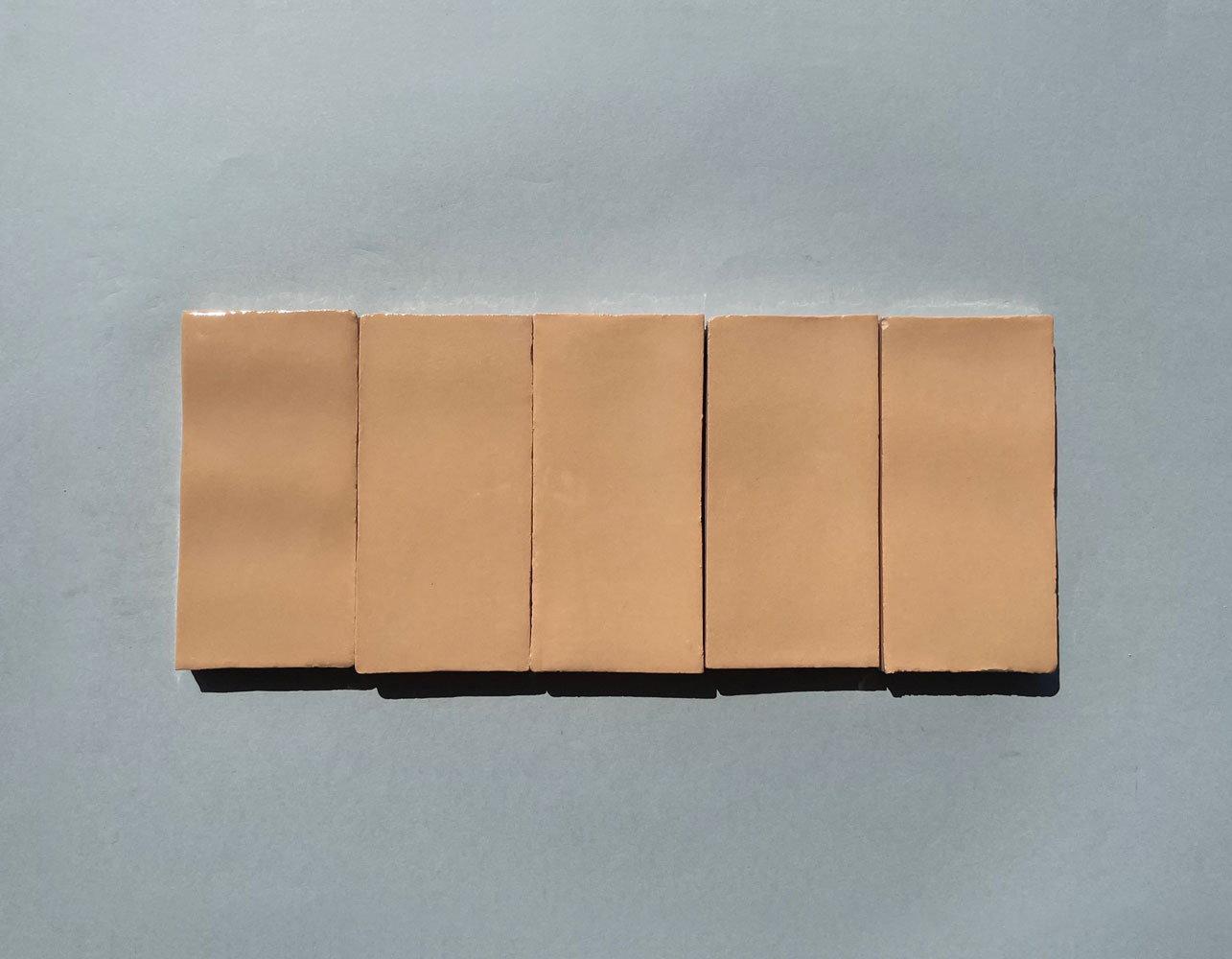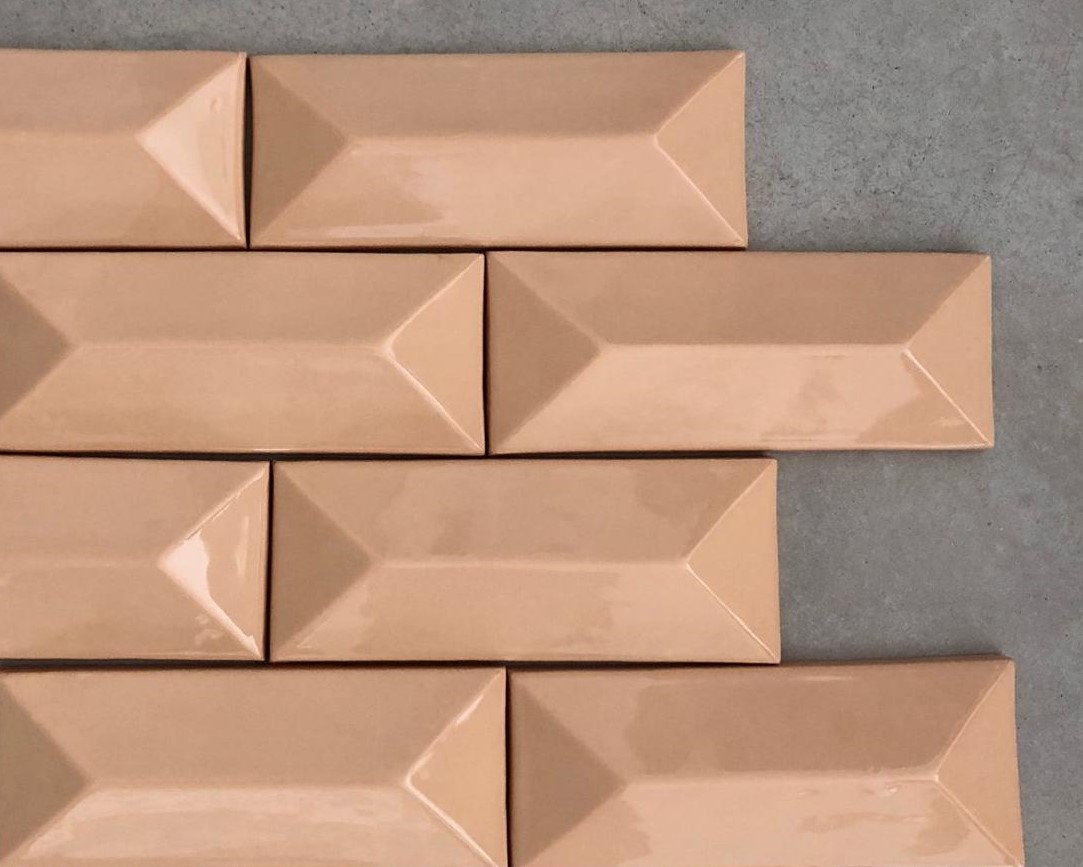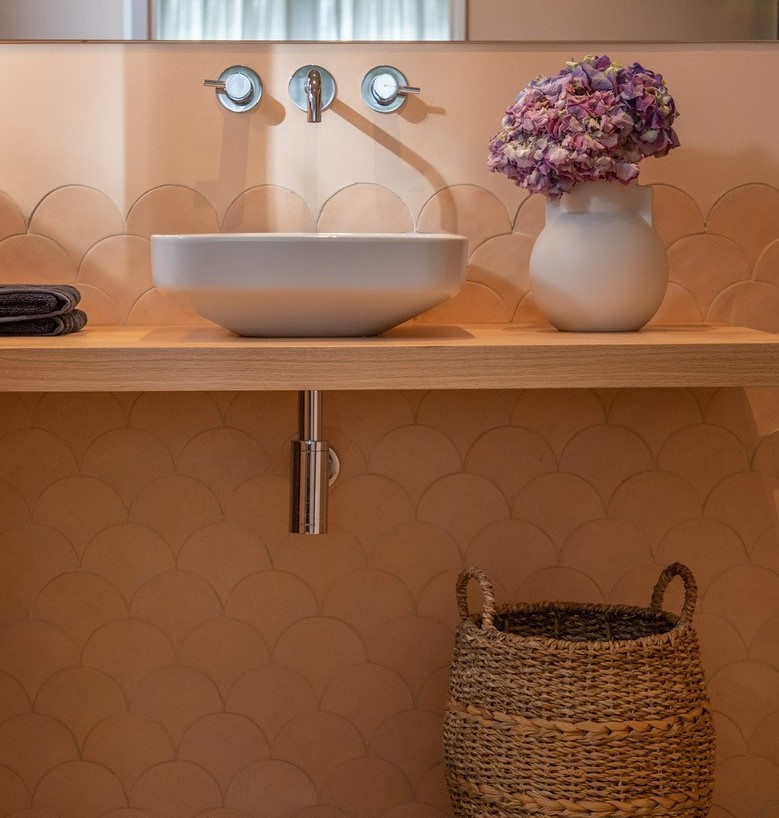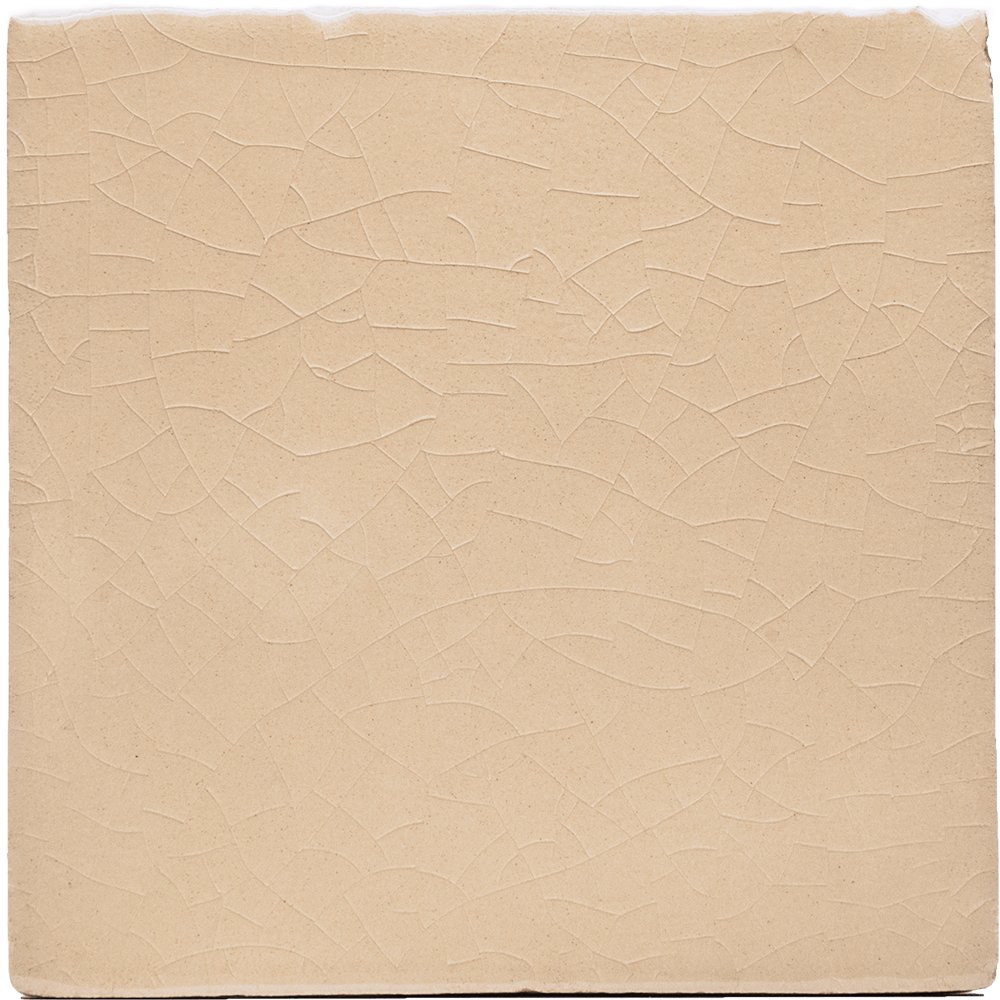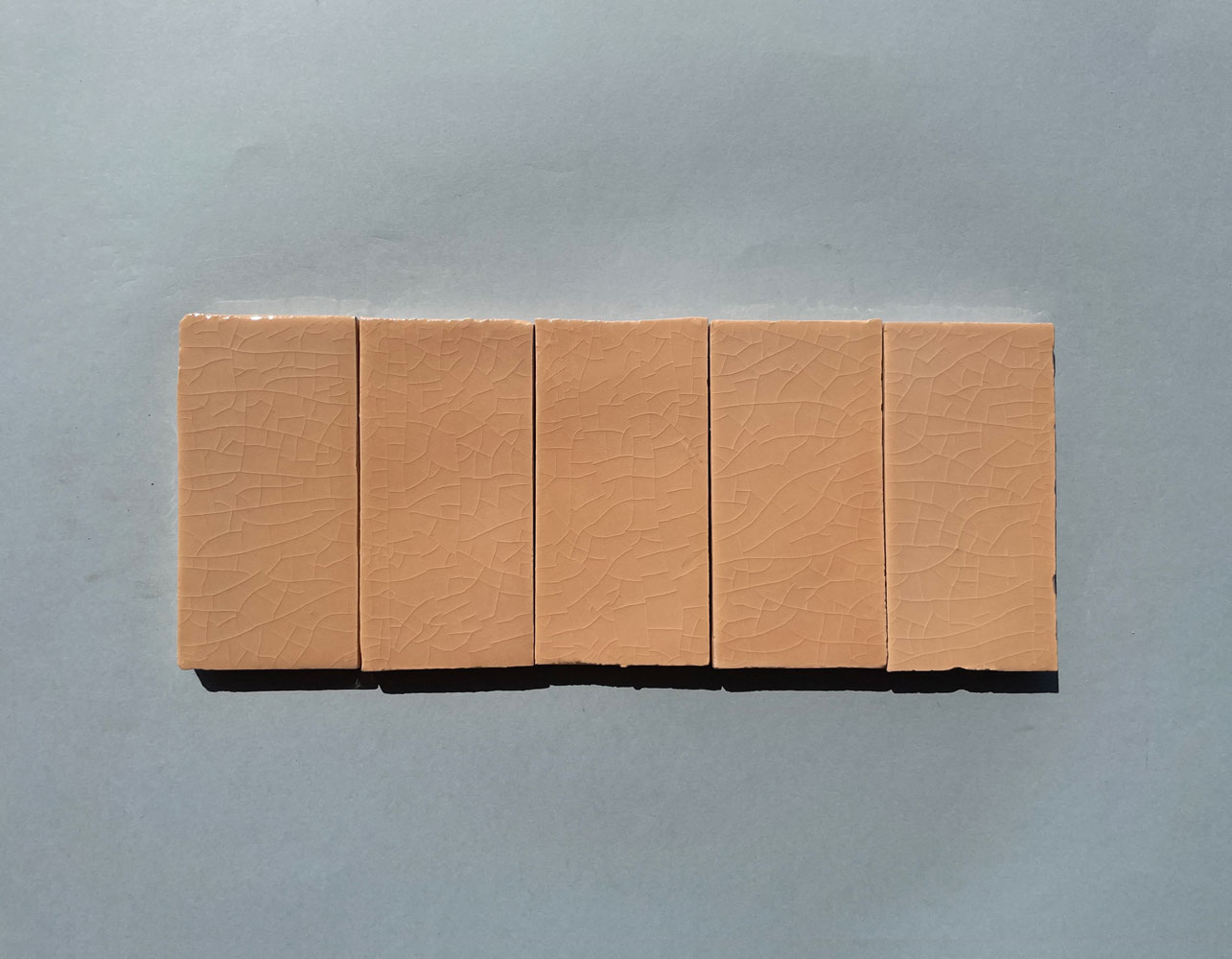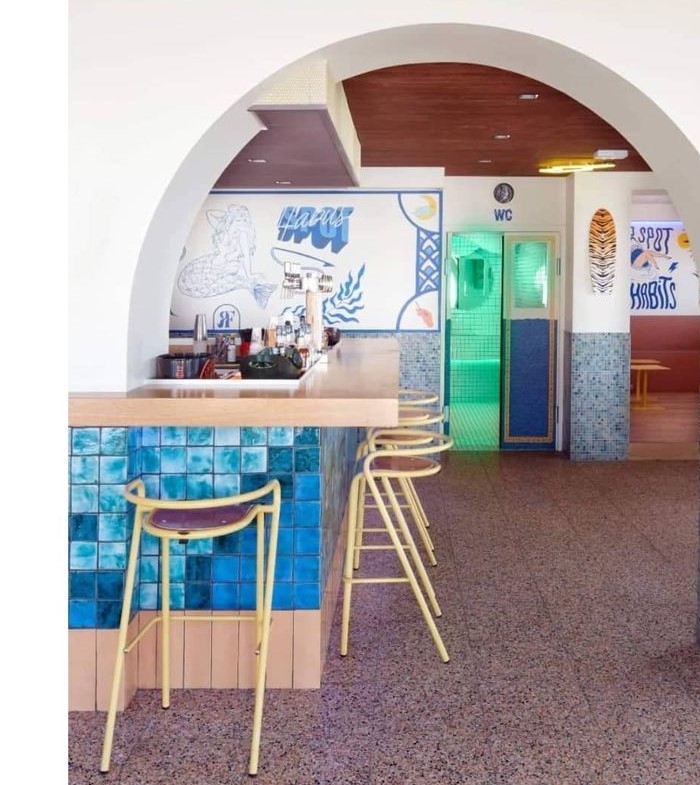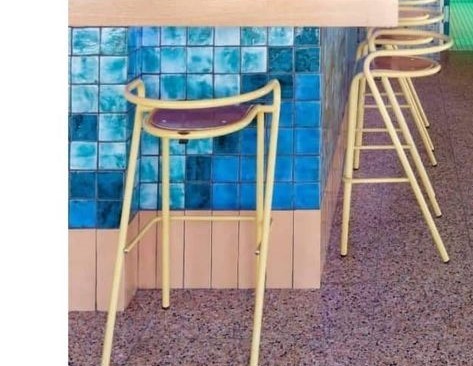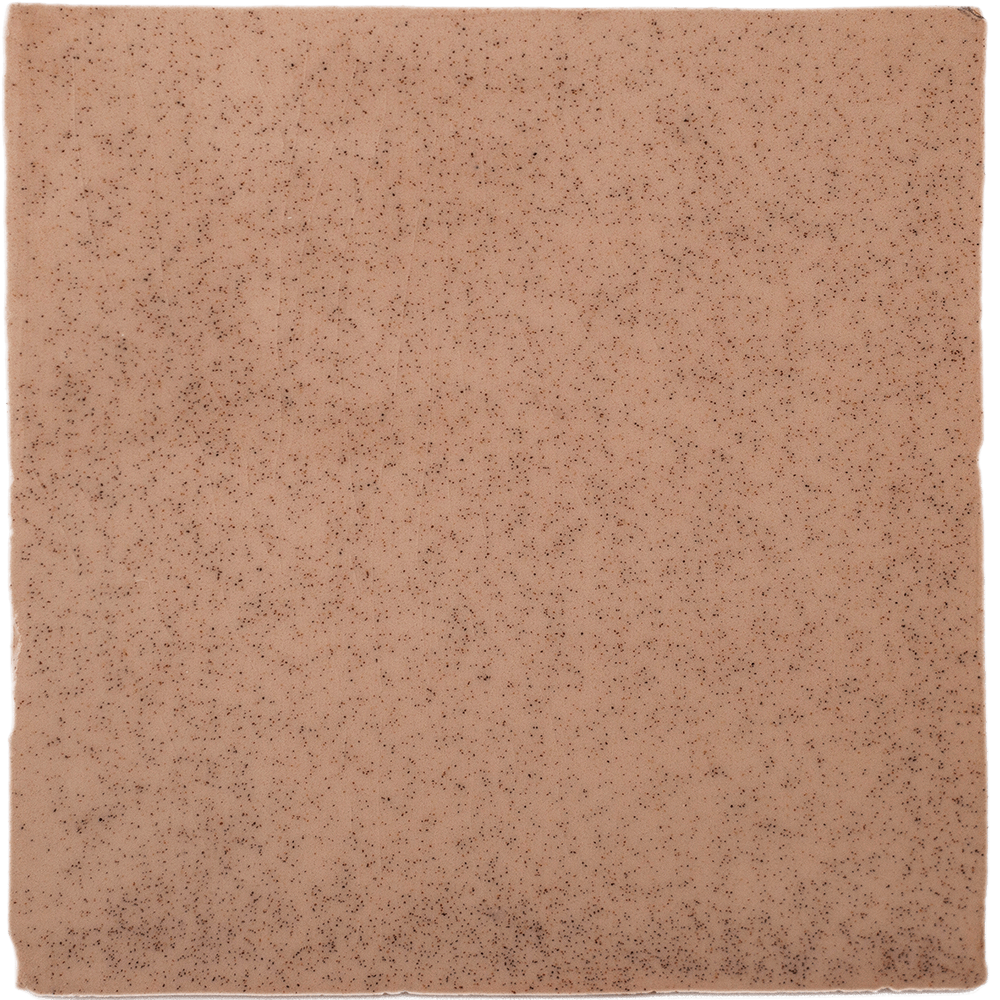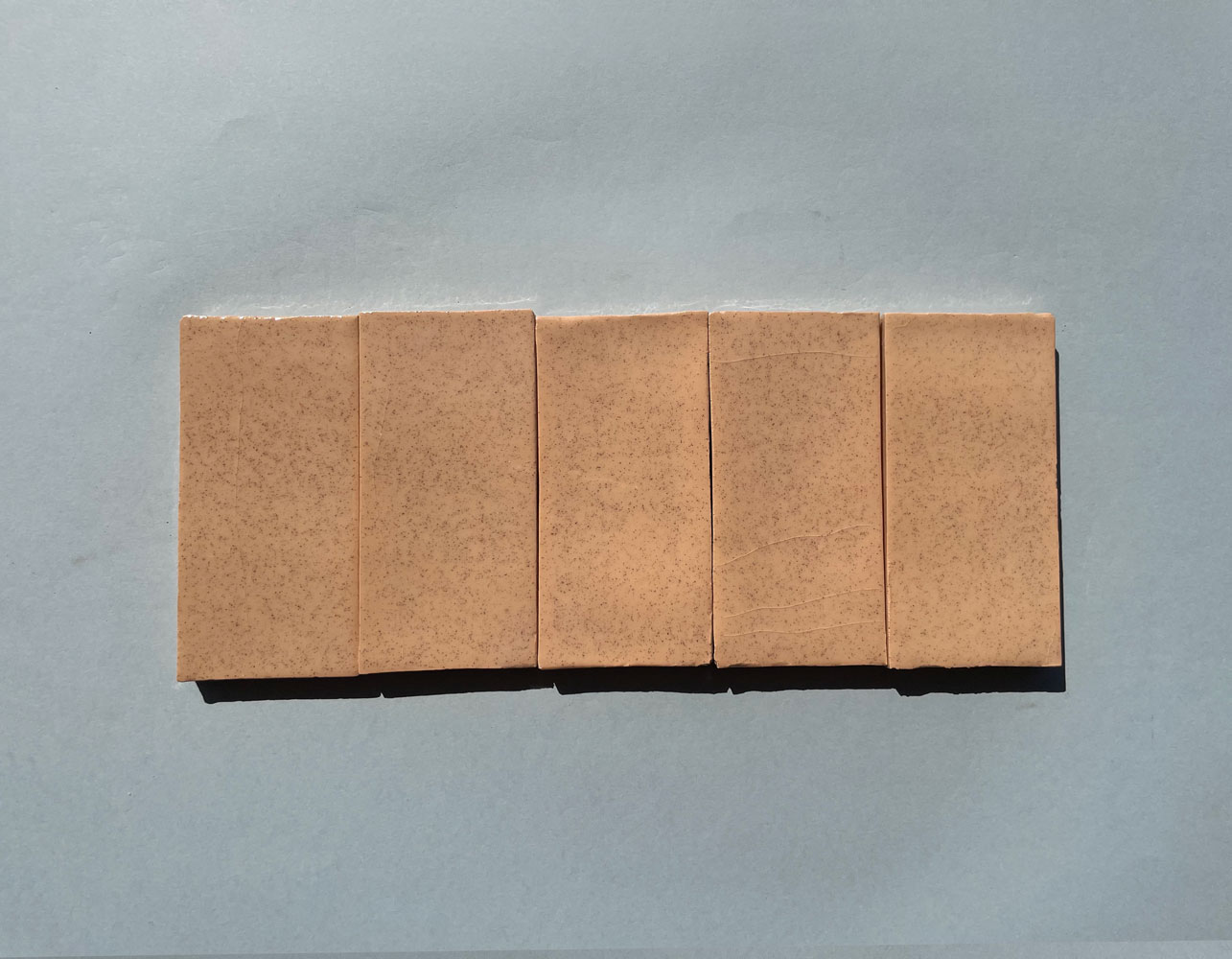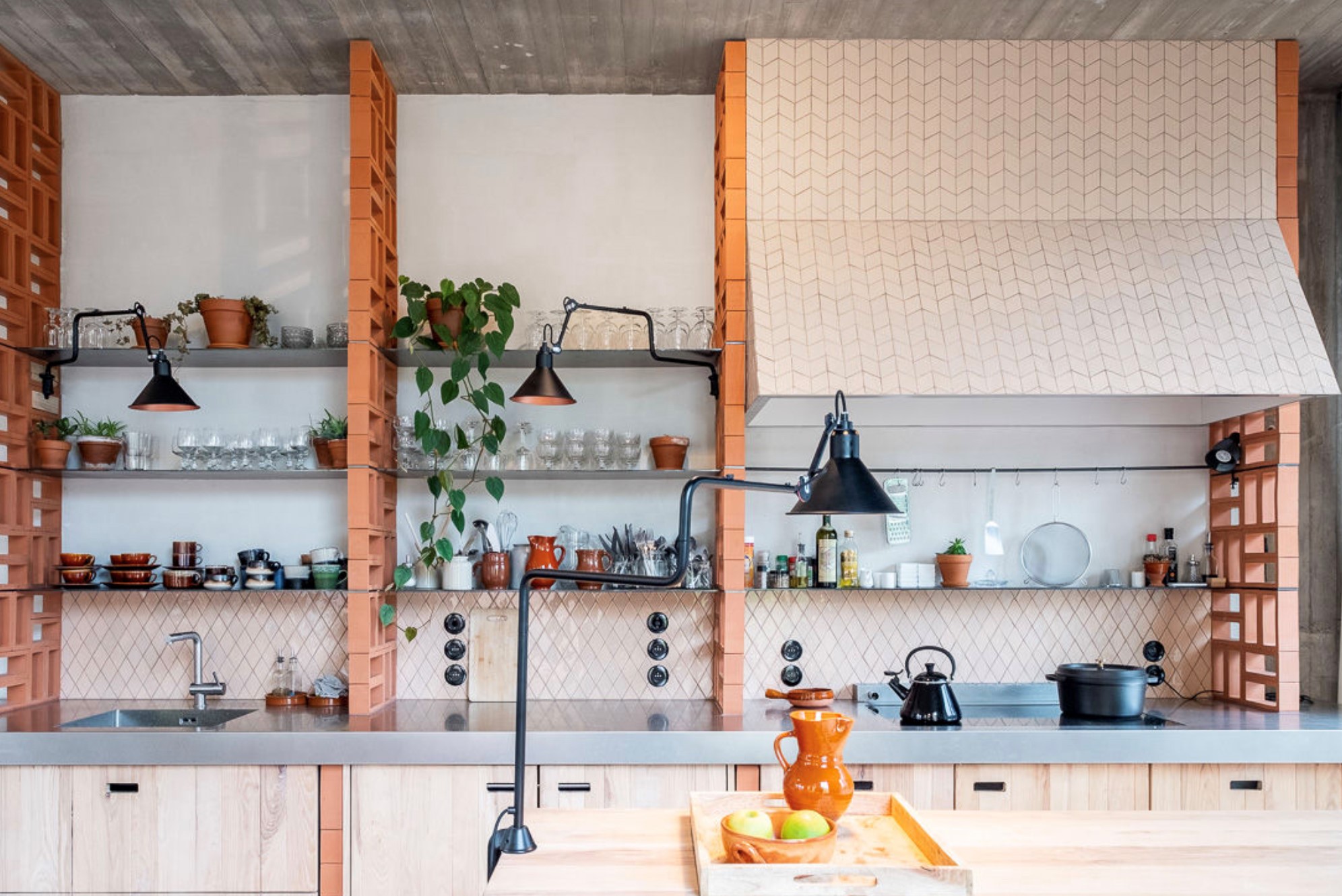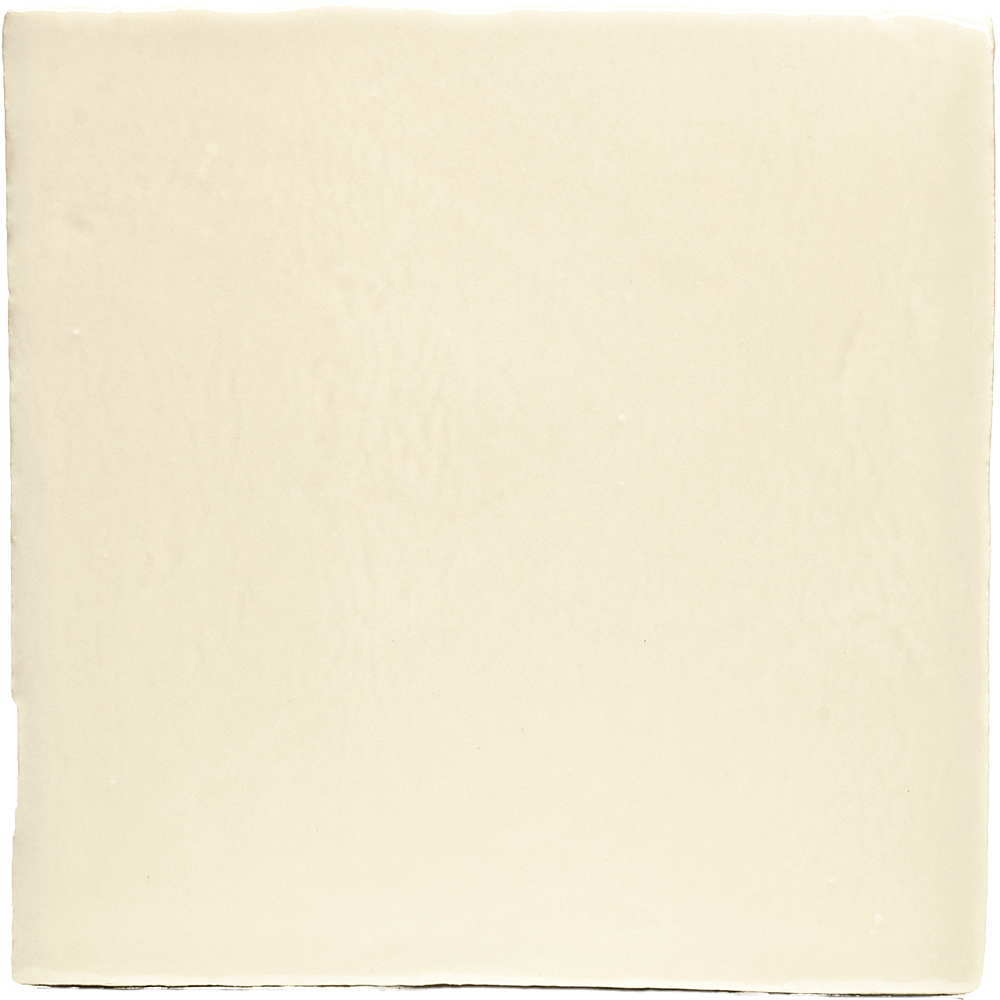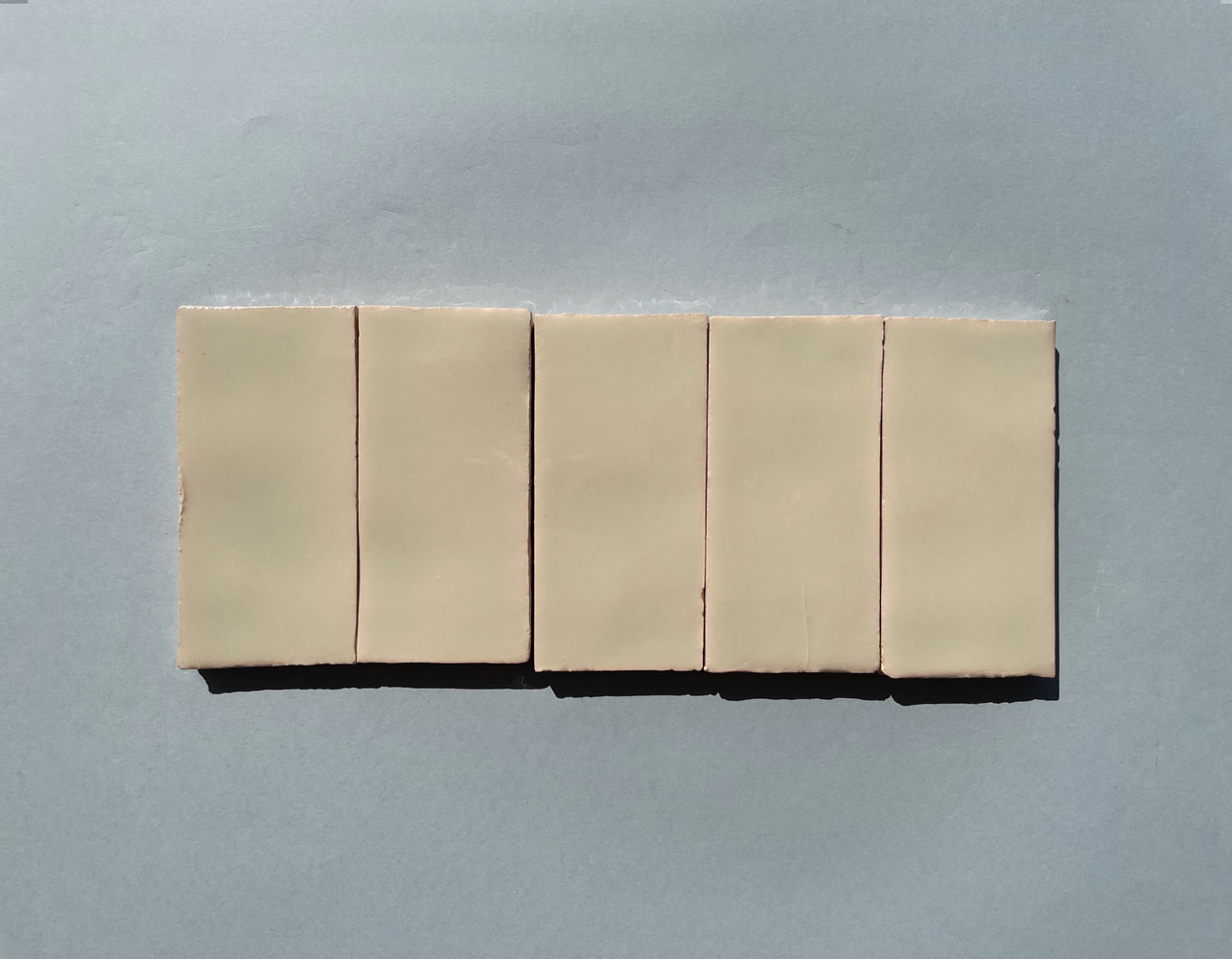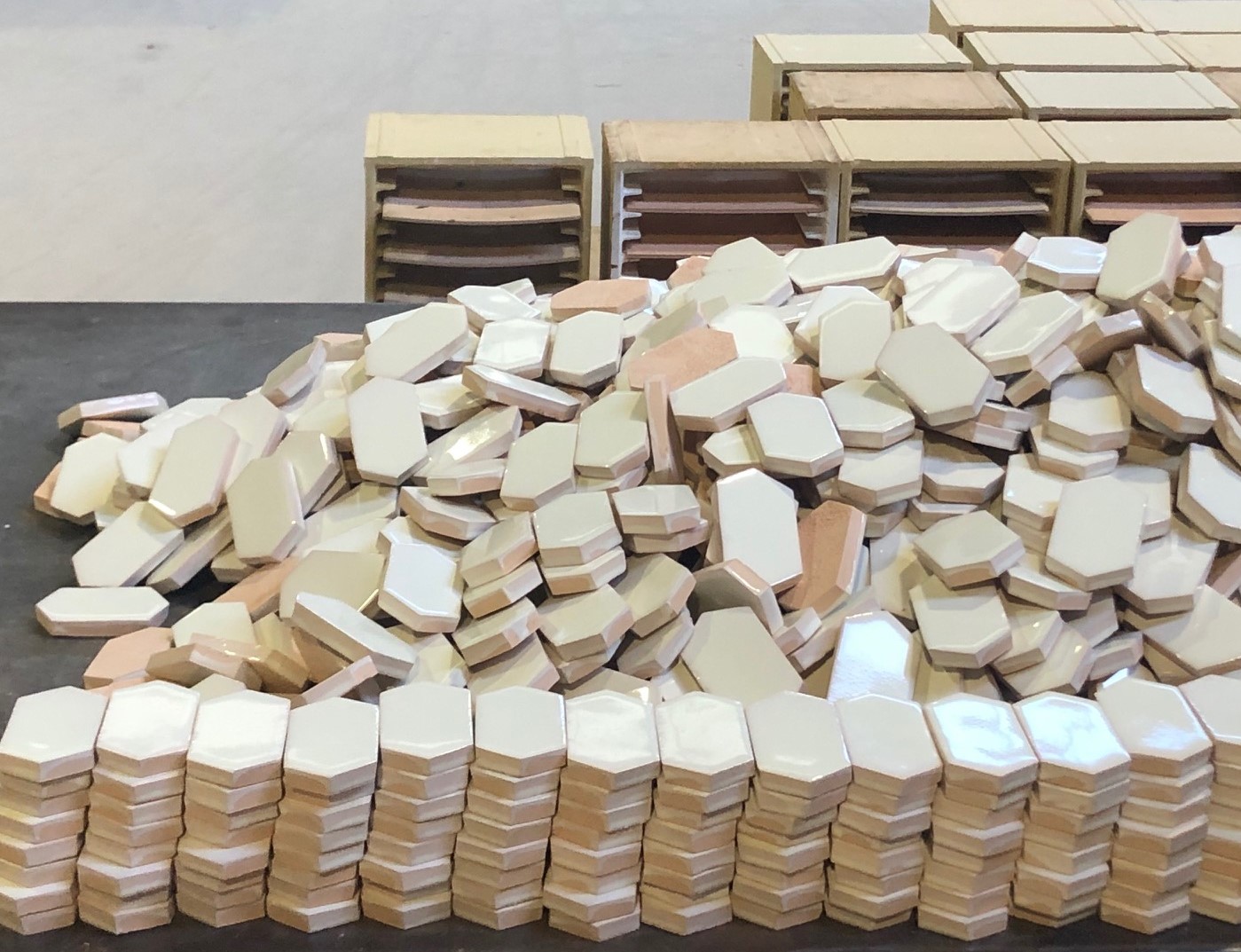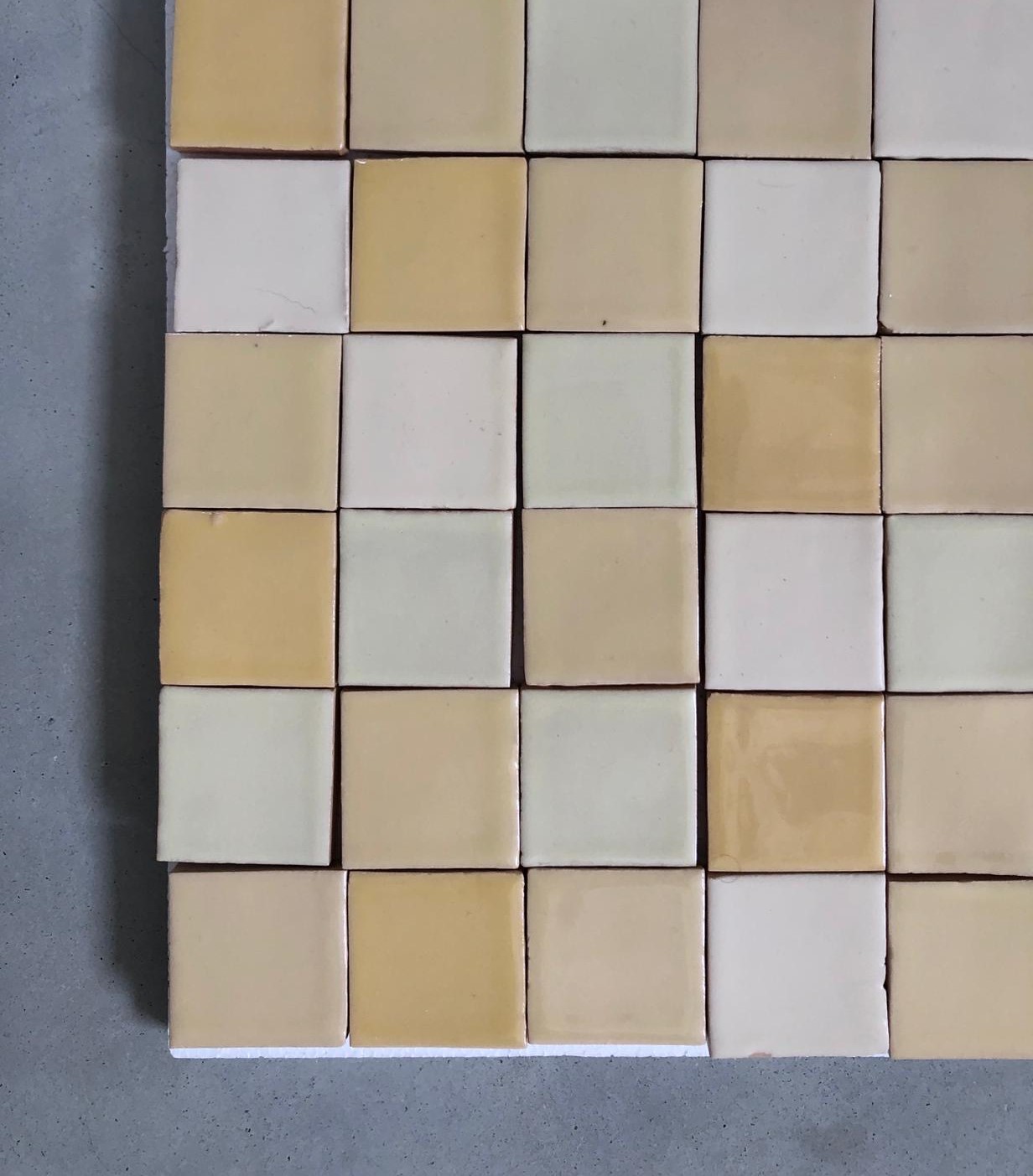The collection features 188 subtle, luminous, semi-transparent, deep, metallic colours.
D024
Dry Josefa
| Glaze Finish | Bisque impregnated |
| Shade Variation | Moderate |
| Long Term Crazing | No |
| Pre-Grout Seal | Yes |
| Shower, Saunas and Steam Rooms | No |
| Pools, Lakes and Fountains | No |
| Exterior Facade | Yes |
Craquelé is the appearance of fine cracks in the glaze, also called crackle. The size and distribution of crazing will vary from tile to tile. Crazing can be enhanced with stains or sealed to minimize the effect.
Crazing is not a defect, but a decorative effect that is deliberately induced, usually known as artistic craquelé. All craquelé glazes should be sealed before grouting.
Variation is inherent to the handmade process and is intentional.
Low > Tile can vary slightly.
This glaze has subtle variation in tone and texture.
Moderate > Tile can vary slightly to moderately.
This glaze has clear and noticeable variation in tone and texture.
High > Tile can vary significantly.
This glaze is created by multiple layers of different colour glazes applied or glazes with extreme reactions in firing resulting in significant changes in colour, tone and texture.
It is recommended that the range be viewed before selection.
Very High > Tile can show a dramatic and random variation.
This random glaze expression varies greatly from light to dark tones, texture and also shifts in colour. It is recommended that the range be viewed before selection.
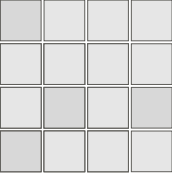


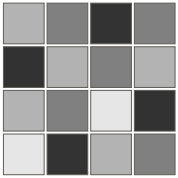
LOW
MODERATE
HIGH
VERY HIGH
Tonal Variation
From light to dark within the same colour. A single tile can only show one tone and is not a complete representation of the glaze’s tonal range.
Textural Variation
Textural variation refers to the smoothness or mottling of a glaze. This includes size and density of crazing, crystal growth and other decorative techniques.
As with all types of variation, the texture will vary from tile to tile within a batch.
Colour Variation
Colour variation is the shift from one hue to another within one glaze.
Glazes that display shifts in colour will do so from tile to tile and with some glazes within a single tile.
Long Term Crazing
According to Determination of Crazing Resistance test results, EN ISO 10545-11 / ASTM C 424-93.
Pools, Lakes and Fountains
According to Determination of Crazing Resistance test results, EN ISO 10545-11 / ASTM C 424-93. According to Determination of Chemical Resistance test results, EN ISO 10545-13 / ASTM C 650-04.
Exterior Facades
According to Determination of Frost Resistance test results, EN ISO 10545-12 (limit at – 20oC ).
D010
Dry Basilio
| Glaze Finish | Bisque impregnated |
| Shade Variation | Moderate |
| Long Term Crazing | No |
| Pre-Grout Seal | Yes |
| Shower, Saunas and Steam Rooms | No |
| Pools, Lakes and Fountains | No |
| Exterior Facade | Yes |
Craquelé is the appearance of fine cracks in the glaze, also called crackle. The size and distribution of crazing will vary from tile to tile. Crazing can be enhanced with stains or sealed to minimize the effect.
Crazing is not a defect, but a decorative effect that is deliberately induced, usually known as artistic craquelé. All craquelé glazes should be sealed before grouting.
Variation is inherent to the handmade process and is intentional.
Low > Tile can vary slightly.
This glaze has subtle variation in tone and texture.
Moderate > Tile can vary slightly to moderately.
This glaze has clear and noticeable variation in tone and texture.
High > Tile can vary significantly.
This glaze is created by multiple layers of different colour glazes applied or glazes with extreme reactions in firing resulting in significant changes in colour, tone and texture.
It is recommended that the range be viewed before selection
Very High > Tile can show a dramatic and random variation.
This random glaze expression varies greatly from light to dark tones, texture and also shifts in colour.
It is recommended that the range be viewed before selection.




LOW
MODERATE
HIGH
VERY HIGH
Tonal Variation
From light to dark within the same colour. A single tile can only show one tone and is not a complete representation of the glaze’s tonal range.
Textural Variation
Textural variation refers to the smoothness or mottling of a glaze. This includes size and density of crazing, crystal growth and other decorative techniques.
As with all types of variation, the texture will vary from tile to tile within a batch.
Colour Variation
Colour variation is the shift from one hue to another within one glaze.
Glazes that display shifts in colour will do so from tile to tile and with some glazes within a single tile.
Long Term Crazing
According to Determination of Crazing Resistance test results, EN ISO 10545-11 / ASTM C 424-93.
Pools, Lakes and Fountains
According to Determination of Crazing Resistance test results, EN ISO 10545-11 / ASTM C 424-93. According to Determination of Chemical Resistance test results, EN ISO 10545-13 / ASTM C 650-04.
Exterior Facades
According to Determination of Frost Resistance test results, EN ISO 10545-12 (limit at – 20oC ).
D022
Dry Joaquina
| Glaze Finish | Bisque impregnated |
| Shade Variation | Moderate |
| Long Term Crazing | No |
| Pre-Grout Seal | Yes |
| Shower, Saunas and Steam Rooms | No |
| Pools, Lakes and Fountains | No |
| Exterior Facade | Yes |
Craquelé is the appearance of fine cracks in the glaze, also called crackle. The size and distribution of crazing will vary from tile to tile. Crazing can be enhanced with stains or sealed to minimize the effect.
Crazing is not a defect, but a decorative effect that is deliberately induced, usually known as artistic craquelé. All craquelé glazes should be sealed before grouting.
Variation is inherent to the handmade process and is intentional.
Low > Tile can vary slightly.
This glaze has subtle variation in tone and texture.
Moderate > Tile can vary slightly to moderately.
This glaze has clear and noticeable variation in tone and texture.
High > Tile can vary significantly.
This glaze is created by multiple layers of different colour glazes applied or glazes with extreme reactions in firing resulting in significant changes in colour, tone and texture.
It is recommended that the range be viewed before selection
Very High > Tile can show a dramatic and random variation.
This random glaze expression varies greatly from light to dark tones, texture and also shifts in colour.
It is recommended that the range be viewed before selection.




LOW
MODERATE
HIGH
VERY HIGH
Tonal Variation
From light to dark within the same colour. A single tile can only show one tone and is not a complete representation of the glaze’s tonal range.
Textural Variation
Textural variation refers to the smoothness or mottling of a glaze. This includes size and density of crazing, crystal growth and other decorative techniques.
As with all types of variation, the texture will vary from tile to tile within a batch.
Colour Variation
Colour variation is the shift from one hue to another within one glaze.
Glazes that display shifts in colour will do so from tile to tile and with some glazes within a single tile.
Long Term Crazing
According to Determination of Crazing Resistance test results, EN ISO 10545-11 / ASTM C 424-93.
Pools, Lakes and Fountains
According to Determination of Crazing Resistance test results, EN ISO 10545-11 / ASTM C 424-93. According to Determination of Chemical Resistance test results, EN ISO 10545-13 / ASTM C 650-04.
Exterior Facades
According to Determination of Frost Resistance test results, EN ISO 10545-12 (limit at – 20oC ).
D020
Dry Valentina
| Glaze Finish | Bisque impregnated |
| Shade Variation | Moderate |
| Long Term Crazing | No |
| Pre-Grout Seal | Yes |
| Shower, Saunas and Steam Rooms | No |
| Pools, Lakes and Fountains | No |
| Exterior Facade | Yes |
Craquelé is the appearance of fine cracks in the glaze, also called crackle. The size and distribution of crazing will vary from tile to tile. Crazing can be enhanced with stains or sealed to minimize the effect.
Crazing is not a defect, but a decorative effect that is deliberately induced, usually known as artistic craquelé. All craquelé glazes should be sealed before grouting.
Variation is inherent to the handmade process and is intentional.
Low > Tile can vary slightly.
This glaze has subtle variation in tone and texture.
Moderate > Tile can vary slightly to moderately.
This glaze has clear and noticeable variation in tone and texture.
High > Tile can vary significantly.
This glaze is created by multiple layers of different colour glazes applied or glazes with extreme reactions in firing resulting in significant changes in colour, tone and texture.
It is recommended that the range be viewed before selection
Very High > Tile can show a dramatic and random variation.
This random glaze expression varies greatly from light to dark tones, texture and also shifts in colour.
It is recommended that the range be viewed before selection.




LOW
MODERATE
HIGH
VERY HIGH
Tonal Variation
From light to dark within the same colour. A single tile can only show one tone and is not a complete representation of the glaze’s tonal range.
Textural Variation
Textural variation refers to the smoothness or mottling of a glaze. This includes size and density of crazing, crystal growth and other decorative techniques.
As with all types of variation, the texture will vary from tile to tile within a batch.
Colour Variation
Colour variation is the shift from one hue to another within one glaze.
Glazes that display shifts in colour will do so from tile to tile and with some glazes within a single tile.
Long Term Crazing
According to Determination of Crazing Resistance test results, EN ISO 10545-11 / ASTM C 424-93.
Pools, Lakes and Fountains
According to Determination of Crazing Resistance test results, EN ISO 10545-11 / ASTM C 424-93. According to Determination of Chemical Resistance test results, EN ISO 10545-13 / ASTM C 650-04.
Exterior Facades
According to Determination of Frost Resistance test results, EN ISO 10545-12 (limit at – 20oC ).
D044
Dry Ernesto
| Glaze Finish | Bisque impregnated |
| Shade Variation | High |
| Long Term Crazing | No |
| Pre-Grout Seal | Yes |
| Shower, Saunas and Steam Rooms | No |
| Pools, Lakes and Fountains | No |
| Exterior Facade | Yes |
Craquelé is the appearance of fine cracks in the glaze, also called crackle. The size and distribution of crazing will vary from tile to tile. Crazing can be enhanced with stains or sealed to minimize the effect.
Crazing is not a defect, but a decorative effect that is deliberately induced, usually known as artistic craquelé. All craquelé glazes should be sealed before grouting.
Variation is inherent to the handmade process and is intentional.
Low > Tile can vary slightly.
This glaze has subtle variation in tone and texture.
Moderate > Tile can vary slightly to moderately.
This glaze has clear and noticeable variation in tone and texture.
High > Tile can vary significantly.
This glaze is created by multiple layers of different colour glazes applied or glazes with extreme reactions in firing resulting in significant changes in colour, tone and texture.
It is recommended that the range be viewed before selection
Very High > Tile can show a dramatic and random variation.
This random glaze expression varies greatly from light to dark tones, texture and also shifts in colour.
It is recommended that the range be viewed before selection.




LOW
MODERATE
HIGH
VERY HIGH
Tonal Variation
From light to dark within the same colour. A single tile can only show one tone and is not a complete representation of the glaze’s tonal range.
Textural Variation
Textural variation refers to the smoothness or mottling of a glaze. This includes size and density of crazing, crystal growth and other decorative techniques.
As with all types of variation, the texture will vary from tile to tile within a batch.
Colour Variation
Colour variation is the shift from one hue to another within one glaze.
Glazes that display shifts in colour will do so from tile to tile and with some glazes within a single tile.
Long Term Crazing
According to Determination of Crazing Resistance test results, EN ISO 10545-11 / ASTM C 424-93.
Pools, Lakes and Fountains
According to Determination of Crazing Resistance test results, EN ISO 10545-11 / ASTM C 424-93. According to Determination of Chemical Resistance test results, EN ISO 10545-13 / ASTM C 650-04.
Exterior Facades
According to Determination of Frost Resistance test results, EN ISO 10545-12 (limit at – 20oC ).
D042
Dry Alberto
| Glaze Finish | Bisque impregnated |
| Shade Variation | High |
| Long Term Crazing | No |
| Pre-Grout Seal | Yes |
| Shower, Saunas and Steam Rooms | No |
| Pools, Lakes and Fountains | No |
| Exterior Facade | Yes |
Craquelé is the appearance of fine cracks in the glaze, also called crackle. The size and distribution of crazing will vary from tile to tile. Crazing can be enhanced with stains or sealed to minimize the effect.
Crazing is not a defect, but a decorative effect that is deliberately induced, usually known as artistic craquelé. All craquelé glazes should be sealed before grouting.
Variation is inherent to the handmade process and is intentional.
Low > Tile can vary slightly.
This glaze has subtle variation in tone and texture.
Moderate > Tile can vary slightly to moderately.
This glaze has clear and noticeable variation in tone and texture.
High > Tile can vary significantly.
This glaze is created by multiple layers of different colour glazes applied or glazes with extreme reactions in firing resulting in significant changes in colour, tone and texture.
It is recommended that the range be viewed before selection
Very High > Tile can show a dramatic and random variation.
This random glaze expression varies greatly from light to dark tones, texture and also shifts in colour.
It is recommended that the range be viewed before selection.




LOW
MODERATE
HIGH
VERY HIGH
Tonal Variation
From light to dark within the same colour. A single tile can only show one tone and is not a complete representation of the glaze’s tonal range.
Textural Variation
Textural variation refers to the smoothness or mottling of a glaze. This includes size and density of crazing, crystal growth and other decorative techniques.
As with all types of variation, the texture will vary from tile to tile within a batch.
Colour Variation
Colour variation is the shift from one hue to another within one glaze.
Glazes that display shifts in colour will do so from tile to tile and with some glazes within a single tile.
Long Term Crazing
According to Determination of Crazing Resistance test results, EN ISO 10545-11 / ASTM C 424-93.
Pools, Lakes and Fountains
According to Determination of Crazing Resistance test results, EN ISO 10545-11 / ASTM C 424-93. According to Determination of Chemical Resistance test results, EN ISO 10545-13 / ASTM C 650-04.
Exterior Facades
According to Determination of Frost Resistance test results, EN ISO 10545-12 (limit at – 20oC ).
D046
Dry Teodora
| Glaze Finish | Bisque impregnated |
| Shade Variation | Moderate |
| Long Term Crazing | No |
| Pre-Grout Seal | Yes |
| Shower, Saunas and Steam Rooms | No |
| Pools, Lakes and Fountains | No |
| Exterior Facade | Yes |
Craquelé is the appearance of fine cracks in the glaze, also called crackle. The size and distribution of crazing will vary from tile to tile. Crazing can be enhanced with stains or sealed to minimize the effect.
Crazing is not a defect, but a decorative effect that is deliberately induced, usually known as artistic craquelé. All craquelé glazes should be sealed before grouting.
Variation is inherent to the handmade process and is intentional.
Low > Tile can vary slightly.
This glaze has subtle variation in tone and texture.
Moderate > Tile can vary slightly to moderately.
This glaze has clear and noticeable variation in tone and texture.
High > Tile can vary significantly.
This glaze is created by multiple layers of different colour glazes applied or glazes with extreme reactions in firing resulting in significant changes in colour, tone and texture.
It is recommended that the range be viewed before selection
Very High > Tile can show a dramatic and random variation.
This random glaze expression varies greatly from light to dark tones, texture and also shifts in colour.
It is recommended that the range be viewed before selection.




LOW
MODERATE
HIGH
VERY HIGH
Tonal Variation
From light to dark within the same colour. A single tile can only show one tone and is not a complete representation of the glaze’s tonal range.
Textural Variation
Textural variation refers to the smoothness or mottling of a glaze. This includes size and density of crazing, crystal growth and other decorative techniques.
As with all types of variation, the texture will vary from tile to tile within a batch.
Colour Variation
Colour variation is the shift from one hue to another within one glaze.
Glazes that display shifts in colour will do so from tile to tile and with some glazes within a single tile.
Long Term Crazing
According to Determination of Crazing Resistance test results, EN ISO 10545-11 / ASTM C 424-93.
Pools, Lakes and Fountains
According to Determination of Crazing Resistance test results, EN ISO 10545-11 / ASTM C 424-93. According to Determination of Chemical Resistance test results, EN ISO 10545-13 / ASTM C 650-04.
Exterior Facades
According to Determination of Frost Resistance test results, EN ISO 10545-12 (limit at – 20oC ).
D026
Dry Florbela
| Glaze Finish | Bisque impregnated |
| Shade Variation | Moderate |
| Long Term Crazing | No |
| Pre-Grout Seal | Yes |
| Shower, Saunas and Steam Rooms | No |
| Pools, Lakes and Fountains | No |
| Exterior Facade | Yes |
Craquelé is the appearance of fine cracks in the glaze, also called crackle. The size and distribution of crazing will vary from tile to tile. Crazing can be enhanced with stains or sealed to minimize the effect.
Crazing is not a defect, but a decorative effect that is deliberately induced, usually known as artistic craquelé. All craquelé glazes should be sealed before grouting.
Variation is inherent to the handmade process and is intentional.
Low > Tile can vary slightly.
This glaze has subtle variation in tone and texture.
Moderate > Tile can vary slightly to moderately.
This glaze has clear and noticeable variation in tone and texture.
High > Tile can vary significantly.
This glaze is created by multiple layers of different colour glazes applied or glazes with extreme reactions in firing resulting in significant changes in colour, tone and texture.
It is recommended that the range be viewed before selection
Very High > Tile can show a dramatic and random variation.
This random glaze expression varies greatly from light to dark tones, texture and also shifts in colour.
It is recommended that the range be viewed before selection.




LOW
MODERATE
HIGH
VERY HIGH
Tonal Variation
From light to dark within the same colour. A single tile can only show one tone and is not a complete representation of the glaze’s tonal range.
Textural Variation
Textural variation refers to the smoothness or mottling of a glaze. This includes size and density of crazing, crystal growth and other decorative techniques.
As with all types of variation, the texture will vary from tile to tile within a batch.
Colour Variation
Colour variation is the shift from one hue to another within one glaze.
Glazes that display shifts in colour will do so from tile to tile and with some glazes within a single tile.
Long Term Crazing
According to Determination of Crazing Resistance test results, EN ISO 10545-11 / ASTM C 424-93.
Pools, Lakes and Fountains
According to Determination of Crazing Resistance test results, EN ISO 10545-11 / ASTM C 424-93. According to Determination of Chemical Resistance test results, EN ISO 10545-13 / ASTM C 650-04.
Exterior Facades
According to Determination of Frost Resistance test results, EN ISO 10545-12 (limit at – 20oC ).
D032
Dry Amalia
| Glaze Finish | Bisque impregnated |
| Shade Variation | Moderate |
| Long Term Crazing | No |
| Pre-Grout Seal | Yes |
| Shower, Saunas and Steam Rooms | No |
| Pools, Lakes and Fountains | No |
| Exterior Facade | Yes |
Craquelé is the appearance of fine cracks in the glaze, also called crackle. The size and distribution of crazing will vary from tile to tile. Crazing can be enhanced with stains or sealed to minimize the effect.
Crazing is not a defect, but a decorative effect that is deliberately induced, usually known as artistic craquelé. All craquelé glazes should be sealed before grouting.
Variation is inherent to the handmade process and is intentional.
Low > Tile can vary slightly.
This glaze has subtle variation in tone and texture.
Moderate > Tile can vary slightly to moderately.
This glaze has clear and noticeable variation in tone and texture.
High > Tile can vary significantly.
This glaze is created by multiple layers of different colour glazes applied or glazes with extreme reactions in firing resulting in significant changes in colour, tone and texture.
It is recommended that the range be viewed before selection
Very High > Tile can show a dramatic and random variation.
This random glaze expression varies greatly from light to dark tones, texture and also shifts in colour.
It is recommended that the range be viewed before selection.




LOW
MODERATE
HIGH
VERY HIGH
Tonal Variation
From light to dark within the same colour. A single tile can only show one tone and is not a complete representation of the glaze’s tonal range.
Textural Variation
Textural variation refers to the smoothness or mottling of a glaze. This includes size and density of crazing, crystal growth and other decorative techniques.
As with all types of variation, the texture will vary from tile to tile within a batch.
Colour Variation
Colour variation is the shift from one hue to another within one glaze.
Glazes that display shifts in colour will do so from tile to tile and with some glazes within a single tile.
Long Term Crazing
According to Determination of Crazing Resistance test results, EN ISO 10545-11 / ASTM C 424-93.
Pools, Lakes and Fountains
According to Determination of Crazing Resistance test results, EN ISO 10545-11 / ASTM C 424-93. According to Determination of Chemical Resistance test results, EN ISO 10545-13 / ASTM C 650-04.
Exterior Facades
According to Determination of Frost Resistance test results, EN ISO 10545-12 (limit at – 20oC ).
D028
Dry Julia
| Glaze Finish | Bisque impregnated |
| Shade Variation | High |
| Long Term Crazing | No |
| Pre-Grout Seal | Yes |
| Shower, Saunas and Steam Rooms | No |
| Pools, Lakes and Fountains | No |
| Exterior Facade | Yes |
Craquelé is the appearance of fine cracks in the glaze, also called crackle. The size and distribution of crazing will vary from tile to tile. Crazing can be enhanced with stains or sealed to minimize the effect.
Crazing is not a defect, but a decorative effect that is deliberately induced, usually known as artistic craquelé. All craquelé glazes should be sealed before grouting.
Variation is inherent to the handmade process and is intentional.
Low > Tile can vary slightly.
This glaze has subtle variation in tone and texture.
Moderate > Tile can vary slightly to moderately.
This glaze has clear and noticeable variation in tone and texture.
High > Tile can vary significantly.
This glaze is created by multiple layers of different colour glazes applied or glazes with extreme reactions in firing resulting in significant changes in colour, tone and texture.
It is recommended that the range be viewed before selection
Very High > Tile can show a dramatic and random variation.
This random glaze expression varies greatly from light to dark tones, texture and also shifts in colour.
It is recommended that the range be viewed before selection.




LOW
MODERATE
HIGH
VERY HIGH
Tonal Variation
From light to dark within the same colour. A single tile can only show one tone and is not a complete representation of the glaze’s tonal range.
Textural Variation
Textural variation refers to the smoothness or mottling of a glaze. This includes size and density of crazing, crystal growth and other decorative techniques.
As with all types of variation, the texture will vary from tile to tile within a batch.
Colour Variation
Colour variation is the shift from one hue to another within one glaze.
Glazes that display shifts in colour will do so from tile to tile and with some glazes within a single tile.
Long Term Crazing
According to Determination of Crazing Resistance test results, EN ISO 10545-11 / ASTM C 424-93.
Pools, Lakes and Fountains
According to Determination of Crazing Resistance test results, EN ISO 10545-11 / ASTM C 424-93. According to Determination of Chemical Resistance test results, EN ISO 10545-13 / ASTM C 650-04.
Exterior Facades
According to Determination of Frost Resistance test results, EN ISO 10545-12 (limit at – 20oC ).
D000
Natural Bisque
| Glaze Finish | Bisque |
| Shade Variation | Moderate |
| Long Term Crazing | No |
| Pre-Grout Seal | Yes |
| Shower, Saunas and Steam Rooms | No |
| Pools, Lakes and Fountains | No |
| Exterior Facade | Yes |
Craquelé is the appearance of fine cracks in the glaze, also called crackle. The size and distribution of crazing will vary from tile to tile. Crazing can be enhanced with stains or sealed to minimize the effect.
Crazing is not a defect, but a decorative effect that is deliberately induced, usually known as artistic craquelé. All craquelé glazes should be sealed before grouting.
Variation is inherent to the handmade process and is intentional.
Low > Tile can vary slightly.
This glaze has subtle variation in tone and texture.
Moderate > Tile can vary slightly to moderately.
This glaze has clear and noticeable variation in tone and texture.
High > Tile can vary significantly.
This glaze is created by multiple layers of different colour glazes applied or glazes with extreme reactions in firing resulting in significant changes in colour, tone and texture.
It is recommended that the range be viewed before selection
Very High > Tile can show a dramatic and random variation.
This random glaze expression varies greatly from light to dark tones, texture and also shifts in colour.
It is recommended that the range be viewed before selection.




LOW
MODERATE
HIGH
VERY HIGH
Tonal Variation
From light to dark within the same colour. A single tile can only show one tone and is not a complete representation of the glaze’s tonal range.
Textural Variation
Textural variation refers to the smoothness or mottling of a glaze. This includes size and density of crazing, crystal growth and other decorative techniques.
As with all types of variation, the texture will vary from tile to tile within a batch.
Colour Variation
Colour variation is the shift from one hue to another within one glaze.
Glazes that display shifts in colour will do so from tile to tile and with some glazes within a single tile.
Long Term Crazing
According to Determination of Crazing Resistance test results, EN ISO 10545-11 / ASTM C 424-93.
Pools, Lakes and Fountains
According to Determination of Crazing Resistance test results, EN ISO 10545-11 / ASTM C 424-93. According to Determination of Chemical Resistance test results, EN ISO 10545-13 / ASTM C 650-04.
Exterior Facades
According to Determination of Frost Resistance test results, EN ISO 10545-12 (limit at – 20oC ).
M999
Bisque Super Matt
| Glaze Finish | Satin Matt |
| Shade Variation | Moderate |
| Long Term Crazing | No |
| Pre-Grout Seal | No |
| Shower, Saunas and Steam Rooms | Yes |
| Pools, Lakes and Fountains | Yes |
| Exterior Facade | Yes |
Craquelé is the appearance of fine cracks in the glaze, also called crackle. The size and distribution of crazing will vary from tile to tile. Crazing can be enhanced with stains or sealed to minimize the effect.
Crazing is not a defect, but a decorative effect that is deliberately induced, usually known as artistic craquelé. All craquelé glazes should be sealed before grouting.
Variation is inherent to the handmade process and is intentional.
Low > Tile can vary slightly.
This glaze has subtle variation in tone and texture.
Moderate > Tile can vary slightly to moderately.
This glaze has clear and noticeable variation in tone and texture.
High > Tile can vary significantly.
This glaze is created by multiple layers of different colour glazes applied or glazes with extreme reactions in firing resulting in significant changes in colour, tone and texture.
It is recommended that the range be viewed before selection
Very High > Tile can show a dramatic and random variation.
This random glaze expression varies greatly from light to dark tones, texture and also shifts in colour.
It is recommended that the range be viewed before selection.




LOW
MODERATE
HIGH
VERY HIGH
Tonal Variation
From light to dark within the same colour. A single tile can only show one tone and is not a complete representation of the glaze’s tonal range.
Textural Variation
Textural variation refers to the smoothness or mottling of a glaze. This includes size and density of crazing, crystal growth and other decorative techniques.
As with all types of variation, the texture will vary from tile to tile within a batch.
Colour Variation
Colour variation is the shift from one hue to another within one glaze.
Glazes that display shifts in colour will do so from tile to tile and with some glazes within a single tile.
Long Term Crazing
According to Determination of Crazing Resistance test results, EN ISO 10545-11 / ASTM C 424-93.
Pools, Lakes and Fountains
According to Determination of Crazing Resistance test results, EN ISO 10545-11 / ASTM C 424-93. According to Determination of Chemical Resistance test results, EN ISO 10545-13 / ASTM C 650-04.
Exterior Facades
According to Determination of Frost Resistance test results, EN ISO 10545-12 (limit at – 20oC ).
M998
Bisque Soft Matt
| Glaze Finish | Satin Matt |
| Shade Variation | Moderate |
| Long Term Crazing | No |
| Pre-Grout Seal | No |
| Shower, Saunas and Steam Rooms | Yes |
| Pools, Lakes and Fountains | Yes |
| Exterior Facade | Yes |
Craquelé is the appearance of fine cracks in the glaze, also called crackle. The size and distribution of crazing will vary from tile to tile. Crazing can be enhanced with stains or sealed to minimize the effect.
Crazing is not a defect, but a decorative effect that is deliberately induced, usually known as artistic craquelé. All craquelé glazes should be sealed before grouting.
Variation is inherent to the handmade process and is intentional.
Low > Tile can vary slightly.
This glaze has subtle variation in tone and texture.
Moderate > Tile can vary slightly to moderately.
This glaze has clear and noticeable variation in tone and texture.
High > Tile can vary significantly.
This glaze is created by multiple layers of different colour glazes applied or glazes with extreme reactions in firing resulting in significant changes in colour, tone and texture.
It is recommended that the range be viewed before selection
Very High > Tile can show a dramatic and random variation.
This random glaze expression varies greatly from light to dark tones, texture and also shifts in colour.
It is recommended that the range be viewed before selection.




LOW
MODERATE
HIGH
VERY HIGH
Tonal Variation
From light to dark within the same colour. A single tile can only show one tone and is not a complete representation of the glaze’s tonal range.
Textural Variation
Textural variation refers to the smoothness or mottling of a glaze. This includes size and density of crazing, crystal growth and other decorative techniques.
As with all types of variation, the texture will vary from tile to tile within a batch.
Colour Variation
Colour variation is the shift from one hue to another within one glaze.
Glazes that display shifts in colour will do so from tile to tile and with some glazes within a single tile.
Long Term Crazing
According to Determination of Crazing Resistance test results, EN ISO 10545-11 / ASTM C 424-93.
Pools, Lakes and Fountains
According to Determination of Crazing Resistance test results, EN ISO 10545-11 / ASTM C 424-93. According to Determination of Chemical Resistance test results, EN ISO 10545-13 / ASTM C 650-04.
Exterior Facades
According to Determination of Frost Resistance test results, EN ISO 10545-12 (limit at – 20oC ).
M810
Italian Coffee Matt
| Glaze Finish | Satin Matt |
| Shade Variation | Moderate |
| Long Term Crazing | No |
| Pre-Grout Seal | No |
| Shower, Saunas and Steam Rooms | Yes |
| Pools, Lakes and Fountains | Yes |
| Exterior Facade | Yes |
Craquelé is the appearance of fine cracks in the glaze, also called crackle. The size and distribution of crazing will vary from tile to tile. Crazing can be enhanced with stains or sealed to minimize the effect.
Crazing is not a defect, but a decorative effect that is deliberately induced, usually known as artistic craquelé. All craquelé glazes should be sealed before grouting.
Variation is inherent to the handmade process and is intentional.
Low > Tile can vary slightly.
This glaze has subtle variation in tone and texture.
Moderate > Tile can vary slightly to moderately.
This glaze has clear and noticeable variation in tone and texture.
High > Tile can vary significantly.
This glaze is created by multiple layers of different colour glazes applied or glazes with extreme reactions in firing resulting in significant changes in colour, tone and texture.
It is recommended that the range be viewed before selection
Very High > Tile can show a dramatic and random variation.
This random glaze expression varies greatly from light to dark tones, texture and also shifts in colour.
It is recommended that the range be viewed before selection.




LOW
MODERATE
HIGH
VERY HIGH
Tonal Variation
From light to dark within the same colour. A single tile can only show one tone and is not a complete representation of the glaze’s tonal range.
Textural Variation
Textural variation refers to the smoothness or mottling of a glaze. This includes size and density of crazing, crystal growth and other decorative techniques.
As with all types of variation, the texture will vary from tile to tile within a batch.
Colour Variation
Colour variation is the shift from one hue to another within one glaze.
Glazes that display shifts in colour will do so from tile to tile and with some glazes within a single tile.
Long Term Crazing
According to Determination of Crazing Resistance test results, EN ISO 10545-11 / ASTM C 424-93.
Pools, Lakes and Fountains
According to Determination of Crazing Resistance test results, EN ISO 10545-11 / ASTM C 424-93. According to Determination of Chemical Resistance test results, EN ISO 10545-13 / ASTM C 650-04.
Exterior Facades
According to Determination of Frost Resistance test results, EN ISO 10545-12 (limit at – 20oC ).
M800
Belgian Chocolate Matt
| Glaze Finish | Satin Matt |
| Shade Variation | Moderate |
| Long Term Crazing | No |
| Pre-Grout Seal | No |
| Shower, Saunas and Steam Rooms | Yes |
| Pools, Lakes and Fountains | Yes |
| Exterior Facade | Yes |
Craquelé is the appearance of fine cracks in the glaze, also called crackle. The size and distribution of crazing will vary from tile to tile. Crazing can be enhanced with stains or sealed to minimize the effect.
Crazing is not a defect, but a decorative effect that is deliberately induced, usually known as artistic craquelé. All craquelé glazes should be sealed before grouting.
Variation is inherent to the handmade process and is intentional.
Low > Tile can vary slightly.
This glaze has subtle variation in tone and texture.
Moderate > Tile can vary slightly to moderately.
This glaze has clear and noticeable variation in tone and texture.
High > Tile can vary significantly.
This glaze is created by multiple layers of different colour glazes applied or glazes with extreme reactions in firing resulting in significant changes in colour, tone and texture.
It is recommended that the range be viewed before selection
Very High > Tile can show a dramatic and random variation.
This random glaze expression varies greatly from light to dark tones, texture and also shifts in colour.
It is recommended that the range be viewed before selection.




LOW
MODERATE
HIGH
VERY HIGH
Tonal Variation
From light to dark within the same colour. A single tile can only show one tone and is not a complete representation of the glaze’s tonal range.
Textural Variation
Textural variation refers to the smoothness or mottling of a glaze. This includes size and density of crazing, crystal growth and other decorative techniques.
As with all types of variation, the texture will vary from tile to tile within a batch.
Colour Variation
Colour variation is the shift from one hue to another within one glaze.
Glazes that display shifts in colour will do so from tile to tile and with some glazes within a single tile.
Long Term Crazing
According to Determination of Crazing Resistance test results, EN ISO 10545-11 / ASTM C 424-93.
Pools, Lakes and Fountains
According to Determination of Crazing Resistance test results, EN ISO 10545-11 / ASTM C 424-93. According to Determination of Chemical Resistance test results, EN ISO 10545-13 / ASTM C 650-04.
Exterior Facades
According to Determination of Frost Resistance test results, EN ISO 10545-12 (limit at – 20oC ).
M825
Smoke Grey Matt
| Glaze Finish | Satin Matt |
| Shade Variation | Moderate |
| Long Term Crazing | No |
| Pre-Grout Seal | No |
| Shower, Saunas and Steam Rooms | Yes |
| Pools, Lakes and Fountains | Yes |
| Exterior Facade | Yes |
Craquelé is the appearance of fine cracks in the glaze, also called crackle. The size and distribution of crazing will vary from tile to tile. Crazing can be enhanced with stains or sealed to minimize the effect.
Crazing is not a defect, but a decorative effect that is deliberately induced, usually known as artistic craquelé. All craquelé glazes should be sealed before grouting.
Variation is inherent to the handmade process and is intentional.
Low > Tile can vary slightly.
This glaze has subtle variation in tone and texture.
Moderate > Tile can vary slightly to moderately.
This glaze has clear and noticeable variation in tone and texture.
High > Tile can vary significantly.
This glaze is created by multiple layers of different colour glazes applied or glazes with extreme reactions in firing resulting in significant changes in colour, tone and texture.
It is recommended that the range be viewed before selection
Very High > Tile can show a dramatic and random variation.
This random glaze expression varies greatly from light to dark tones, texture and also shifts in colour.
It is recommended that the range be viewed before selection.




LOW
MODERATE
HIGH
VERY HIGH
Tonal Variation
From light to dark within the same colour. A single tile can only show one tone and is not a complete representation of the glaze’s tonal range.
Textural Variation
Textural variation refers to the smoothness or mottling of a glaze. This includes size and density of crazing, crystal growth and other decorative techniques.
As with all types of variation, the texture will vary from tile to tile within a batch.
Colour Variation
Colour variation is the shift from one hue to another within one glaze.
Glazes that display shifts in colour will do so from tile to tile and with some glazes within a single tile.
Long Term Crazing
According to Determination of Crazing Resistance test results, EN ISO 10545-11 / ASTM C 424-93.
Pools, Lakes and Fountains
According to Determination of Crazing Resistance test results, EN ISO 10545-11 / ASTM C 424-93. According to Determination of Chemical Resistance test results, EN ISO 10545-13 / ASTM C 650-04.
Exterior Facades
According to Determination of Frost Resistance test results, EN ISO 10545-12 (limit at – 20oC ).
BL06
Blend Nudes
| Glaze Finish | Glaze Mix |
| Shade Variation | Very High |
| Long Term Crazing | Yes/No |
| Pre-Grout Seal | No |
| Shower, Saunas and Steam Rooms | Yes |
| Pools, Lakes and Fountains | No |
| Exterior Facade | Yes |
Craquelé is the appearance of fine cracks in the glaze, also called crackle. The size and distribution of crazing will vary from tile to tile. Crazing can be enhanced with stains or sealed to minimize the effect.
Crazing is not a defect, but a decorative effect that is deliberately induced, usually known as artistic craquelé. All craquelé glazes should be sealed before grouting.
Variation is inherent to the handmade process and is intentional.
Low > Tile can vary slightly.
This glaze has subtle variation in tone and texture.
Moderate > Tile can vary slightly to moderately.
This glaze has clear and noticeable variation in tone and texture.
High > Tile can vary significantly.
This glaze is created by multiple layers of different colour glazes applied or glazes with extreme reactions in firing resulting in significant changes in colour, tone and texture.
It is recommended that the range be viewed before selection
Very High > Tile can show a dramatic and random variation.
This random glaze expression varies greatly from light to dark tones, texture and also shifts in colour.
It is recommended that the range be viewed before selection.




LOW
MODERATE
HIGH
VERY HIGH
Tonal Variation
From light to dark within the same colour. A single tile can only show one tone and is not a complete representation of the glaze’s tonal range.
Textural Variation
Textural variation refers to the smoothness or mottling of a glaze. This includes size and density of crazing, crystal growth and other decorative techniques.
As with all types of variation, the texture will vary from tile to tile within a batch.
Colour Variation
Colour variation is the shift from one hue to another within one glaze.
Glazes that display shifts in colour will do so from tile to tile and with some glazes within a single tile.
Long Term Crazing
According to Determination of Crazing Resistance test results, EN ISO 10545-11 / ASTM C 424-93.
Pools, Lakes and Fountains
According to Determination of Crazing Resistance test results, EN ISO 10545-11 / ASTM C 424-93. According to Determination of Chemical Resistance test results, EN ISO 10545-13 / ASTM C 650-04.
Exterior Facades
According to Determination of Frost Resistance test results, EN ISO 10545-12 (limit at – 20oC ).
GP02
Absolut Gold
| Glaze Finish | Glossy Solid |
| Shade Variation | Low |
| Long Term Crazing | Yes |
| Pre-Grout Seal | No |
| Shower, Saunas and Steam Rooms | No |
| Pools, Lakes and Fountains | No |
| Exterior Facade | No |
Craquelé is the appearance of fine cracks in the glaze, also called crackle. The size and distribution of crazing will vary from tile to tile. Crazing can be enhanced with stains or sealed to minimize the effect.
Crazing is not a defect, but a decorative effect that is deliberately induced, usually known as artistic craquelé. All craquelé glazes should be sealed before grouting.
Variation is inherent to the handmade process and is intentional.
Low > Tile can vary slightly.
This glaze has subtle variation in tone and texture.
Moderate > Tile can vary slightly to moderately.
This glaze has clear and noticeable variation in tone and texture.
High > Tile can vary significantly.
This glaze is created by multiple layers of different colour glazes applied or glazes with extreme reactions in firing resulting in significant changes in colour, tone and texture.
It is recommended that the range be viewed before selection
Very High > Tile can show a dramatic and random variation.
This random glaze expression varies greatly from light to dark tones, texture and also shifts in colour.
It is recommended that the range be viewed before selection.




LOW
MODERATE
HIGH
VERY HIGH
Tonal Variation
From light to dark within the same colour. A single tile can only show one tone and is not a complete representation of the glaze’s tonal range.
Textural Variation
Textural variation refers to the smoothness or mottling of a glaze. This includes size and density of crazing, crystal growth and other decorative techniques.
As with all types of variation, the texture will vary from tile to tile within a batch.
Colour Variation
Colour variation is the shift from one hue to another within one glaze.
Glazes that display shifts in colour will do so from tile to tile and with some glazes within a single tile.
Long Term Crazing
According to Determination of Crazing Resistance test results, EN ISO 10545-11 / ASTM C 424-93.
Pools, Lakes and Fountains
According to Determination of Crazing Resistance test results, EN ISO 10545-11 / ASTM C 424-93. According to Determination of Chemical Resistance test results, EN ISO 10545-13 / ASTM C 650-04.
Exterior Facades
According to Determination of Frost Resistance test results, EN ISO 10545-12 (limit at – 20oC ).
GP04
Matt Gold
| Glaze Finish | Matt |
| Shade Variation | Low |
| Long Term Crazing | Yes |
| Pre-Grout Seal | No |
| Shower, Saunas and Steam Rooms | No |
| Pools, Lakes and Fountains | No |
| Exterior Facade | No |
Craquelé is the appearance of fine cracks in the glaze, also called crackle. The size and distribution of crazing will vary from tile to tile. Crazing can be enhanced with stains or sealed to minimize the effect.
Crazing is not a defect, but a decorative effect that is deliberately induced, usually known as artistic craquelé. All craquelé glazes should be sealed before grouting.
Variation is inherent to the handmade process and is intentional.
Low > Tile can vary slightly.
This glaze has subtle variation in tone and texture.
Moderate > Tile can vary slightly to moderately.
This glaze has clear and noticeable variation in tone and texture.
High > Tile can vary significantly.
This glaze is created by multiple layers of different colour glazes applied or glazes with extreme reactions in firing resulting in significant changes in colour, tone and texture.
It is recommended that the range be viewed before selection
Very High > Tile can show a dramatic and random variation.
This random glaze expression varies greatly from light to dark tones, texture and also shifts in colour.
It is recommended that the range be viewed before selection.




LOW
MODERATE
HIGH
VERY HIGH
Tonal Variation
From light to dark within the same colour. A single tile can only show one tone and is not a complete representation of the glaze’s tonal range.
Textural Variation
Textural variation refers to the smoothness or mottling of a glaze. This includes size and density of crazing, crystal growth and other decorative techniques.
As with all types of variation, the texture will vary from tile to tile within a batch.
Colour Variation
Colour variation is the shift from one hue to another within one glaze.
Glazes that display shifts in colour will do so from tile to tile and with some glazes within a single tile.
Long Term Crazing
According to Determination of Crazing Resistance test results, EN ISO 10545-11 / ASTM C 424-93.
Pools, Lakes and Fountains
According to Determination of Crazing Resistance test results, EN ISO 10545-11 / ASTM C 424-93. According to Determination of Chemical Resistance test results, EN ISO 10545-13 / ASTM C 650-04.
Exterior Facades
According to Determination of Frost Resistance test results, EN ISO 10545-12 (limit at – 20oC ).
GP06
Iconic Gold
| Glaze Finish | Glossy Craquelé |
| Shade Variation | Moderate |
| Long Term Crazing | Yes |
| Pre-Grout Seal | No |
| Shower, Saunas and Steam Rooms | No |
| Pools, Lakes and Fountains | No |
| Exterior Facade | No |
Craquelé is the appearance of fine cracks in the glaze, also called crackle. The size and distribution of crazing will vary from tile to tile. Crazing can be enhanced with stains or sealed to minimize the effect.
Crazing is not a defect, but a decorative effect that is deliberately induced, usually known as artistic craquelé. All craquelé glazes should be sealed before grouting.
Variation is inherent to the handmade process and is intentional.
Low > Tile can vary slightly.
This glaze has subtle variation in tone and texture.
Moderate > Tile can vary slightly to moderately.
This glaze has clear and noticeable variation in tone and texture.
High > Tile can vary significantly.
This glaze is created by multiple layers of different colour glazes applied or glazes with extreme reactions in firing resulting in significant changes in colour, tone and texture.
It is recommended that the range be viewed before selection
Very High > Tile can show a dramatic and random variation.
This random glaze expression varies greatly from light to dark tones, texture and also shifts in colour.
It is recommended that the range be viewed before selection.




LOW
MODERATE
HIGH
VERY HIGH
Tonal Variation
From light to dark within the same colour. A single tile can only show one tone and is not a complete representation of the glaze’s tonal range.
Textural Variation
Textural variation refers to the smoothness or mottling of a glaze. This includes size and density of crazing, crystal growth and other decorative techniques.
As with all types of variation, the texture will vary from tile to tile within a batch.
Colour Variation
Colour variation is the shift from one hue to another within one glaze.
Glazes that display shifts in colour will do so from tile to tile and with some glazes within a single tile.
Long Term Crazing
According to Determination of Crazing Resistance test results, EN ISO 10545-11 / ASTM C 424-93.
Pools, Lakes and Fountains
According to Determination of Crazing Resistance test results, EN ISO 10545-11 / ASTM C 424-93. According to Determination of Chemical Resistance test results, EN ISO 10545-13 / ASTM C 650-04.
Exterior Facades
According to Determination of Frost Resistance test results, EN ISO 10545-12 (limit at – 20oC ).
V220
Olive Bronze
| Glaze Finish | Metallic Matt |
| Shade Variation | Moderate |
| Long Term Crazing | No |
| Pre-Grout Seal | No |
| Shower, Saunas and Steam Rooms | No |
| Pools, Lakes and Fountains | No |
| Exterior Facade | No |
Craquelé is the appearance of fine cracks in the glaze, also called crackle. The size and distribution of crazing will vary from tile to tile. Crazing can be enhanced with stains or sealed to minimize the effect.
Crazing is not a defect, but a decorative effect that is deliberately induced, usually known as artistic craquelé. All craquelé glazes should be sealed before grouting.
Variation is inherent to the handmade process and is intentional.
Low > Tile can vary slightly.
This glaze has subtle variation in tone and texture.
Moderate > Tile can vary slightly to moderately.
This glaze has clear and noticeable variation in tone and texture.
High > Tile can vary significantly.
This glaze is created by multiple layers of different colour glazes applied or glazes with extreme reactions in firing resulting in significant changes in colour, tone and texture.
It is recommended that the range be viewed before selection
Very High > Tile can show a dramatic and random variation.
This random glaze expression varies greatly from light to dark tones, texture and also shifts in colour.
It is recommended that the range be viewed before selection.




LOW
MODERATE
HIGH
VERY HIGH
Tonal Variation
From light to dark within the same colour. A single tile can only show one tone and is not a complete representation of the glaze’s tonal range.
Textural Variation
Textural variation refers to the smoothness or mottling of a glaze. This includes size and density of crazing, crystal growth and other decorative techniques.
As with all types of variation, the texture will vary from tile to tile within a batch.
Colour Variation
Colour variation is the shift from one hue to another within one glaze.
Glazes that display shifts in colour will do so from tile to tile and with some glazes within a single tile.
Long Term Crazing
According to Determination of Crazing Resistance test results, EN ISO 10545-11 / ASTM C 424-93.
Pools, Lakes and Fountains
According to Determination of Crazing Resistance test results, EN ISO 10545-11 / ASTM C 424-93. According to Determination of Chemical Resistance test results, EN ISO 10545-13 / ASTM C 650-04.
Exterior Facades
According to Determination of Frost Resistance test results, EN ISO 10545-12 (limit at – 20oC ).
V012
Old Gold
| Glaze Finish | Metallic Craquelé |
| Shade Variation | Moderate |
| Long Term Crazing | No |
| Pre-Grout Seal | No |
| Shower, Saunas and Steam Rooms | Yes |
| Pools, Lakes and Fountains | Yes |
| Exterior Facade | Yes |
Craquelé is the appearance of fine cracks in the glaze, also called crackle. The size and distribution of crazing will vary from tile to tile. Crazing can be enhanced with stains or sealed to minimize the effect.
Crazing is not a defect, but a decorative effect that is deliberately induced, usually known as artistic craquelé. All craquelé glazes should be sealed before grouting.
Variation is inherent to the handmade process and is intentional.
Low > Tile can vary slightly.
This glaze has subtle variation in tone and texture.
Moderate > Tile can vary slightly to moderately.
This glaze has clear and noticeable variation in tone and texture.
High > Tile can vary significantly.
This glaze is created by multiple layers of different colour glazes applied or glazes with extreme reactions in firing resulting in significant changes in colour, tone and texture.
It is recommended that the range be viewed before selection
Very High > Tile can show a dramatic and random variation.
This random glaze expression varies greatly from light to dark tones, texture and also shifts in colour.
It is recommended that the range be viewed before selection.




LOW
MODERATE
HIGH
VERY HIGH
Tonal Variation
From light to dark within the same colour. A single tile can only show one tone and is not a complete representation of the glaze’s tonal range.
Textural Variation
Textural variation refers to the smoothness or mottling of a glaze. This includes size and density of crazing, crystal growth and other decorative techniques.
As with all types of variation, the texture will vary from tile to tile within a batch.
Colour Variation
Colour variation is the shift from one hue to another within one glaze.
Glazes that display shifts in colour will do so from tile to tile and with some glazes within a single tile.
Long Term Crazing
According to Determination of Crazing Resistance test results, EN ISO 10545-11 / ASTM C 424-93.
Pools, Lakes and Fountains
According to Determination of Crazing Resistance test results, EN ISO 10545-11 / ASTM C 424-93. According to Determination of Chemical Resistance test results, EN ISO 10545-13 / ASTM C 650-04.
Exterior Facades
According to Determination of Frost Resistance test results, EN ISO 10545-12 (limit at – 20oC ).
V112
Old Gold Eruption
| Glaze Finish | Metallic Craquelé |
| Shade Variation | Moderate |
| Long Term Crazing | No |
| Pre-Grout Seal | No |
| Shower, Saunas and Steam Rooms | Yes |
| Pools, Lakes and Fountains | Yes |
| Exterior Facade | Yes |
Craquelé is the appearance of fine cracks in the glaze, also called crackle. The size and distribution of crazing will vary from tile to tile. Crazing can be enhanced with stains or sealed to minimize the effect.
Crazing is not a defect, but a decorative effect that is deliberately induced, usually known as artistic craquelé. All craquelé glazes should be sealed before grouting.
Variation is inherent to the handmade process and is intentional.
Low > Tile can vary slightly.
This glaze has subtle variation in tone and texture.
Moderate > Tile can vary slightly to moderately.
This glaze has clear and noticeable variation in tone and texture.
High > Tile can vary significantly.
This glaze is created by multiple layers of different colour glazes applied or glazes with extreme reactions in firing resulting in significant changes in colour, tone and texture.
It is recommended that the range be viewed before selection
Very High > Tile can show a dramatic and random variation.
This random glaze expression varies greatly from light to dark tones, texture and also shifts in colour.
It is recommended that the range be viewed before selection.




LOW
MODERATE
HIGH
VERY HIGH
Tonal Variation
From light to dark within the same colour. A single tile can only show one tone and is not a complete representation of the glaze’s tonal range.
Textural Variation
Textural variation refers to the smoothness or mottling of a glaze. This includes size and density of crazing, crystal growth and other decorative techniques.
As with all types of variation, the texture will vary from tile to tile within a batch.
Colour Variation
Colour variation is the shift from one hue to another within one glaze.
Glazes that display shifts in colour will do so from tile to tile and with some glazes within a single tile.
Long Term Crazing
According to Determination of Crazing Resistance test results, EN ISO 10545-11 / ASTM C 424-93.
Pools, Lakes and Fountains
According to Determination of Crazing Resistance test results, EN ISO 10545-11 / ASTM C 424-93. According to Determination of Chemical Resistance test results, EN ISO 10545-13 / ASTM C 650-04.
Exterior Facades
According to Determination of Frost Resistance test results, EN ISO 10545-12 (limit at – 20oC ).
V018
Bronze Gold
| Glaze Finish | Metallic Craquelé |
| Shade Variation | High |
| Long Term Crazing | No |
| Pre-Grout Seal | No |
| Shower, Saunas and Steam Rooms | Yes |
| Pools, Lakes and Fountains | Yes |
| Exterior Facade | Yes |
Craquelé is the appearance of fine cracks in the glaze, also called crackle. The size and distribution of crazing will vary from tile to tile. Crazing can be enhanced with stains or sealed to minimize the effect.
Crazing is not a defect, but a decorative effect that is deliberately induced, usually known as artistic craquelé. All craquelé glazes should be sealed before grouting.
Variation is inherent to the handmade process and is intentional.
Low > Tile can vary slightly.
This glaze has subtle variation in tone and texture.
Moderate > Tile can vary slightly to moderately.
This glaze has clear and noticeable variation in tone and texture.
High > Tile can vary significantly.
This glaze is created by multiple layers of different colour glazes applied or glazes with extreme reactions in firing resulting in significant changes in colour, tone and texture.
It is recommended that the range be viewed before selection
Very High > Tile can show a dramatic and random variation.
This random glaze expression varies greatly from light to dark tones, texture and also shifts in colour.
It is recommended that the range be viewed before selection.




LOW
MODERATE
HIGH
VERY HIGH
Tonal Variation
From light to dark within the same colour. A single tile can only show one tone and is not a complete representation of the glaze’s tonal range.
Textural Variation
Textural variation refers to the smoothness or mottling of a glaze. This includes size and density of crazing, crystal growth and other decorative techniques.
As with all types of variation, the texture will vary from tile to tile within a batch.
Colour Variation
Colour variation is the shift from one hue to another within one glaze.
Glazes that display shifts in colour will do so from tile to tile and with some glazes within a single tile.
Long Term Crazing
According to Determination of Crazing Resistance test results, EN ISO 10545-11 / ASTM C 424-93.
Pools, Lakes and Fountains
According to Determination of Crazing Resistance test results, EN ISO 10545-11 / ASTM C 424-93. According to Determination of Chemical Resistance test results, EN ISO 10545-13 / ASTM C 650-04.
Exterior Facades
According to Determination of Frost Resistance test results, EN ISO 10545-12 (limit at – 20oC ).
V118
Bronze Gold Eruption
| Glaze Finish | Metallic Craquelé |
| Shade Variation | High |
| Long Term Crazing | No |
| Pre-Grout Seal | No |
| Shower, Saunas and Steam Rooms | Yes |
| Pools, Lakes and Fountains | Yes |
| Exterior Facade | Yes |
Craquelé is the appearance of fine cracks in the glaze, also called crackle. The size and distribution of crazing will vary from tile to tile. Crazing can be enhanced with stains or sealed to minimize the effect.
Crazing is not a defect, but a decorative effect that is deliberately induced, usually known as artistic craquelé. All craquelé glazes should be sealed before grouting.
Variation is inherent to the handmade process and is intentional.
Low > Tile can vary slightly.
This glaze has subtle variation in tone and texture.
Moderate > Tile can vary slightly to moderately.
This glaze has clear and noticeable variation in tone and texture.
High > Tile can vary significantly.
This glaze is created by multiple layers of different colour glazes applied or glazes with extreme reactions in firing resulting in significant changes in colour, tone and texture.
It is recommended that the range be viewed before selection
Very High > Tile can show a dramatic and random variation.
This random glaze expression varies greatly from light to dark tones, texture and also shifts in colour.
It is recommended that the range be viewed before selection.




LOW
MODERATE
HIGH
VERY HIGH
Tonal Variation
From light to dark within the same colour. A single tile can only show one tone and is not a complete representation of the glaze’s tonal range.
Textural Variation
Textural variation refers to the smoothness or mottling of a glaze. This includes size and density of crazing, crystal growth and other decorative techniques.
As with all types of variation, the texture will vary from tile to tile within a batch.
Colour Variation
Colour variation is the shift from one hue to another within one glaze.
Glazes that display shifts in colour will do so from tile to tile and with some glazes within a single tile.
Long Term Crazing
According to Determination of Crazing Resistance test results, EN ISO 10545-11 / ASTM C 424-93.
Pools, Lakes and Fountains
According to Determination of Crazing Resistance test results, EN ISO 10545-11 / ASTM C 424-93. According to Determination of Chemical Resistance test results, EN ISO 10545-13 / ASTM C 650-04.
Exterior Facades
According to Determination of Frost Resistance test results, EN ISO 10545-12 (limit at – 20oC ).
S341
Caramel Spaghetti
| Glaze Finish | Glossy Solid Craquelé |
| Shade Variation | High |
| Long Term Crazing | No |
| Pre-Grout Seal | No |
| Shower, Saunas and Steam Rooms | Yes |
| Pools, Lakes and Fountains | Yes |
| Exterior Facade | Yes |
Craquelé is the appearance of fine cracks in the glaze, also called crackle. The size and distribution of crazing will vary from tile to tile. Crazing can be enhanced with stains or sealed to minimize the effect.
Crazing is not a defect, but a decorative effect that is deliberately induced, usually known as artistic craquelé. All craquelé glazes should be sealed before grouting.
Variation is inherent to the handmade process and is intentional.
Low > Tile can vary slightly.
This glaze has subtle variation in tone and texture.
Moderate > Tile can vary slightly to moderately.
This glaze has clear and noticeable variation in tone and texture.
High > Tile can vary significantly.
This glaze is created by multiple layers of different colour glazes applied or glazes with extreme reactions in firing resulting in significant changes in colour, tone and texture.
It is recommended that the range be viewed before selection
Very High > Tile can show a dramatic and random variation.
This random glaze expression varies greatly from light to dark tones, texture and also shifts in colour.
It is recommended that the range be viewed before selection.




LOW
MODERATE
HIGH
VERY HIGH
Tonal Variation
From light to dark within the same colour. A single tile can only show one tone and is not a complete representation of the glaze’s tonal range.
Textural Variation
Textural variation refers to the smoothness or mottling of a glaze. This includes size and density of crazing, crystal growth and other decorative techniques.
As with all types of variation, the texture will vary from tile to tile within a batch.
Colour Variation
Colour variation is the shift from one hue to another within one glaze.
Glazes that display shifts in colour will do so from tile to tile and with some glazes within a single tile.
Long Term Crazing
According to Determination of Crazing Resistance test results, EN ISO 10545-11 / ASTM C 424-93.
Pools, Lakes and Fountains
According to Determination of Crazing Resistance test results, EN ISO 10545-11 / ASTM C 424-93. According to Determination of Chemical Resistance test results, EN ISO 10545-13 / ASTM C 650-04.
Exterior Facades
According to Determination of Frost Resistance test results, EN ISO 10545-12 (limit at – 20oC ).
S395
Salted Caramel Gaudi
| Glaze Finish | Glossy Translucent Craquelé |
| Shade Variation | High |
| Long Term Crazing | No |
| Pre-Grout Seal | No |
| Shower, Saunas and Steam Rooms | Yes |
| Pools, Lakes and Fountains | No |
| Exterior Facade | No |
Craquelé is the appearance of fine cracks in the glaze, also called crackle. The size and distribution of crazing will vary from tile to tile. Crazing can be enhanced with stains or sealed to minimize the effect.
Crazing is not a defect, but a decorative effect that is deliberately induced, usually known as artistic craquelé. All craquelé glazes should be sealed before grouting.
Variation is inherent to the handmade process and is intentional.
Low > Tile can vary slightly.
This glaze has subtle variation in tone and texture.
Moderate > Tile can vary slightly to moderately.
This glaze has clear and noticeable variation in tone and texture.
High > Tile can vary significantly.
This glaze is created by multiple layers of different colour glazes applied or glazes with extreme reactions in firing resulting in significant changes in colour, tone and texture.
It is recommended that the range be viewed before selection
Very High > Tile can show a dramatic and random variation.
This random glaze expression varies greatly from light to dark tones, texture and also shifts in colour.
It is recommended that the range be viewed before selection.




LOW
MODERATE
HIGH
VERY HIGH
Tonal Variation
From light to dark within the same colour. A single tile can only show one tone and is not a complete representation of the glaze’s tonal range.
Textural Variation
Textural variation refers to the smoothness or mottling of a glaze. This includes size and density of crazing, crystal growth and other decorative techniques.
As with all types of variation, the texture will vary from tile to tile within a batch.
Colour Variation
Colour variation is the shift from one hue to another within one glaze.
Glazes that display shifts in colour will do so from tile to tile and with some glazes within a single tile.
Long Term Crazing
According to Determination of Crazing Resistance test results, EN ISO 10545-11 / ASTM C 424-93.
Pools, Lakes and Fountains
According to Determination of Crazing Resistance test results, EN ISO 10545-11 / ASTM C 424-93. According to Determination of Chemical Resistance test results, EN ISO 10545-13 / ASTM C 650-04.
Exterior Facades
According to Determination of Frost Resistance test results, EN ISO 10545-12 (limit at – 20oC ).
X071
Hazelnut Explosion
| Glaze Finish | Glossy Translucent |
| Shade Variation | Moderate |
| Long Term Crazing | Yes |
| Pre-Grout Seal | No |
| Shower, Saunas and Steam Rooms | Yes |
| Pools, Lakes and Fountains | Yes |
| Exterior Facade | Yes |
Craquelé is the appearance of fine cracks in the glaze, also called crackle. The size and distribution of crazing will vary from tile to tile. Crazing can be enhanced with stains or sealed to minimize the effect.
Crazing is not a defect, but a decorative effect that is deliberately induced, usually known as artistic craquelé. All craquelé glazes should be sealed before grouting.
Variation is inherent to the handmade process and is intentional.
Low > Tile can vary slightly.
This glaze has subtle variation in tone and texture.
Moderate > Tile can vary slightly to moderately.
This glaze has clear and noticeable variation in tone and texture.
High > Tile can vary significantly.
This glaze is created by multiple layers of different colour glazes applied or glazes with extreme reactions in firing resulting in significant changes in colour, tone and texture.
It is recommended that the range be viewed before selection
Very High > Tile can show a dramatic and random variation.
This random glaze expression varies greatly from light to dark tones, texture and also shifts in colour.
It is recommended that the range be viewed before selection.




LOW
MODERATE
HIGH
VERY HIGH
Tonal Variation
From light to dark within the same colour. A single tile can only show one tone and is not a complete representation of the glaze’s tonal range.
Textural Variation
Textural variation refers to the smoothness or mottling of a glaze. This includes size and density of crazing, crystal growth and other decorative techniques.
As with all types of variation, the texture will vary from tile to tile within a batch.
Colour Variation
Colour variation is the shift from one hue to another within one glaze.
Glazes that display shifts in colour will do so from tile to tile and with some glazes within a single tile.
Long Term Crazing
According to Determination of Crazing Resistance test results, EN ISO 10545-11 / ASTM C 424-93.
Pools, Lakes and Fountains
According to Determination of Crazing Resistance test results, EN ISO 10545-11 / ASTM C 424-93. According to Determination of Chemical Resistance test results, EN ISO 10545-13 / ASTM C 650-04.
Exterior Facades
According to Determination of Frost Resistance test results, EN ISO 10545-12 (limit at – 20oC ).
B054
Creme Caramel
| Glaze Finish | Glossy Translucent |
| Shade Variation | Moderate |
| Long Term Crazing | Yes |
| Pre-Grout Seal | No |
| Shower, Saunas and Steam Rooms | Yes |
| Pools, Lakes and Fountains | Yes |
| Exterior Facade | Yes |
Craquelé is the appearance of fine cracks in the glaze, also called crackle. The size and distribution of crazing will vary from tile to tile. Crazing can be enhanced with stains or sealed to minimize the effect.
Crazing is not a defect, but a decorative effect that is deliberately induced, usually known as artistic craquelé. All craquelé glazes should be sealed before grouting.
Variation is inherent to the handmade process and is intentional.
Low > Tile can vary slightly.
This glaze has subtle variation in tone and texture.
Moderate > Tile can vary slightly to moderately.
This glaze has clear and noticeable variation in tone and texture.
High > Tile can vary significantly.
This glaze is created by multiple layers of different colour glazes applied or glazes with extreme reactions in firing resulting in significant changes in colour, tone and texture.
It is recommended that the range be viewed before selection
Very High > Tile can show a dramatic and random variation.
This random glaze expression varies greatly from light to dark tones, texture and also shifts in colour.
It is recommended that the range be viewed before selection.




LOW
MODERATE
HIGH
VERY HIGH
Tonal Variation
From light to dark within the same colour. A single tile can only show one tone and is not a complete representation of the glaze’s tonal range.
Textural Variation
Textural variation refers to the smoothness or mottling of a glaze. This includes size and density of crazing, crystal growth and other decorative techniques.
As with all types of variation, the texture will vary from tile to tile within a batch.
Colour Variation
Colour variation is the shift from one hue to another within one glaze.
Glazes that display shifts in colour will do so from tile to tile and with some glazes within a single tile.
Long Term Crazing
According to Determination of Crazing Resistance test results, EN ISO 10545-11 / ASTM C 424-93.
Pools, Lakes and Fountains
According to Determination of Crazing Resistance test results, EN ISO 10545-11 / ASTM C 424-93. According to Determination of Chemical Resistance test results, EN ISO 10545-13 / ASTM C 650-04.
Exterior Facades
According to Determination of Frost Resistance test results, EN ISO 10545-12 (limit at – 20oC ).
B057
Brown Beer Bottle
| Glaze Finish | Glossy Translucent |
| Shade Variation | Moderate |
| Long Term Crazing | Yes |
| Pre-Grout Seal | No |
| Shower, Saunas and Steam Rooms | Yes |
| Pools, Lakes and Fountains | Yes |
| Exterior Facade | Yes |
Craquelé is the appearance of fine cracks in the glaze, also called crackle. The size and distribution of crazing will vary from tile to tile. Crazing can be enhanced with stains or sealed to minimize the effect.
Crazing is not a defect, but a decorative effect that is deliberately induced, usually known as artistic craquelé. All craquelé glazes should be sealed before grouting.
Variation is inherent to the handmade process and is intentional.
Low > Tile can vary slightly.
This glaze has subtle variation in tone and texture.
Moderate > Tile can vary slightly to moderately.
This glaze has clear and noticeable variation in tone and texture.
High > Tile can vary significantly.
This glaze is created by multiple layers of different colour glazes applied or glazes with extreme reactions in firing resulting in significant changes in colour, tone and texture.
It is recommended that the range be viewed before selection
Very High > Tile can show a dramatic and random variation.
This random glaze expression varies greatly from light to dark tones, texture and also shifts in colour.
It is recommended that the range be viewed before selection.




LOW
MODERATE
HIGH
VERY HIGH
Tonal Variation
From light to dark within the same colour. A single tile can only show one tone and is not a complete representation of the glaze’s tonal range.
Textural Variation
Textural variation refers to the smoothness or mottling of a glaze. This includes size and density of crazing, crystal growth and other decorative techniques.
As with all types of variation, the texture will vary from tile to tile within a batch.
Colour Variation
Colour variation is the shift from one hue to another within one glaze.
Glazes that display shifts in colour will do so from tile to tile and with some glazes within a single tile.
Long Term Crazing
According to Determination of Crazing Resistance test results, EN ISO 10545-11 / ASTM C 424-93.
Pools, Lakes and Fountains
According to Determination of Crazing Resistance test results, EN ISO 10545-11 / ASTM C 424-93. According to Determination of Chemical Resistance test results, EN ISO 10545-13 / ASTM C 650-04.
Exterior Facades
According to Determination of Frost Resistance test results, EN ISO 10545-12 (limit at – 20oC ).
B096
Desert Bisque
| Glaze Finish | Glossy Translucent |
| Shade Variation | Moderate |
| Long Term Crazing | No |
| Pre-Grout Seal | No |
| Shower, Saunas and Steam Rooms | Yes |
| Pools, Lakes and Fountains | Yes |
| Exterior Facade | Yes |
Craquelé is the appearance of fine cracks in the glaze, also called crackle. The size and distribution of crazing will vary from tile to tile. Crazing can be enhanced with stains or sealed to minimize the effect.
Crazing is not a defect, but a decorative effect that is deliberately induced, usually known as artistic craquelé. All craquelé glazes should be sealed before grouting.
Variation is inherent to the handmade process and is intentional.
Low > Tile can vary slightly.
This glaze has subtle variation in tone and texture.
Moderate > Tile can vary slightly to moderately.
This glaze has clear and noticeable variation in tone and texture.
High > Tile can vary significantly.
This glaze is created by multiple layers of different colour glazes applied or glazes with extreme reactions in firing resulting in significant changes in colour, tone and texture.
It is recommended that the range be viewed before selection
Very High > Tile can show a dramatic and random variation.
This random glaze expression varies greatly from light to dark tones, texture and also shifts in colour.
It is recommended that the range be viewed before selection.




LOW
MODERATE
HIGH
VERY HIGH
Tonal Variation
From light to dark within the same colour. A single tile can only show one tone and is not a complete representation of the glaze’s tonal range.
Textural Variation
Textural variation refers to the smoothness or mottling of a glaze. This includes size and density of crazing, crystal growth and other decorative techniques.
As with all types of variation, the texture will vary from tile to tile within a batch.
Colour Variation
Colour variation is the shift from one hue to another within one glaze.
Glazes that display shifts in colour will do so from tile to tile and with some glazes within a single tile.
Long Term Crazing
According to Determination of Crazing Resistance test results, EN ISO 10545-11 / ASTM C 424-93.
Pools, Lakes and Fountains
According to Determination of Crazing Resistance test results, EN ISO 10545-11 / ASTM C 424-93. According to Determination of Chemical Resistance test results, EN ISO 10545-13 / ASTM C 650-04.
Exterior Facades
According to Determination of Frost Resistance test results, EN ISO 10545-12 (limit at – 20oC ).
B097
Water Bisque
| Glaze Finish | Glossy Translucent Craquelé |
| Shade Variation | Moderate |
| Long Term Crazing | No |
| Pre-Grout Seal | Yes |
| Shower, Saunas and Steam Rooms | No |
| Pools, Lakes and Fountains | No |
| Exterior Facade | No |
Craquelé is the appearance of fine cracks in the glaze, also called crackle. The size and distribution of crazing will vary from tile to tile. Crazing can be enhanced with stains or sealed to minimize the effect.
Crazing is not a defect, but a decorative effect that is deliberately induced, usually known as artistic craquelé. All craquelé glazes should be sealed before grouting.
Variation is inherent to the handmade process and is intentional.
Low > Tile can vary slightly.
This glaze has subtle variation in tone and texture.
Moderate > Tile can vary slightly to moderately.
This glaze has clear and noticeable variation in tone and texture.
High > Tile can vary significantly.
This glaze is created by multiple layers of different colour glazes applied or glazes with extreme reactions in firing resulting in significant changes in colour, tone and texture.
It is recommended that the range be viewed before selection
Very High > Tile can show a dramatic and random variation.
This random glaze expression varies greatly from light to dark tones, texture and also shifts in colour.
It is recommended that the range be viewed before selection.




LOW
MODERATE
HIGH
VERY HIGH
Tonal Variation
From light to dark within the same colour. A single tile can only show one tone and is not a complete representation of the glaze’s tonal range.
Textural Variation
Textural variation refers to the smoothness or mottling of a glaze. This includes size and density of crazing, crystal growth and other decorative techniques.
As with all types of variation, the texture will vary from tile to tile within a batch.
Colour Variation
Colour variation is the shift from one hue to another within one glaze.
Glazes that display shifts in colour will do so from tile to tile and with some glazes within a single tile.
Long Term Crazing
According to Determination of Crazing Resistance test results, EN ISO 10545-11 / ASTM C 424-93.
Pools, Lakes and Fountains
According to Determination of Crazing Resistance test results, EN ISO 10545-11 / ASTM C 424-93. According to Determination of Chemical Resistance test results, EN ISO 10545-13 / ASTM C 650-04.
Exterior Facades
According to Determination of Frost Resistance test results, EN ISO 10545-12 (limit at – 20oC ).
B059
Sand Bisque
| Glaze Finish | Glossy Translucent |
| Shade Variation | Moderate |
| Long Term Crazing | No |
| Pre-Grout Seal | No |
| Shower, Saunas and Steam Rooms | Yes |
| Pools, Lakes and Fountains | Yes |
| Exterior Facade | Yes |
Craquelé is the appearance of fine cracks in the glaze, also called crackle. The size and distribution of crazing will vary from tile to tile. Crazing can be enhanced with stains or sealed to minimize the effect.
Crazing is not a defect, but a decorative effect that is deliberately induced, usually known as artistic craquelé. All craquelé glazes should be sealed before grouting.
Variation is inherent to the handmade process and is intentional.
Low > Tile can vary slightly.
This glaze has subtle variation in tone and texture.
Moderate > Tile can vary slightly to moderately.
This glaze has clear and noticeable variation in tone and texture.
High > Tile can vary significantly.
This glaze is created by multiple layers of different colour glazes applied or glazes with extreme reactions in firing resulting in significant changes in colour, tone and texture.
It is recommended that the range be viewed before selection
Very High > Tile can show a dramatic and random variation.
This random glaze expression varies greatly from light to dark tones, texture and also shifts in colour.
It is recommended that the range be viewed before selection.




LOW
MODERATE
HIGH
VERY HIGH
Tonal Variation
From light to dark within the same colour. A single tile can only show one tone and is not a complete representation of the glaze’s tonal range.
Textural Variation
Textural variation refers to the smoothness or mottling of a glaze. This includes size and density of crazing, crystal growth and other decorative techniques.
As with all types of variation, the texture will vary from tile to tile within a batch.
Colour Variation
Colour variation is the shift from one hue to another within one glaze.
Glazes that display shifts in colour will do so from tile to tile and with some glazes within a single tile.
Long Term Crazing
According to Determination of Crazing Resistance test results, EN ISO 10545-11 / ASTM C 424-93.
Pools, Lakes and Fountains
According to Determination of Crazing Resistance test results, EN ISO 10545-11 / ASTM C 424-93. According to Determination of Chemical Resistance test results, EN ISO 10545-13 / ASTM C 650-04.
Exterior Facades
According to Determination of Frost Resistance test results, EN ISO 10545-12 (limit at – 20oC ).
B020
Vanilla Cream
| Glaze Finish | Glossy Translucent |
| Shade Variation | Moderate |
| Long Term Crazing | No |
| Pre-Grout Seal | No |
| Shower, Saunas and Steam Rooms | Yes |
| Pools, Lakes and Fountains | Yes |
| Exterior Facade | Yes |
Craquelé is the appearance of fine cracks in the glaze, also called crackle. The size and distribution of crazing will vary from tile to tile. Crazing can be enhanced with stains or sealed to minimize the effect.
Crazing is not a defect, but a decorative effect that is deliberately induced, usually known as artistic craquelé. All craquelé glazes should be sealed before grouting.
Variation is inherent to the handmade process and is intentional.
Low > Tile can vary slightly.
This glaze has subtle variation in tone and texture.
Moderate > Tile can vary slightly to moderately.
This glaze has clear and noticeable variation in tone and texture.
High > Tile can vary significantly.
This glaze is created by multiple layers of different colour glazes applied or glazes with extreme reactions in firing resulting in significant changes in colour, tone and texture.
It is recommended that the range be viewed before selection
Very High > Tile can show a dramatic and random variation.
This random glaze expression varies greatly from light to dark tones, texture and also shifts in colour.
It is recommended that the range be viewed before selection.




LOW
MODERATE
HIGH
VERY HIGH
Tonal Variation
From light to dark within the same colour. A single tile can only show one tone and is not a complete representation of the glaze’s tonal range.
Textural Variation
Textural variation refers to the smoothness or mottling of a glaze. This includes size and density of crazing, crystal growth and other decorative techniques.
As with all types of variation, the texture will vary from tile to tile within a batch.
Colour Variation
Colour variation is the shift from one hue to another within one glaze.
Glazes that display shifts in colour will do so from tile to tile and with some glazes within a single tile.
Long Term Crazing
According to Determination of Crazing Resistance test results, EN ISO 10545-11 / ASTM C 424-93.
Pools, Lakes and Fountains
According to Determination of Crazing Resistance test results, EN ISO 10545-11 / ASTM C 424-93. According to Determination of Chemical Resistance test results, EN ISO 10545-13 / ASTM C 650-04.
Exterior Facades
According to Determination of Frost Resistance test results, EN ISO 10545-12 (limit at – 20oC ).

